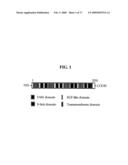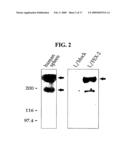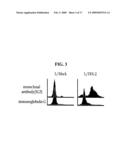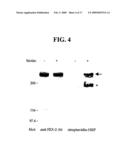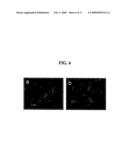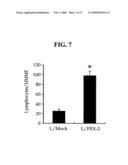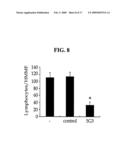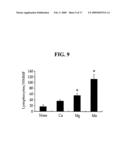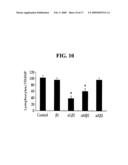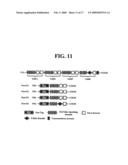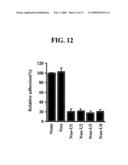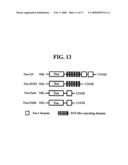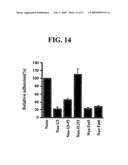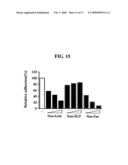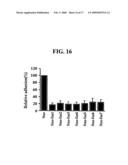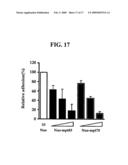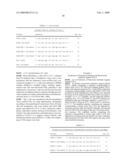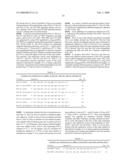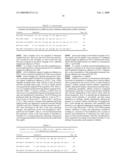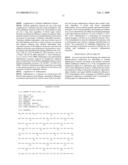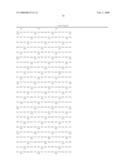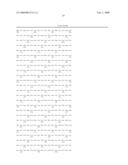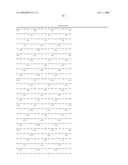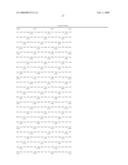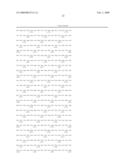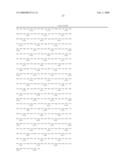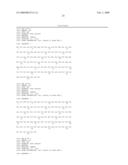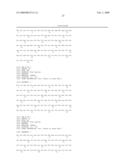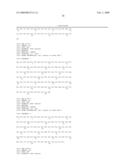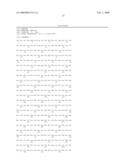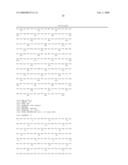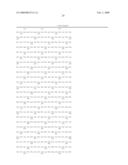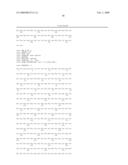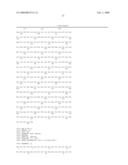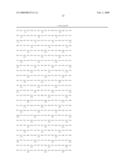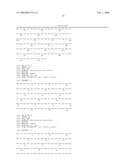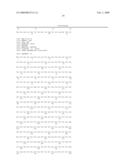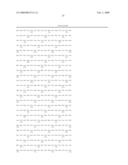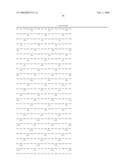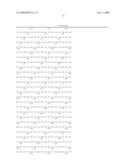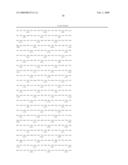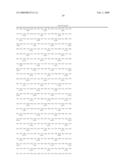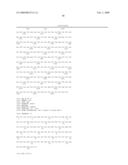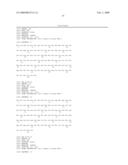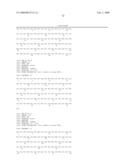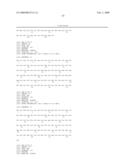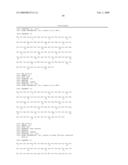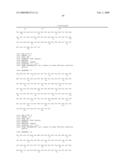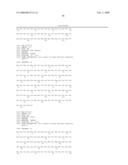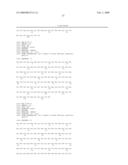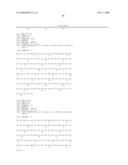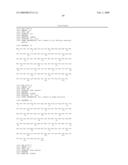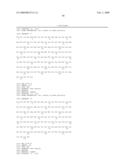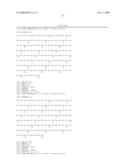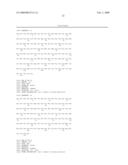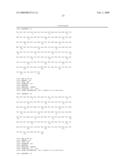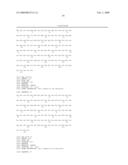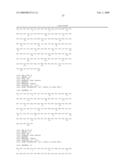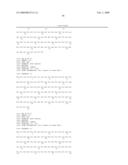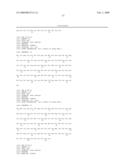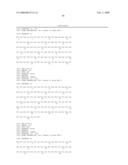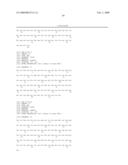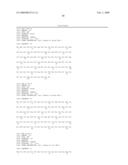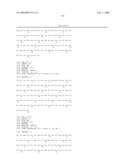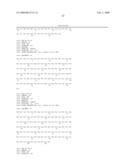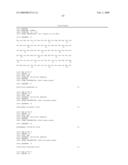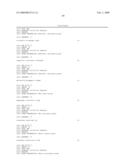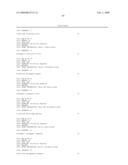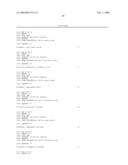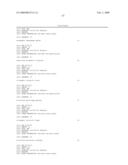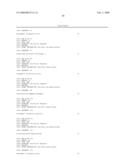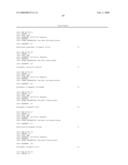Patent application title: Method and pharmaceutical composition for preventing or treating diseases associated with inflammation
Inventors:
In San Kim (Daegu, KR)
Seung-Yeon Park (Gyeongbuk, KR)
Mi-Yeon Jung (Daegu, KR)
IPC8 Class: AA61K39395FI
USPC Class:
4241411
Class name: Drug, bio-affecting and body treating compositions immunoglobulin, antiserum, antibody, or antibody fragment, except conjugate or complex of the same with nonimmunoglobulin material monoclonal antibody or fragment thereof (i.e., produced by any cloning technology)
Publication date: 2009-02-05
Patent application number: 20090035314
Claims:
1. A method for inhibiting lymphocyte adhesion to an endothelial cell,
which comprises administering to a subject in need thereof an inhibitor
against lymphocyte adhesion to a FEX-2 polypeptide.
2. The method according to claim 1, wherein the FEX-2 polypeptide is derived from a mammal.
3. The method according to claim 1, wherein the FEX-2 polypeptide comprises an amino acid sequence represented by SEQ ID NO: 1 or SEQ ID NO: 9.
4. The method according to claim 1, wherein the inhibitor against lymphocyte adhesion to a FEX-2 polypeptide is selected from the group consisting of polypeptide comprising fas-1 domains, anti-FEX-2 antibody, triple helix forming agent, ribozyme, double-stranded RNA homolog to a FEX-2 mRNA target molecule and an antisense nucleic acid of FEX-2 genes.
5. The method according to claim 4, wherein the fas-1 domain is derived from a mammal.
6. The method according to claim 5, wherein the mammal is selected from the group consisting of human being, rat and mouse.
7. The method according to claim 4, wherein the fas-1 domain is derived from a protein selected from the group consisting of FEX-2, mpt70, mpt83, βig-h3, periostin and FEX-1.
8. The method according to claim 7, wherein the polypeptide comprising fas-1 domains has an amino acid sequence selected from the group consisting of SEQ ID NO: 1 to SEQ ID NO: 66.
9. The method according to claim 8, wherein the polypeptide comprising fas-1 domains has an amino acid sequence selected from the group consisting of SEQ ID NO: 1 to SEQ ID NO: 14.
10. The method according to claim 4, wherein the anti-FEX-2 antibody is a polyclonal or a monoclonal antibody.
11. The method according to claim 10, wherein the monoclonal antibody is produced by a hybridoma (Accession No. KCTC 10639BP).
12. A method for preventing or treating an inflammatory disease, which comprises administering to a subject in need thereof an inhibitor against lymphocyte adhesion to a FEX-2 polypeptide.
13. The method according to claim 12, wherein the FEX-2 polypeptide is derived from a mammal.
14. The method according to claim 12, wherein the FEX-2 polypeptide comprises an amino acid sequence represented by SEQ ID NO: 1 or SEQ ID NO: 9.
15. The method according to claim 12, wherein the inhibitor against lymphocyte adhesion to a FEX-2 polypeptide is selected from the group consisting of polypeptide comprising fas-1 domain, anti-FEX-2 antibody, triple helix forming agent, ribozyme, double-stranded RNA homolog to a FEX-2 mRNA target molecule and an antisense nucleic acid of FEX-2 gene.
16. The method according to claim 15, wherein the fas-1 domain is derived from a mammal.
17. The method according to claim 16, wherein the mammal is selected from the group consisting of a human being, rat and mouse.
18. The method according to claim 15, wherein the fas-1 domain is derived from a protein selected from the group consisting of FEX-2, mpt70, mpt83, βig-h3, periostin and FEX-1.
19. The method according to claim 18, wherein the polypeptide comprising fas-1 domains has an amino acid sequence selected from the group consisting of SEQ ID NO: 1 to SEQ ID NO: 66.
20. The method according to claim 19, wherein the polypeptide comprising fas-1 domains has an amino acid sequence selected from the group consisting of SEQ ID NO: 1 to SEQ ID NO: 14.
21. The method according to claim 15, wherein the anti-FEX-2 antibody is a polyclonal or a monoclonal antibody.
22. The method according to claim 21, wherein the monoclonal antibody is produced by a hybridoma (Deposit No. KCTC 10639BP).
23. The method according to claim 12, wherein the inflammatory disease is selected from the group consisting of: inflammation, inflammatory bowl disease, diabetic ocular disease, peritonitis, osteomyelitis, cellulitis, meningitis, encephalitis, pancreatitis, trauma causing shock, bronchial asthma, rhinitis, sinusitis, otitis media, pneumonia, gastritis, enteritis, cystic fibrosis, apoplexy, bronchitis, bronchiolitis, hepatitis, nephritis, arthritis, gout, spondylitis, Reiter's syndrome, polyarteritis nodosa, hypersensitivity vasculitis, Wegener's granulomatosis, polymyalgia rheumatica, giant cell arteritis, calcium crystal deposition arthropathy, pseudogout, nonarticular rheumatism, bursitis, tenosynovitis, epicondylitis (Tennis elbow), neuropathic joint disease (Charcot's joint), hemarthrosis, Henoch-Schonlein Purpura, hypertrophic osteoarthropaihy, multicentric reticulohistiocytoma, scoliosis, hemochromoatosis, sickle cell disease and other hemoglobinopathies, hyperlipoproteinemia, hypogammaglobulinemia, hyperparathyroidism, acromegaly, familial mediterranean fever, Behcet's disease, systemic lupus erythematosus, relapsing fever, psoriasis, multiple sclerosis, septicemia, septic shock, acute respiratory distress syndrome, multiple organ failure, chronic obstructive pulmonary disease, acute lung injury and broncho-pulmonary dysplasia.
24. A pharmaceutical composition for inhibiting lymphocyte adhesion to endothelial cells, which comprises an inhibitor against lymphocyte adhesion to a FEX-2 polypeptide, and pharmaceutically acceptable carrier.
25. A pharmaceutical composition for preventing or treating an inflammatory disease, which comprises an inhibitor against lymphocyte adhesion to a FEX-2 polypeptide, and pharmaceutically acceptable carrier.
26. Use of an inhibitor against lymphocyte adhesion to FEX-2 polypeptide for the preparation of a medicament for inhibiting lymphocyte adhesion to endothelial cells.
27. Use of an inhibitor against lymphocyte adhesion to a FEX-2 polypeptide for the preparation of a medicament for preventing or treating an inflammatory disease.
28. A method for screening a medicament for inhibiting lymphocyte adhesion to an endothelial cell, which comprises the steps of:(a) pre-culturing cells expressing a FEX-2 polypeptide with or without a test agent;(b) adding lymphocytes to the cells pre-cultured with or without a test agent in the step (a) and further culturing them; and(c) measuring a degree of lymphocyte adhesion to the cells pre-cultured with a test agent, and comparing the measured degree with a degree of lymphocyte adhesion to the cells pre-cultured without a test agent, thereby determining whether the test agent inhibits lymphocyte adhesion.
29. A method for screening a medicament for preventing or treating an inflammatory disease, which comprises the steps of:(a) pre-culturing cells expressing a FEX-2 polypeptide with or without a test agent;(b) adding lymphocytes to the cells pre-cultured with or without the test agent in the step (a) and further culturing them;(c) measuring a degree of lymphocyte adhesion to the cells pre-cultured with the test agent, and comparing the measured degree with a degree of lymphocyte adhesion to the cells pre-cultured without a test agent, thereby determining whether the test agent inhibits lymphocyte adhesion; and(d) administering the test agent determined to inhibit lymphocyte adhesion in the step (c) to an animal suffering from an inflammatory disease to examine a therapeutic effect.
30. A method for screening a medicament for inhibiting lymphocyte adhesion to an endothelial cell, which comprises the steps of:(a) pre-culturing lymphocytes with or without a test agent;(b) adding the lymphocytes pre-cultured with or without the test agent in the step (a) to cells expressing FEX-2 polypeptide and further culturing them; and(c) measuring a degree of lymphocyte adhesion to the cells pre-cultured with the test agent, and comparing the measured degree with a degree of lymphocyte adhesion to the cells pre-cultured without the test agent, thereby determining whether the test agent inhibits lymphocyte adhesion.
31. A method for screening a medicament for preventing or treating an inflammatory disease, which comprises the steps of:(a) pre-culturing lymphocytes with or without a test agent;(b) adding the lymphocytes pre-cultured with or without the test agent in the step (a) to cells expressing FEX-2 polypeptide and further culturing them; and(c) measuring a degree of lymphocyte adhesion to the cells pre-cultured with the test agent, and comparing the measured degree with a degree of lymphocyte adhesion to the cells pre-cultured without the test agent, thereby determining whether the test agent inhibits lymphocyte adhesion; and(d) administering the test agent determined to inhibit lymphocyte adhesion in the step (c) to an animal suffering from an inflammatory disease to examine a therapeutic effect.
Description:
FIELD OF THE INVENTION
[0001]This application claims priority to Korean Patent Application No. 10-2004-81498, filed on Oct. 12, 2004, the contents of which are hereby incorporated by reference.
[0002]The present invention relates to a method and pharmaceutical composition for preventing or treating an inflammatory disease. More particularly, the present invention relates to a method for inhibiting lymphocyte adhesion to endothelial cells, or a method for treating an inflammatory disease, which comprises administering to a subject in need thereof an inhibitor against lymphocyte adhesion to a FEX-2 polypeptide. The present invention also relates to a pharmaceutical composition comprising the inhibitor against lymphocyte adhesion to a FEX-2 polypeptide, and the use of the inhibitor against lymphocyte adhesion to a FEX-2 polypeptide. Further, the present invention relates to a method for screening a medicament inhibiting lymphocyte adhesion to an endothelial cell or a medicament for treating inflammatory diseases, which comprises a step of selecting an inhibitor against lymphocyte adhesion to a FEX-2 polypeptide.
BACKGROUND OF THE INVENTION
[0003]Inflammation is referred to as a series of reactions in leukocytes for protecting tissues from pathogenic attacks and removing tissue debris produced by damaged tissues. Leukocytes are classified lymphocytes, monocytes and granulocytes (neutrophils, eosinophils and basophils).
[0004]Meanwhile, one of the most important steps for carrying out an inflammation reaction is movement of leukocytes from the circulatory system to an inflammation site or wound site. Such movement of leukocytes occurs via a multi-step process including interactions between leukocytes and endothelial cells in the postcapillary venules. In other words, leukocytes move to a site other than blood vessels through the sequential steps of capture, rolling, firm adhesion and transmigration between adjacent endothelial cells (Muller, W. A. wt al., Lab. Invest. 82:521-533, 2002). After leukocytes are adhered to endothelial cells through the above steps, they move from the cell surfaces to an inflammation site or wound site via intracellular junctions (Harlan J. M., Blood, 65: 513-525, 1985).
[0005]However, when such inflammatory reactions are controlled inadequately, various kinds of inflammatory diseases arise. General inflammatory diseases include: rhinitis and paranasal sinusitis, such as infectious rhinitis, allergic rhinitis, chronic rhinitis, acute paranasal sinusitis and chronic sinusitis; tympanitis such as acute suppurative tympanitis and chronic suppurative tympanitis; pneumonia such as bacterial pneumonia, bronchial pneumonia, lobar pneumonia, legionella pneumonia and viral pneumonia; enteritis such as acute or chronic gastritis, infectious enterocolitis, Crohn's disease, idiopathic ulcerative colitis and pseudomembranous colitis; arthritis such as suppurative arthritis, tuberculous arthritis, degenerative arthritis and rheumatoid arthritis; and diabetic ophthalmic disease.
[0006]It is known that leukocyte adhesion to vascular endothelial cells is mediated by cell adhesion molecule (CAM), in an inflammatory reaction. Besides the function of the CAM as a mediator for leukocyte-vascular endothelial cell adhesion, such cell adhesion molecule is essential to maintain or initiate specialized tissue structure and function, and is crucial to maintain homeostasis of the human body (Edelman, G. M., Annu. Rev Cell Bio., 2:81-116, 1986; Gumbiner, B. M., Cell, 84:345-357, 1996).
[0007]Cell adhesion molecules known to date include cadherin, integrin, selectin and immunoglobulin superfamily cell adhesion molecule (IgCAM) (Humphries, M. J. et al., Trends Cell Biol., 8:78-83, 1998). Among those, selectin is known for a calcium ion-dependent cell membrane-bonded lectin family, which initiates adhesion of leukocytes to platelets or endothelial cells (Lasky, Science 258: 964-969, 1992). Further, selectin is classified the following three types: L-selectin expressed in leukocytes, E-selectin expressed in cytokine active endothelial cells, and P-selectin expressed in thrombin active platelets and endothelial cells. Recently, many attempts have been made to develop an anti-inflammatory agent by using an inhibitor against the activity of a cell adhesion molecule such as selectin, which mediates leukocyte-endothelial cell adhesion and causes inflammation.
[0008]Korean Patent Publication No. 2004-0039440 discloses an inhibitor against selectin-mediated inflammation, Korean Patent No. 371784 discloses a humanized antibody reactive specifically to L-selectin, for use in treatment of an inflammatory disease.
[0009]Meanwhile, a fas-1 domain is a highly preservative sequence, which is found in secreted and membrane-anchored proteins of various species including mammals, insects, sea urchins, plants, yeasts and bacteria (Kawamoto T. et al., Biochim. Biophys, Acta, 288-292, 1998). Additionally, a fas-1 domain comprises about 110 to 140 amino acids. Particularly, a fas-1 domain comprises two subsets (H1 and H2), which comprise about 10 amino acids with high homogeneity and are highly preservative (Kawamoto, T. et al., Biochim. Biophys. Acta., 288292, 1998). Proteins comprising fas-1 domain include βig-h3, periostin, fasciclin I, sea urchin HLC-2, algal-CAM, and mycobacterium MPB70 (Huber, O. et al., EMBO J., 4212-4222, 1994; Matsumoto, S. et al., J. Immunol., 281-287, 1995; Talceshita, S. et al., Biochem. J., 271-278, 1993; Wang, W. C. et al., J. Biol. Chem., 1448-1455, 1993). Among those proteins, βig-h3, periostin and fasciclin I have four fas-1 domains, while HLC-2 has two fas-1 domains and MPB70 has only one fas-1 domain. Although biological functions of proteins comprising fas-1 domains are not clearly demonstrated, it is reported that several proteins function as cell adhesion molecules. Among such proteins, βig-h3 is reported to mediate cell adhesion in fibroblasts and epithelial cells, periostin is reported to mediate cell adhesion in osteoblasts, and fasciclin I is reported to mediate cell adhesion in nerve cells. (LeBaron, R. G. et al., J. Invest. Dermatol., 844-849, 1995; Horinchi, K. et al., J. Bone Miner. Res., 1239-1249, 1999; Wang, W. C. et al., J. Biol. Chem., 1448-1455, 1993). Additionally, algal-CAM is known to function as a cell adhesion molecule present in embryos of volvox (Huber, O. et al., EMBO J., 4212-4222, 1994).
[0010]As described above, although several proteins comprising fas-1 domains are known to function as cell adhesion molecules, all proteins are not cell adhesion molecules that contain fas-1 domains.
DETAILED DESCRIPTION OF THE INVENTION
Technical Problem
[0011]Therefore, the present inventors have conducted many studies to develop a novel therapeutic agent for treating inflammatory diseases and as a result, found that a FEX-2 polypeptide present in endothelial cells is a novel cell adhesion molecule, which mediates adhesion of lymphocytes. Based on this finding, we have demonstrated that a FEX-2 polypeptide-lymphocyte adhesion inhibitor can inhibit lymphocyte adhesion to endothelial cells, and thus is useful for treating inflammatory disease.
Technical Solution
[0012]Therefore, it is an object of the present invention to provide a method for inhibiting lymphocyte adhesion to an endothelial cell, which comprises administering to a subject in need thereof an inhibitor against lymphocyte adhesion to a FEX-2 polypeptide.
[0013]It is another object of the present invention to provide a method for preventing or treating an inflammatory disease, which comprises administering an inhibitor against lymphocyte adhesion to a FEX-2 polypeptide to a subject in need thereof.
[0014]It is still another object of the present invention to provide a pharmaceutical composition for inhibiting lymphocyte adhesion to an endothelial cell, which comprises an inhibitor against lymphocyte adhesion to a FEX-2 polypeptide and pharmaceutically acceptable carrier.
[0015]It is still another object of the present invention to provide a pharmaceutical composition for preventing or treating an inflammatory disease, which comprises an inhibitor against lymphocyte adhesion to a FEX-2 polypeptide and pharmaceutically acceptable carrier.
[0016]It is still another object of the present invention to provide the use of an inhibitor against lymphocyte adhesion to a FEX-2 polypeptide for the preparation of a medicament for inhibiting lymphocyte adhesion to an endothelial cell.
[0017]It is still another object of the present invention to provide the use of an inhibitor against lymphocyte adhesion to a FEX-2 polypeptide for the preparation of a medicament for preventing or treating an inflammatory disease.
[0018]It is still another object of the present invention to provide a method for screening a medicament inhibiting, lymphocyte adhesion to an endothelial cell, which comprises a step of determining whether a test agent inhibits lymphocyte adhesion to a FEX-2 polypeptide.
[0019]It is yet another object of the present invention to provide a method for screening a medicament for preventing or treating an inflammatory disease, which comprises a step of determining whether a test agent inhibits lymphocyte adhesion to a FEX-2 polypeptide.
[0020]To achieve the above objects, according to an aspect of the present invention, there is provided a method for inhibiting lymphocyte adhesion to an endothelial cell, which comprises administering to a FEX-2 polypeptide to a subject in need thereof an inhibitor against lymphocyte adhesion. According to another aspect of the present invention, there is provided a method for preventing or treating an inflammatory disease, which comprises administering to a FEX-2 polypeptide to a subject in need thereof an inhibitor against lymphocyte adhesion.
[0021]According to still another aspect of the present invention, there is provided a pharmaceutical composition for inhibiting lymphocyte adhesion to an endothelial cell, which comprises an inhibitor against lymphocyte adhesion to a FEX-2 polypeptide and pharmaceutically acceptable carrier.
[0022]According to still another aspect of the present invention, there is provided a pharmaceutical composition for preventing or treating inflammatory diseases, which comprises an inhibitor against lymphocyte adhesion to a FEX-2 polypeptide and pharmaceutically acceptable carrier.
[0023]According to still another aspect of the present invention, there is provided the use of an inhibitor against lymphocyte adhesion to a FEX-2 polypeptide for the preparation of a medicament for inhibiting lymphocyte adhesion to an endothelial cell.
[0024]According to still another aspect of the present invention, there is provided the use of an inhibitor against lymphocyte adhesion to a FEX-2 polypeptide for the preparation of a medicament for preventing or treating an inflammatory disease.
[0025]According to still another aspect of the present invention, there is provided a method for screening a medicament inhibiting lymphocyte adhesion to an endothelial cell, which comprises a step of determining whether a test agent inhibits lymphocyte adhesion to a FEX-2 polypeptide.
[0026]According to yet another aspect of the present invention there is provided a method for screening a medicament for preventing or treating an inflammatory disease, which comprises a step of determining whether a test agent inhibits lymphocyte adhesion to a FEX-2 polypeptide.
[0027]Hereinafter, the present invention will be explained in more detail.
[0028]Unless otherwise stated, all technical and scientific terms used herein have the same meanings as commonly understood by those ordinary skilled in the art. The following references provide one skilled in the art with general definitions of various terms and expressions used herein. Singleton et al., DICTIONARY OF MICROBIOLOGY AND MOLECULAR BIOLOGY (2d ed. 1994); THE CAMBRIDGE DICTIONARY OF SCIENCE AND TECHNOLOGY (Walker ed., 1988); and Hale & Marham, THE HARPER COLLINS DICTIONARY OF BIOLOGY. In addition, definitions of several technical terms are provided hereinafter to help readers.
[0029]As used herein, the term `polypeptide` used interchangeably with the terms `polypeptides` and `protein(s)` is referred to a polymer of amino acid residues, typically as found in proteins in nature.
[0030]As used herein, a FEX-2 polypeptide may be derived from a mammal, preferably from any one selected from the group consisting of human, rat and mouse. More preferably, a FEX-2 polypeptide is the human FEX-2 polypeptide represented by SEQ ID No:1 or mouse FEX-2 polypeptide represented by SEQ ID No:9. Most preferably, a FEX-2 polypeptide is the human FEX-2 polypeptide represented by SEQ ID No:1.
[0031]The above-mentioned FEX-2 polypeptide is gene cloned in a nucleotide database disclosed by the present inventors. It is experimentally demonstrated that a FEX-2 polypeptide is present in vascular endothelial cells and functions to mediate lymphocyte adhesion to vascular endothelial cells.
[0032]More particularly, based on the fact that proteins comprising fas-1 domains are found in cell adhesion molecules, the present inventors searched a partial human cDNAs comprising fas-1 domains from a known nucleotide database. Among the searched sequences, three cDNA sequences, whose characteristics are not yet identified were selected. Based on the cDNA sequences, primers were designed, and RT-PCR (reverse-transcription PCR) and 5' RACE PCR (rapid amplification of cDNA ends) were performed using the total RNA extracted from the human spleen, as a template, and the primers designed as described above. As a result, we cloned a novel human gene comprising fas-1 domains (see Example 1).
[0033]The gene synthesized by the present inventors as described above has seven fas-1 domains, twenty-three EGF-like domains, one X-link domain and one transmembrane domain (see FIG. 1). According to the above-described domain structure, the gene was designated as FEX-2 and the gene sequence was registered in GeneBank (AY311388). The human FEX-2 has an amino acid sequence represented by SEQ ID NO:1.
[0034]We examined FEX-2 for its expression on a cell surface, in order to determine whether the recombinant FEX-2 protein produced according to the present invention functions as a cell adhesion molecule.
[0035]To perform this, we constructed a recombinant vector comprising a human FEX-2 gene. Then, L cells (which are mouse fibroblasts) were transfected with the recombinant vector, and the transfectant was designated as L/FEX-2 (see Example 1). Next, polyclonal antibodies and a monoclonal antibody to the human FEX-2 individually generated. The antibodies were tested by the immunoblotting method to determine whether they can detect the expression of a FEX-2 in the human spleen tissues and L/FEX-2 cells (see Example 2). As a result, it could be seen that the FEX-2 antibodies according to the present invention can specifically detect the FEX-2 protein expressed in the human spleen tissues and L/FEX-2 cells (see FIG. 2).
[0036]Thus, we carried out FACS analysis and surface biotinylation assay by using the antibody specific to FEX-2 in order to determine whether FEX-2 is expressed on the L/FEX-2 cell surfaces (see Example 3). As a result, it could be seen that FEX-2 is expressed on the L/FEX-2 cell surfaces (see FIGS. 3 and 4).
[0037]Additionally, in order to determine which tissue is applied to the expression of FEX-2, we performed immunohistochemical staining by using the polyclonal human FEX-2 antibody to test the expression of FEX-2 in various human tissues (see Example 4). As a result, it could be seen that FEX-2 is expressed in sinusoidal endothelial cells of the human spleen (see FIG. 5). Also, FEX-2 is expressed in sinusoidal endothelial cells of the liver and lymph nodes (not shown). According to the above results, we estimated that FEX-2 can be expressed in vascular endothelial cells and interact with cells present in the blood.
[0038]Then, we examined lymphocyte adhesion to the L/FEX-2 cells, transfected to realize the expression of FEX-2 protein (see Example 5). As a result, it could be seen that a great number of lymphocytes are adhered to the L/FEX-2 cell surfaces compared to the cells used as a control (see FIGS. 6 and 7).
[0039]Additionally, we examined lymphocyte adhesion to the L/FEX-2 in the presence of an anti-FEX-2 antibody in order to determine whether the lymphocyte adhesion to the L/FEX-2 cell is caused by FEX-2 protein (see Example 6). As a result, it could be seen that lymphocyte adhesion to the L/FEX-2 cell is inhibited specifically by the anti-FEX-2 antibody (see FIG. 8). Finally, according to the above results, we concluded that FEX-2 functions as a cell adhesion molecule mediating lymphocyte adhesion.
[0040]Further, we identified cell, surface receptors to FEX-2 in order to characterize FEX-2 as a cell adhesion molecule in more detail.
[0041]To achieve this, according to one embodiment of the present invention, the effect of manganese, magnesium and calcium ions upon lymphocyte adhesion to FEX-2 was determined (see Example 7). As a result, it could be seen that lymphocyte adhesion to FEX-2 is enhanced by manganese ions at the highest degree, and by magnesium ions at the second highest degree. However, calcium ions cannot enhance lymphocyte adhesion to FEX-2 (see FIG. 9). It could be seen from the above results that a cell surface receptor to FEX-2 requires the above divalent cations for the interaction with a ligand. Such a characteristic of the cell surface receptor to FEX-2 is the same as that of the integrin receptor that is bounded to a ligand in a cell adhesion mechanism.
[0042]Then, we identified integrin receptors mediating lymphocyte adhesion to FEX-2 (see Example 7). As a result, it could be seen that αLβ2 integrin and αMβ2 integrin interact with FEX-2, and thus participate in the lymphocyte adhesion (see FIG. 10).
[0043]From the above results, we have demonstrated for the first time that FEX-2 is present in vascular endothelial cells and has the activity of mediating lymphocyte adhesion to vascular endothelial cells through the interaction between FEX-2 and αLβ2 integrin or αMβ2 integrin of lymphocytes.
[0044]Further, we have studied to determine which segment of FEX-2 is related directly with lymphocyte adhesion, and tested whether a polypeptide comprising a segment of FEX-2 related with lymphocyte adhesion can be used as an inhibitor against lymphocyte adhesion to FEX-2.
[0045]To perform this, according to another embodiment of the present invention, we divided FEX-2 protein into four subunits and prepared recombinant protein for each subunit (see FIG. 11). Next, we pre-cultured lymphocytes with the subunits, and cultured L/FEX-2 cells expressing FEX-2 with the lymphocytes added thereto.
[0046]Then, we determined a degree of lymphocyte adhesion to FEX-2 (see Example <8-1>). As a result, it could be seen that lymphocyte adhesion to FEX-2 is highly inhibited when lymphocytes are pre-cultured with the subunits and are added to L/FEX-2 cells (see FIG. 12).
[0047]Further, we divided the third subunit of FEX-2 protein, i.e. Nus-U3 into three segments, and prepared a polypeptide comprising the third EGF-like repeating domain of FEX-2 (Nus-EGF3) and polypeptides each comprising the fifth fas-1 domain and the sixth fas-1 domain (Nus-Fas5 and Nus-Fas6, respectively) (see FIG. 13). Next, lymphocytes were pre-cultured with the polypeptides and were added to L/FEX-2 cells to examine a degree of lymphocyte adhesion to FEX-2 (see Example 8). As a result, when Nus-fas5 and Nus-fas6 polypeptides comprising a fas-1 domain were pre-cultured with lymphocytes, it was possible to inhibit lymphocyte adhesion to L/FEX-2 cells. However, it was not possible to inhibit lymphocyte adhesion in the case of a polypeptide comprising an EGF-like repeating domain (see FIG. 14).
[0048]According to still another embodiment of the present invention, we examined a degree of lymphocyte adhesion to FEX-2 protein by pre-culturing lymphocytes with various concentrations of the polypeptide comprising fas-1 domains, and adding the lymphocytes to L/FEX-2 cells (see Example 9). It was shown that inhibition against lymphocyte adhesion to FEX-2 increases as the concentration of the polypeptide increases (see FIG. 15).
[0049]Thus, it could be seen from the above results that when lymphocytes are pre-cultured with the polypeptide comprising fas-1 domains, the fas-1 domains are adhered to lymphocytes and serve as competitors against the FEX-2 protein expressed by the L/FEX-2 cells. Therefore, it was demonstrated that fas-1 domains of FEX-2 protein are adhered to lymphocytes, and a polypeptide comprising fas-1 domains is an inhibitor against lymphocyte adhesion to FEX-2 protein.
[0050]Further, we examined whether polypeptides comprising seven fas-1 domains present in the human FEX-2 protein and polypeptides comprising fas-1 domains present in other proteins than the human FEX-2 protein, i.e. M. tuberculosis proteins mpt83 and mpt70 can inhibit lymphocyte adhesion to FEX-2 protein (see Example 10). As a result, it could be seen that all of the polypeptides comprising seven fas-1 domains present in FEX-2 protein have the effect of inhibiting lymphocyte adhesion to FEX-2 (FIG. 16). Further, the polypeptides comprising fas-1 domains present in M. tuberculosis proteins mpt83 and mpt70 have the effect of inhibiting lymphocyte adhesion to FEX-2, wherein the lymphocyte adhesion-inhibiting activity depends on the concentration of a polypeptide (see FIG. 17).
[0051]As described above, according to the present invention, it was demonstrated for the first time that FEX-2 has the activity of mediating lymphocyte adhesion to vascular endothelial cells through the interaction between FEX-2 and αLβ2 integrin or αMβ2 integrin of lymphocytes. Further, it was shown that lymphocyte adhesion to endothelial cells is inhibited by an inhibitor against lymphocyte adhesion to FEX-2 polypeptide.
[0052]Therefore, the present invention provides a method for inhibiting lymphocyte adhesion to endothelial cells, which comprises administering to a subject in need thereof an inhibitor against lymphocyte adhesion to a FEX-2 polypeptide. Such lymphocyte adhesion to endothelial cells is characterized in that it is mediated by cell adhesion molecules comprising fas-1 domains, preferably by a FEX-2 polypeptide.
[0053]Meanwhile, an inflammatory reaction occurs when lymphocytes adhere to vascular endothelial cells and then move to an inflammatory site. Herein, if lymphocyte adhesion to a cell adhesion molecule present in vascular endothelial cells is inhibited, it is possible to inhibit the movement of lymphocytes to an inflammatory site, and thus to inhibit an inflammatory reaction (Ulbrich, H. et al., Trends Pharmacol. Sci. 24:640-647, 2003; Harlan, J. M. et al., Crit. Care Med. 30(5 Suppl):S214-219, 2002; van Assche, G. et al., Inflamm. Bowel Dis. 8:291-300, 2002). Accordingly, inhibition against lymphocyte adhesion to FEX-2, which is a cell adhesion molecule present in vascular endothelial cells, results in inhibition against the movement of lymphocyte to an inflammatory site and inflammatory reaction.
[0054]Therefore, the present invention provides a method for preventing or treating an inflammatory disease, which comprises administering to a subject in need thereof an inhibitor against lymphocyte adhesion to a FEX-2 polypeptide.
[0055]As used herein, the term "subject" means an animal, particularly a mammal, The subject may be a cell, tissue or organ derived from an animal.
[0056]As used herein, the term "an inhibitor against lymphocyte adhesion to a FEX-2 polypeptide" is referred to as a compound that is bonded with a FEX-2 polypeptide to inhibit lymphocyte adhesion, or bounded with lymphocyte to inhibit the lymphocyte adhesion to FEX-2, or a compound that inhibits expression of gene encoding FEX-2 protein.
[0057]More particularly, the compound that inhibits FEX-2 protein-lymphocyte adhesion includes a peptide, polypeptide, protein, peptide mimic, compound and a biological agent, but is not limited to.
[0058]Preferably, the compound that is bounded with FEX-2 to inhibit lymphocyte from being bounded with FEX-2 includes an anti-FEX-2 antibody. Additionally, the compound that is bounded with lymphocyte to inhibit the lymphocyte from being bonded with FEX-2 includes a polypeptide comprising fas-1 domains.
[0059]Particularly, the polypeptide comprising fas-1 domains may be derived from a mammal, preferably from any one selected from the group consisting of a human being, rat and mouse. The polypeptide comprising fas-1 domains according to the present invention can utilize fas-1 domains derived from all kinds of proteins known to contain fas-1 domains. Therefore, the fas-1 domain according to the present invention may be a fas-1 domain that can be searched out from a protein sequence database known to one skilled in the art (for example, NCBI Entrez (http://www.ncbi.nlm.nih.gov/Entrez/), EMBL-EBI (http://www.ebi.ac.uk/) or SMART (http://smart.embl-heidelberz.de/).
[0060]Preferably, a polypeptide used in the present invention may be comprising fas-1 domains derived from a protein selected from the group consisting of FEX-2, mpt70, mpt83, βig-h3, periostin and FEX-1. More preferably, a polypeptide used in the present invention may be a polypeptide comprising fas-1 domains of human FEX-2, represented by SEQ ID NO: 1 to SEQ ID NO: 12; a polypeptide comprising fas-1 domains derived from M. tuberculosis proteins mpt83 and mpt70, represented by SEQ ID NO: 13 and SEQ ID NO: 14; a polypeptide comprising fas-1 domains derived from mouse FEX-2, represented by SEQ ID NO: 15 to SEQ ID NO: 21; a polypeptide comprising fas-1 domains derived from rat FEX-2, represented by SEQ ID NO: 22 to SEQ ID NO: 25; a polypeptide comprising fas-1 domains derived from human βig-h3 represented by SEQ ID NO: 26 to SEQ ID NO: 29; a polypeptide comprising fas-1 domains derived from mouse βig-h3, represented by SEQ ID NO: 30 to SEQ ID NO: 33; a polypeptide comprising fas-1 domains derived from rat βig-h3, represented by SEQ ID NO: 34 and SEQ ID NO: 35; a polypeptide comprising fas-1 domains derived from human periostin, represented by SEQ ID NO: 36 to SEQ ID NO: 39; a polypeptide comprising fas-1 domains derived from mouse periostin, represented by SEQ ID NO: 40 to SEQ ID NO: 43; a polypeptide comprising fas-1 domains derived from rat periostin, represented by SEQ ID NO: 44 to SEQ ID NO: 47; a polypeptide comprising fas-1 domains derived from human FEX-1, represented by SEQ ID NO: 48 to SEQ ID NO: 54; a polypeptide comprising fas-1 domains derived from mouse FEX-1, represented by SEQ ID NO: 55 to SEQ ID NO: 60; or a polypeptide comprising fas-1 domains derived from rat FEX-1, represented by SEQ ID NO: 61 to SEQ ID NO: 66. Most preferably, a polypeptide used in the present invention may be a polypeptide comprising fas-1 domains of human FEX-2, represented by SEQ ID NO: 1 to SEQ ID NO: 12; or a polypeptide comprising fas-1 domains derived from M. tuberculosis proteins mpt83 and mpt70, represented by SEQ ID NO: 13 and SEQ ID NO: 14. Additionally, such fas-1 domains derived from fas-1 domain-comprising proteins may be used alone or in combination.
[0061]Additionally, the range "polypeptide comprising fas-1 domains" also includes a functional equivalent of fas-1 domain and salts thereof. Herein, the term "functional equivalent" is referred to as a polypeptide showing the substantially same physiological activity as fas-1 domain. In other words, an amino acid sequence as well as a structurally equivalent or similar polypeptide may be used in the present invention, as long as it shows the same physiological activity as the polypeptide according to the present invention. The term "substantially the same physiological activity" means the activity of inhibiting lymphocyte adhesion to a cell adhesion molecule, FEX-2. More particularly, the above term means the activity of inhibiting lymphocyte adhesion to FEX-2 through the interaction with αLβ2 integrin or αMβ2 integrin of lymphocytes.
[0062]Additionally, as used herein, the range of functional equivalent includes a polypeptide derivative that maintains the fundamental skeleton and physiological activity of the polypeptide according to the present invention and has a modified chemical structure. For example; the functional equivalent includes a polypeptide having a structure modified so as to change stability, storage stability, volatility or solubility of the polypeptide.
[0063]The polypeptide comprising fas-1 domains according to the present invention may be obtained with ease by a chemical synthesis process known to one skilled in the art (Creightion, Proteins; Structures and Molecular Principles, W. H. Freeman and Co., NY, 1983). Typical examples of the process include a liquid or solid phase process, fragment condensation process, F-BOC or a T-MOC chemical process (Chemical Approaches to the Synthesis of Peptides and Proteins, Williams et al., Eds., CRC Press, Boca Raton Fla., 1997; A Practical Approach, Athert on & Sheppard, Eds., IRL Press, Oxford, England, 1989), but are not limited to.
[0064]Further, the polypeptide comprising fas-1 domains may be produced by a biotechnological process. In other words, a DNA sequence encoding the polypeptide is provided in a conventional manner. The DNA sequence may be prepared by PCR amplification using adequate primers. In a different method, for example, the DNA sequence may be produced by using an automatic DNA producing instrument known to one skilled in the art (available from Biosearch or Applied Biosystems Co.). Then, the DNA sequence is inserted into a vector comprising at least one expression control sequence (e.g. promotor, enhancer, etc.) that is operatively linked to the DNA sequence to control the expression of the DNA sequence, and the resultant recombinant expression vector is used to transfect a host cell. The transfected cell is cultured in a suitable medium under suitable conditions sufficient to realize expression of the DNA sequence. Then, substantially pure polypeptide encoded by the DNA sequence is obtained from the cultured product. The obtainment step may be performed by a conventional method (e.g. chromatography). Herein, the expression "substantially pure polypeptide" is referred to as the polypeptide according to the present invention, which does not comprise any other proteins derived from the host cell. The following references provide detailed description of a biotechnological process for producing the polypeptide according to the present invention: Maniatis et al., Molecular Cloning; A laboratory Manual, Cold Spring Harbor laboratory, 1982; Sambrook et al., supra; Gene Expression Technology, Method in Enzymology, Genetics and Molecular Biology, Method in Enzymology, Guthrie & Fink (eds.), Academic Press, San Diego, Calif., 1991; and Hitzeman et al., J. Biol. Chem., 255:12073-12080, 1990.
[0065]According to the present invention, the anti-FEX-2 antibody may be a polyclonal or a monoclonal antibody. The antibody according to the present invention may be produced via a conventional method known to the field of immunology by using FEX-2 protein as an antigen.
[0066]The polyclonal antibody may be produced in a conventional manner from various homoiothermal animals including horses, cows, goats, sheep, dogs, chickens, turkeys, rabbits, mice or rats. In other words, an antigen is injected through an intraperitoneal, intramuscular, intraocular or subcutaneous route to immunize an animal. Immunity against the antigen may be increased by using an adjuvant such as the Freund complete adjuvant or incomplete adjuvant. After the booster immunization, a small sample of blood sera is collected and tested for reactivity to a target antigen. If a titer of the animal reaches the plateau when viewed from the reactivity to the antigen, a large amount of polyclonal immunosera can be obtained through weekly bleeding of the animal or phlebotomy of the animal.
[0067]Also, the monoclonal antibody may be produced by a conventional process (Kennettm McKearn, and Bechtbl (eds.), Monoclonal Antibodies, Hybridomas; A New Dimension in Biological Analyses, Plenum Press, 1980). The monoclonal antibody may be produced by a process comprising the steps of: immunizing an animal by using FEX-2 protein as an immunogen; generating hybridoma cells by fusing the spleen cells of the immunized animal with myeloma cells; selecting a hybridoma that recognizes FEX-2 protein selectively; culturing the selected hybridoma; and separating an antibody from the hybridoma culture. Additionally, the monoclonal antibody according to the present invention may be produced by injecting the hybridoma generating the anti-FEX-2 antibody that recognizes FEX-2 protein selectively into an animal, and then isolating the antibody from the ascites collected from the animal after the lapse, of a time.
[0068]Hybridoma 5G3 producing the monoclonal human FEX-2 antibody, obtained according to one embodiment of the present invention, was deposited in one of the international depository authorities, i.e. the Korean Collection for Type Cultures (KCTC) located within the biological resources center of the Korea Research Institute of Bioscience and Biotechnology (52, Eoeun-dong, Yuseong-ku, Taecheon, Korea) as the Accession No. KCTC-10639BP on May 21, 2004. The antibody deposited as described above may be maintained alive for the total period of the issued patent by keeping it in the KCTC, and may be available for any person or entity for the non-commercial purpose with no limitation according to the provisions of the Deposit Management Law.
[0069]In addition, the compound that inhibits expression of genes encoding FEX-2 protein includes a substance that inhibits transcription of the genes or translation of the genes into proteins. Such inhibition against expression of genes includes not only complete termination of gene expression but also reduction of gene expression.
[0070]A typical example of the substance that inhibits expression of genes encoding FEX-2 protein is an antisense molecule capable of inhibiting expression of specific intrinsic genes. The actions of the antisense molecule to inhibit the expression of a target gene include: the inhibition of transcription initiation, by the formation of a triple-chain structure; the transcriptional inhibition by the hybrid formation at the site where a local opened loop structure was made by RNA polymerase; the transcription inhibition by the hybrid formation at the RNA being synthesized; splicing inhibition by the hybrid formation at an intron-exon junction; the splicing inhibition by the hybrid formation at a splicosome-forming site; the inhibition of migration from a nucleus to cytoplasm by the hybrid formation with mRNA; and the inhibition of translation initiation by the hybrid formation at a translation initiator-binding site. Such antisense molecules inhibit a process of transcription, splicing or translation, and thus inhibit the expression of a target gene.
[0071]The antisense molecule used in the present invention may inhibit the expression of a target gene by any of the above action. Typical antisense molecules include a triple helix forming agent, ribozyme, RNAi or an antisense nucleic acid. The triple helix forming agent is circularized around a double-strand DNA to form a triple helix, thereby inhibiting transcription initiation (Maher et al., Antisense Res. and Dev., 1(3):227, 1991; Helene, C., Anticancer Drug Design, 6(6):569, 1991).
[0072]The ribozyme is an enzyme capable of cleavage of a single-strand RNA.
[0073]The ribozyme recognizes a specific nucleotide sequence in a target RNA molecule and cleaves the sequence in a site-specific manner, thereby inhibiting the protein expression of the target genes (Cech, J. Amer. Med. Assn., 260:3030, 1998; Sarver et al., Science 247:1222-1225, 1990).
[0074]The RNAi (RNA interference) is a method for inhibiting gene expression in a transcription level or post-transcription level by using a hairpin-shape small molecule RNA, which acts in a sequence-specific manner (Mette et al., EMBO J., 19: 5194-5201, 2000). The small molecule RNA used in the RNAi method is a double-strand RNA molecule homologous to the target gene.
[0075]Herein, the RNA molecule may be produced by a conventional chemical or enzymatic process. For example, the RNA molecule may be produced by a chemical process disclosed in the art (Verma and Eckstein, Annu. Rev. Biochem. 67, 99-134, 1999). An enzymatic process for producing an RNA molecule by using an RNA polymerase such as a phage T7, T3 or SP6 polymerase is described in (Milligan and Uhlenbeck, Methods Enzymol. 180:51-62, 1989).
[0076]The antisense nucleic acid is referred to as a DNA or RNA molecule at least partially complementary to the target mRNA molecule (Weintraub, Scientific American, 262:40, 1990). From the intracellular point of view, the antisense nucleic acid is hybridized with mRNA corresponding thereto to form a double-strand molecule, thereby inhibiting decoding of mRNA of the target gene and protein expression (Marcus-Sakura, Anal. Biochem., 172:289, 1988). Such antisense nucleic acids are particularly useful for the inhibitor against the expression of FEX-2 according to the present invention, Preferably, the antisense nucleic acid may be produced in the form of an oligonucleotide by a suitable method known to one skilled in the art. More particularly, the antisense oligonucleotide may be produced by a chemical process, for example by the chemical phosphoamidite method comprising sulfuration with tetraethylthiuram disulfide in acetonitrile (Tetrahedron Lett., 1991, 32, 30005-30008).
[0077]Inflammatory diseases that can be prevented or treated by the method according to the present invention include an inflammatory reaction itself or various diseases caused by inflammatory reactions. Particular non-limiting examples of the inflammatory diseases include: inflammation, inflammatory bowl disease, diabetic ocular disease, peritonitis, osteomyelitis, cellulitis, meningitis, encephalitis, pancreatitis, trauma causing shock, bronchial asthma, rhinitis, sinusitis, otitis media, pneumonia, gastritis, enteritis, cystic fibrosis, apoplexy, bronchitis, bronchiolitis, hepatitis, nephritis, arthritis, gout, spondylitis, Reiter's syndrome, polyarteritis nodosa, hypersensitivity vasculitis, Wegener's granulomatosis, polymyalgia rheumatica, giant cell arteritis, calcium crystal deposition arthropathy, pseudogout, nonarticular rheumatism, bursitis, tenosynovitis, epicondylitis (Tennis elbow), neuropathic joint disease (Charcot's joint), hemarthrosis, Henoch-Schonlein Purpura, hypertrophic osteoarthropathy, multicentric reticulohistiocytoma, scoliosis, hemochromoatosis, sickle cell disease and other hemoglobinopathies, hyperlipoproteinemia, hypogammaglobulinemia, hyperparathyroidism, acromegaly, familial mediterranean fever, Behcet's disease, systemic lupus erythematosus, relapsing fever, psoriasis, multiple sclerosis, septicemia, septic shock, acute respiratory distress syndrome, multiple organ failure, chronic obstructive pulmonary disease, acute lung injury and broncho-pulmonary dysplasia.
[0078]According to another aspect of the present invention, the present invention provides a pharmaceutical composition for inhibiting lymphocyte adhesion to endothelial cells, which comprises an inhibitor against lymphocyte adhesion to a FEX-2 polypeptide and pharmaceutically acceptable carrier.
[0079]The present invention also provides a pharmaceutical composition for preventing or treating inflammatory disease, which comprises an inhibitor against lymphocyte adhesion to a FEX-2 polypeptide and pharmaceutically acceptable carriers.
[0080]As used herein, the term "pharmaceutically acceptable carrier" is referred to as a composition that is physiologically acceptable and does not cause any allergic reactions or similar reactions such as gastrointestinal disorders or vertigos, when administered to the human body. The pharmaceutically acceptable carriers may include, for example, oral carrier, and parenteral administration carrier. The oral carrier may include lactose, starch, cellulose derivatives, magnesium stearate, and stearic acid. Also, the parenteral carrier may include water, suitable oil, saline solution, aqueous glucose and glycol. The composition according to the present invention may further comprise stabilizer and preservative. Suitable stabilizer includes antioxidant, such as sodium bisulfite, sodium sulfite or ascorbic acid. Suitable preservative includes benzalkonium chloride, methyl- or propyl-paraben, and chlorobutanol. For other pharmaceutically acceptable carriers, reference may be made to the following literature (Remington's Pharmaceutical Sciences, 19th ed., Mack Publishing Company, Easton, Pa., 1995).
[0081]The pharmaceutical composition according to the present invention may be mixed with the pharmaceutically acceptable carriers as described above and formulated into an adequate form by means of a process known to one skilled in the art. In other words, the pharmaceutical composition according to the present invention may be formulated into various forms for oral or parenteral administration by a conventional process known to one skilled in the art. The formulations for parenteral administration preferably include injection formulations, such as isotonic aqueous solution or suspension formulations. The injection formulations may be prepared by using suitable dispersing or wetting agents, and suspending agents, according to any technique known in the art. For example, formulations for injection may be obtained by dissolving necessary components in a saline or buffer solution. Examples of the formulations for oral administration include powder, granule, tablet, pill and capsule, but are not limited to.
[0082]The pharmaceutical composition formulated as described above may be administered in an effective amount through various routes including oral, transdermal, subcutaneous, intravenous and intramuscular routes. The term "effective amount" is referred to as the amount of a compound or extract that shows a preventive or therapeutic effect. The dose of the inventive pharmaceutical composition may be suitably selected according to an administration route, a subject to be administered, and the age, sex, body weight, characteristic and disease condition of the subject. Preferably, the pharmaceutical composition comprising the polypeptide according to the present invention may be administered to an adult at an effective unit dose ranging from about 10 μg to 10 mg, one time or several times per day. However, the effective dose may be varied depending on the severity of diseases.
[0083]Also, the present invention provides the use of an inhibitor against lymphocyte adhesion to a FEX-2 polypeptide for the preparation of a medicament for inhibiting lymphocyte adhesion to endothelial cells.
[0084]Also, the present invention provides the use of an inhibitor against lymphocyte adhesion to a FEX-2 polypeptide for the preparation of a medicament for preventing or treating inflammatory diseases.
[0085]Further, the present invention provides a method for screening a medicament for inhibiting lymphocyte adhesion to a FEX-2 polypeptide.
[0086]More particularly, when a test agent functions specifically to the cells expressing FEX-2, the screening method according to the present invention comprises the steps of:
[0087](a) pre-culturing cells expressing a FEX-2 polypeptide with or without a test agent;
[0088](b) adding lymphocytes to the cells pre-cultured with or without the test agent in the step (a) and further culturing them; and
[0089](c) measuring a degree of lymphocyte adhesion to the cells pre-cultured with the test agent, and comparing the measured degree with a degree of lymphocyte adhesion to the cells pre-cultured without the test agent, thereby determining whether the test agent inhibits lymphocyte adhesion.
[0090]Additionally, when a test agent functions specifically to lymphocytes, the screening method according to the present invention comprises the steps of:
[0091](a) pre-culturing lymphocytes with or without a test agent;
[0092](b) adding the lymphocytes pre-cultured with or without the test agent in the step (a) to cells expressing FEX-2 polypeptide and further culturing them; and
[0093](c) measuring a degree of lymphocyte adhesion to the cells pre-cultured with the test agent, and comparing the measured degree with a degree of lymphocyte adhesion to the cells pre-cultured without the test agent, thereby determining whether the test agent inhibits lymphocyte adhesion.
[0094]Further, the present invention provides a method for screening a medicament for preventing or treating inflammatory diseases.
[0095]According to the present invention, the method for screening a medicament for preventing or treating an inflammatory disease further comprises step (d) of administering the test agent determined to inhibit lymphocyte adhesion in the step (c) to an animal suffering from an inflammatory disease to examine a therapeutic effect, in addition to the above steps (a) to (c) of the method for screening a medicament for inhibiting lymphocyte adhesion to a FEX-2 polypeptide.
[0096]In the above method, the animal is preferably a non-human animal. Additionally, the term "therapeutic effect" used in describing the step (d) means the effect of alleviating or improving an inflammatory disease and or the effect of inhibiting the progress of inflammatory disease.
[0097]As used herein, the term "agent" or "test agent" includes any substances, molecules, elements, compounds, entities or combinations thereof. Particular examples thereof include, but are not limited to, proteins, polypeptides, small organic molecules, polysaccharides and polynucleotides. Also, the test agent may be a natural product, synthetic product, chemical compound or a combination thereof. Unless otherwise indicated, the terms "agent", "substance" and "compound" may be interchangeable.
[0098]The test agents that can be screened or identified by the inventive methods include polypeptides, beta-turn mimetics, polysaccharides, phospholipids, hormones, prostaglandins, steroids, aromatic compounds, heterocyclic compounds, benzodiazepines, oligomeric N-substituted glycines, oligocarbamates, saccharides, fatty acids, purines, pyrimidines, or derivatives, structural analogs or combinations thereof. Some test agents may be synthetic molecules and others natural molecules. The test agent may be available from various sources including libraries of synthetic or natural compounds. A combinatorial library may be produced from various kinds of compounds that can be synthesized in a step-by-step manner. A plurality of compounds in combinatorial libraries may be produced by the ESL (encoded synthetic libraries) method (WO 95/12608, WO-93/06121, WO 94/08051, WO 95/395503 and WO 95/30642). Libraries of natural compounds present in the form of extracts of bacterial, fungal, plant and animal are commercially available or can be obtained in the field. Additionally, known pharmacological agent can be subjected to a directed or random chemical modification, including acylation, alkylation, esterification and amidification, so as to obtain its structural analogs. Also, the test agent may be a naturally occurring protein or a fragment thereof. Such test agents may be obtained from a natural source such as a cell, or tissue lysate. Libraries of a polypeptide preparation may be obtained from cDNA libraries that are produced by a conventional method or are commercially available. The test agent may be a peptide (for example a peptide having about 5-30, preferably about 5-20, more preferably about 7-15 amino acids). The peptide may be a cleaved product of naturally occurring proteins, random peptides or biased random peptides.
[0099]The test agent may also be a "nucleic acid". The nucleic acid test agent may be a naturally occurring nucleic acid, random nucleic acid or biased random nucleic acid. For example, a cleaved product of procaryotic or eukaryotic genomes may be used in a similar manner.
[0100]The test agent may also be a small molecule (e.g. a molecule having a molecular weight of about 1,000 or less). As a method for screening an agent for controlling such small molecules, a high throughput assay may be used preferably. As described above, combinatorial libraries of small molecule test agents may be applied to the screening method according to the present invention. Several assay systems are useful for the screening method (Shultz, Bioorg. Med. Chem. Lett., 8:2409-2414, 1998; Weller, Mol. Drivers., 3:61-70, 1997; Fernandes, Curr. Opin. Chem. Biol., 2:597-603, 1998; and Sittampalam, Curr. Opin. Chem. Biol., 1:384-91, 1997).
[0101]As used herein, the term "cells expressing FEX-2 polypeptide" is referred to as cells transfected with a vector comprising the genes encoding a FEX-2 polypeptide. Although there is no particular limitation in the cells, it is preferable that the cells have no additional cell adhesion molecules other than a FEX-2 polypeptide. For example, the cells include mouse fibroblasts, L cells. Besides the mouse L cells, it may be used Chinese hamster ovary cells (CHO), mouse sarcoma cells S180 and Drosophila S2 cells.
[0102]The vector comprising the genes encoding a FEX-2 polypeptide may be produced with ease by producing cDNA from a known FEX-2 genetic sequence through a known method, and cloning the cDNA to a suitable vector. For example, the expression vector may be pcDNA-Fex2.
[0103]Preferably, lymphocytes used in the above method are marked with a fluorescence dye. Any fluorescence dye may be used, as long as it causes lymphocytes to be dyed via diffusion into cell membranes and it can be observed with a fluorescence microscope.
[0104]The degree of lymphocyte adhesion to the transfected cells can be measured by counting the number of lymphocytes adhered to the transfected cells with an optical microscope. Otherwise, it can be measured by culturing lymphocytes along with the transfected cells, carrying out lysis of the cells with a cell lysis buffer solution to provide a lysate, and determining the fluorescence of the lysate.
[0105]When the number of lymphocytes is counted by using a microscope, lymphocytes are cultured along with the transfected cells, and non-adhered lymphocytes are washed out. Then, the number of lymphocytes is counted by using a microscope at randomly selected 10 positions, and the 10 measurements are averaged.
[0106]When the fluorescence of the cell lysate is measured, lymphocytes are cultured along with the transfected cells, and non-adhered lymphocytes are washed out. Then, the cell lysate obtained by adding a cell lysis buffer solution was determined for the amount of fluorescence by using a fluorescence microplate reader.
[0107]The foregoing and other objects, features and advantages of the present invention will become more apparent from the following detailed description when taken in conjunction with the accompanying drawings.
BRIEF DESCRIPTION OF THE DRAWINGS
[0108]FIG. 1 is a schematic view showing each domain of the human FEX-2 protein.
[0109]FIG. 2 shows the results of Western blot assay for the expression of FEX-2 protein in the human spleen tissue, L/FEX-2 cells and L/Mock cells using the monoclonal human FEX-2 antibody.
[0110]FIG. 3 shows the results of FACS (fluorescence activated cell sorter) analysis for the expression of FEX-2 protein on the surface of L/Mock cells and L/FEX-2 cells using the monoclonal human FEX-2 antibody.
[0111]FIG. 4 shows the results of surface biotinylation analysis for the expression of FEX-2 protein on the surface of L/FEX-2 cells (-: no addition, +: addition).
[0112]FIG. 5 shows the results of immunostaining using the polyclonal human FEX-2 antibody in the human spleen tissue (a: control, b: test sample).
[0113]FIG. 6 is a photograph taken by a microscope, which shows a degree of lymphocyte adhesion in L/Mock cells and L/FEX-2 cells (a: L/Mock cells, b: L/FEX-2 cells, arrow heads: lymphocytes).
[0114]FIG. 7 is a graph showing a degree of lymphocyte adhesion in L/Mock cells and L/FEX-2 cells.
[0115]FIG. 8 is a graph showing inhibition of lymphocyte adhesion to L/FEX-2 cells, induced by the monoclonal human FEX-2 antibody.
[0116]FIG. 9 is a graph showing the effects of various divalent cations upon lymphocyte adhesion to L/FEX-2 cells.
[0117]FIG. 10 is a graph showing inhibition of lymphocyte adhesion to L/FEX-2 cells, induced by various kinds of inhibition antibodies against integrin:
β1: treated with anti-β1 antibody,
αLβ2: treated with anti-αL antibody,
αMβ2: treated with anti-αM antibody, and
αXβ2: treated with anti-αX antibody.
[0122]FIG. 11 is a schematic view of the human FEX-2 protein divided into four subunits.
[0123]FIG. 12 is a graph showing inhibition of lymphocyte adhesion to FEX-2 in four subunits of the human FEX-2 protein:
[0124]Nus-U1: Nus protein followed by the first subunit of FEX-2 protein,
[0125]Nus-U2: Nus protein followed by the second subunit of FEX-2 protein
[0126]Nus-U3: Nus protein followed by the third subunit of FEX-2 protein, and
[0127]Nus-U4: Nus protein followed by the fourth subunit of FEX-2 protein.
[0128]FIG. 13 is a schematic view of the third subunit (Nus-U3) of the human FEX-2 protein, further divided into three segments.
[0129]FIG. 14 is a graph showing inhibition of lymphocyte adhesion to FEX-2, induced by polypeptides produced by using Nus-U3 of the human FEX-2 protein, divided into three segments:
[0130]Nus-U3: Nus protein followed by the third subunit of FEX-2 protein,
[0131]Nus-EGF3: Nus protein followed by the third EGF-like repeating domain of FEX-2 protein,
[0132]Nus-Fas5: Nus protein followed by the fifth fas-1 domain of FEX-2 protein, and
[0133]Nus-Fas6: Nus protein followed by the sixth fas-1 domain of FEX-2 protein.
[0134]FIG. 15 is a graph showing inhibition of lymphocyte adhesion to FEX-2 varying with concentrations of polypeptides, when using the polypeptides obtained from Nus-U3 of the human FEX-2 protein, divided into three segments:
[0135]Nus-Unit: Nus protein followed by the third subunit of FEX-2 protein,
[0136]Nus-EGF: Nus protein followed by the third EGF-like repeating domain of FEX-2 protein, and
[0137]Nus-Fas: Nus protein followed by the fifth fas-1 domain of FEX-2 protein.
[0138]FIG. 16 is a graph showing inhibition of lymphocyte adhesion to FEX-2, induced by polypeptides comprising seven fas-1 domains present in FEX-2 protein.
[0139]FIG. 17 is a graph showing inhibition of lymphocyte adhesion to FEX-2, induced by polypeptides comprising fas-1 domains present in M. turberculosis proteins mpt83 and mpt70.
BEST MODE FOR CARRYING OUT THE INVENTION
[0140]Hereinafter, the present invention will be described in detail by way of the following examples. However, it is to be understood that these examples are given for illustrative purpose only and are not intended to limit the scope of the present invention.
Example 1
Cloning of Human FEX-2 cDNA
[0141]<1-1> Construction of Expression Vector
[0142]To identify a novel cell adhesion molecule comprising fas-1 domains, sequences comprising fas-1 domains were searched nucleotide database such as Genebank and Celera genomics. After the search, non-characterized partial human cDNA clones (FLJ00012, DZKZp434E0321, CD44-like precursor FELL) were selected. The full-length cDNA sequence was designed from the human spleen tissue, by means of RT-PCR and 5' RACE PCR.
[0143]First, two pairs of primers (sequence Nos. 67 to 70) were designed by using the above three partial cDNA clones derived from the human spleen, comprising fas-1 domains (Table 1). Next, RT-PCR (reverse transcriptase polymerase chain reaction) was performed by using 2 μg of RNA extracted from the human spleen, as a template, and each pair of primers designed as described above, so that two segments of the partial cDNA of a protein comprising fas-1 domains were obtained. The PCR reaction was performed using a PCR system (Expand high fidelity PCR system, Roche) under the following conditions: 2 min at 95° C.; and 30 cycles of, 30 sec at 94° C., 30 sec at 60° C. and 30 sec at 72° C. As a result, amplified products of 3.6 kb and 2.0 kb were obtained. Among the products, 3.6 kb cDNA was digested by restriction enzymes ClaI and SacI (TaKaRa), and then inserted into pBluescript-KS(+) vector (Stratagene) at the sites of the same restriction enzymes by using T4 ligase (Invitrogen), thereby constructing recombinant vector `pBS-Fex23`. On the other hand, 2.0 kb cDNA was digested by restriction enzymes SacI and HindIII (TaKaRa), and then inserted into pET-29b vector (Novagen) at the sites of the same restriction enzymes by using T4 ligase (Invitrogen), thereby constructing recombinant vector `pET-Fex45`. Then, fusion of both cDNA sequences was performed as follows. First, a fragment obtained by digesting pET-Fex45 with EcoRI was treated with the klenow enzyme to provide a blunt fragment. Next, the blunt fragment was further digested with SacI, and was cloned to the recombinant vector PET-Fex23 at the sites of the same restriction enzymes, thereby constructing recombinant vector `pET-Fex2345`.
[0144]Then, 5'-end of cDNA comprising fas-1 domains was determined as follows. RNA obtained from the human spleen was amplified with a primer (sequence No. 71) as shown in Table 1 to provide cDNA. An amplified product was obtained by means of 5' RACE PCR using the cDNA as a template, and primers as shown in Table 1 (sequence Nos 72 and 73) and the adapter primer provided by the 5' RACE system (5' RACE system for Rapid Amplification of cDNA Ends version 2.0, Invitrogen), according to the manufacturer's instructions. Then, the amplified product was analyzed in a sequence analyzer (Applied Biosystems AB13700) to determine the 5'-end sequence of FEX-2. A primer was designed by using the 5'-end sequence. RT-PCR (reverse transcriptase polymerase chain reaction) was performed by using 2 μg of RNA extracted from the human spleen, as a template, and each pair of primers (sequence Nos. 74 and 75) designed from the 5'-end sequence as described above, so that 2.5 kb 5'-end cDNA was obtained. The amplified product was cleaved by restriction enzymes EcoRI and ClaI (TaKaRa), and then inserted into pBluescript-KS(+) vector (Stratagene) at the sites of the same restriction enzymes, thereby constructing recombinant vector `pBS-Fex1`. Cloning of the complete sequence to the expression vector was performed as follows. First, pET-Fex2345 obtained as described above was cleaved by restriction enzymes KpnI and HindIII, and then inserted into pcDNA3.1(-)/Myc-His vector (Invitrogen) at the sites of the same restriction enzymes, thereby constructing `pcDNA-Fex45`. Also, pET-Fex 2345 was further cleaved by BamHI and KpnI, and then inserted into pcDNA-Fex45 at the sites of the same restriction enzymes, thereby constructing `pcDNA-Fex2345`. Finally, pBS-Fex1 obtained as described above was digested by EcoRI and ClaI, and then inserted into pcDNA-Fex2345 at the sites of the same restriction enzymes.
[0145]The plasmid obtained as described above was analyzed in a sequence analyzer (Applied Biosystems AB13700). The sequence was deposited in the Genebank (Genebank® accession number AY311388), and the expression vector comprising the complete sequence of FEX-2 was designated as `pcDNA-Fex2`.
[0146]It was shown that the amino acid sequence estimated from the sequence analysis results was substantially the same as scavenger receptor FEEL-2 (Adachi H. et al., J. Biol. Chem. 277:34264-34270, 2002) and encocytic hyaluronan receptor Stabilin-2(Politz O. et al., Biochem J. 362:155-164, 2002). FEX-2 comprised seven fas-1 domains, twenty-three EGF-like domains, one X-link domain and one transmembrane domain (FIG. 1).
TABLE-US-00001 TABLE 1 Primers used in cloning of Fex-2 Primers Sequence Seq. No. Fex23 sense 5'-tgc ccc atc gat gtg atg aaa c-3' 67 Fex23 antisense 5'-caa aca aga gct ccc gct gca caa t-3' 68 Fex45 sense 5'-gca gcg gga gct ctt gtt tga cct g-3' 69 Fex45 antisense 5'-ccc gtc can gct tgc aca gtg tcc t-3' 70 RACE-GSP-1 antisense 5'-tcc cag ctt act cag tgg cca ggc-3' 71 RACE-GSP-2 antisense 5'-cag gcc cat cat att tgc aca ctg tag ac-3' 72 RACE-GSP-3 antisense 5'-agt taa ttt ggc agg ggt cca cag gc-3' 73 Fex1 sense 5'-aag gca ggt ctc acc tat ctc ctg g-3' 74 Fex1 antisense 5'-tca caa atg cat gtc ccg ttg c-3' 75
[0147]<1-2> Transformation of L Cells
[0148]Mouse fibroblasts, L cells (ATCC CCL-1, obtained from Dr. Dakechi, Dept. of biophysics, Tokyo Univ.) were transfected with the expression vector pcDNA-Fex2 constructed in Example <1-1>. L cells were cultured in a DMEM medium (Dulbecco's modified Eagle's medium) supplemented with 10% heat-inactivated FBS, penicillin G and streptomycin. The mouse L cells are cell lines free from the expression of cadherin (which is a typical-cell adhesion molecule), and thus are widely used for the study of cell adhesion-activities (Nose, A. Cell 54:993-1001, 1988).
[0149]The L cells were transfected with the recombinant vector pcDNA-Fex2 by using lipofectamine (Invitrogen) according to the manufacturer's instructions. Next, 48 hours after the transfection, cells were treated with G418 (400 μg/ml) and cultured for 10 to 12 days. During the culture period, individual colonies showing G418-resistance were isolated. The cells transfected as described above were designated as L/FEX-2. As a negative control (L/Mock), cells transfected with the vector pcDNA3.1 (-)/Myc-His comprising no FEX-2 genes were used.
Example 2
Production of Polyclonal Antibody and Monoclonal Antibody Against FEX-2
[0150]<2-1> Production of Polyclonal Antibody Against Human FEX-2
[0151]To produce polyclonal antibodies against human FEX-2, cDNA comprising a sequence corresponding to amino acids 554 to 655 from the complete human FEX-2 amino acid sequence (sequence No. 1) and cDNA comprising a sequence corresponding to amino acids 2188 to 2551 were produced by PCR amplification. The cDNAs were obtained by means of PCR using the pcDNA-Fex2 DNA according to Example <1-1>, as a template, and the following primers (sequence Nos. 76 to 79) (Table 2). The PCR reaction was performed under the following conditions: 2 min at 95° C.; and 25 cycles of, 30 sec at 94° C., 30 sec at 60° C. and 30 sec at 72° C. The amplified product comprising the sequence corresponding to amino acids 554 to 655 was digested by restriction enzymes SalI and HindIII (TaKaRa) and inserted into pET-29b vector (Novagen) at the sites of the same restriction enzymes. The amplified product comprising the sequence corresponding to amino acids 2188 to 2551 was digested by restriction enzymes BamHI and XhoI (TaKaRa) and inserted into pET28a vector (Novagen) at the sites of the same restriction enzymes.
TABLE-US-00002 TABLE 2 Primers for Production of Recombinant Proteins Used as Antigens Primers Sequence Seq. No. hFex2-5 sense 5'-caa atg tgt cga cct cca ctt cca g-3' 76 hFex2-5 antisense 5'-ccc gtc caa gct tgc aca gtg tcc t-3' 77 hFex2-2 sense 5'-ata agg atc cac cat ttt tgt tcc aa-3' 78 hFex2-2 antisense 5'-aat aac tcg aga ctg gga atg aga ac-3' 79
[0152]The expression vectors produced as described above were designated as `pET-FEX2-5` and `pET-FEX2-2`, and used for the transformation of E. coli BL21 DE3. The transformed E. coli was cultured in an LB medium comprising 50 mg/ml of kanamycin. In order to induce the expression of recombinant proteins, 1 mM IPTG (isopropyl-D(-)-thiogalactopyranoside) was added thereto, when the absorbance at 600 nm reached 0.5-0.6. Then, E. coli was further cultured at 37° C. for 3 hours. Then, expressed proteins were purified in a conventional manner (Kim, J.-E. et al., J. Cell. Biochem., 77:169-187, 2000); First, the culture of the transformed, E. coli was subjected to centrifugal separation to obtain cells, and the cells were resuspended in a lysis buffer solution (50 mM Tris-HCl (pH 8.0), 100 mM NaCl, 1 mM EDTA, 1% Triton X-100, 1 mM PMSF, 0.5 mM DTT). The cell suspension was homogenized with ultrasonic waves, proteins expressed in the form of inclusion bodies were dissolved in 8M uric acid-modified buffer, and then the modified proteins were purified by using a Ni-NTA resin (Qiagen). The recombinant proteins were eluted with 200 mM imidazole solution, and then purified in 20 mM Tris-HCl buffer comprising 50 mM sodium chloride, by way of the dialysis using urea with a concentration varying from a high concentration to a low concentration. The purified recombinant proteins were determined by SDS-PAGE (The results are not shown).
[0153]Two kinds of recombinant proteins (200 μg/ml) produced as described above were injected to different rabbits to raise antibodies. More particularly, 1 ml of each recombinant protein was mixed with the same amount of the complete Freund's adjuvant and injected to a rabbit. Then, each recombinant protein was mixed with the same amount of the incomplete Freund's adjuvant and injected to a rabbit through a subcutaneous route, once in two weeks for the total period of 8 weeks. After antibodies were raised, blood was obtained from the rabbits. After the blood collection, the blood sample was left at room temperature for about 2 hours and subjected to centrifugal separation at 1000×g under a at 4° C. for 30 minutes, in order to isolate anti-sera. The anti-sera were purified with Protein A Sepharose (Amersham Pharmacia) according to the manufacturer's protocol to obtain immunoglobulin fractions.
[0154]<2-2> Production of Monoclonal Antibody Against Human FEX-2
[0155]To produce a monoclonal antibody against human FEX-2, cDNA comprising a sequence corresponding to amino acids 1173 to 1727 from the complete human FEX-2 amino acid sequence (sequence No. 1) was produced. The cDNA was obtained by means of PCR using the pcDNA-Fex2 DNA according to Example <1-1>, as a template, and the primers (sequence Nos. 80 and 81) as described hereinafter (Table 3). The PCR reaction was performed under the following condition: 2 min at 95° C.; and 25 cycles of, 30 sec at 94° C., 30 sec at 60° C. and 30 sec at 72° C. The amplified product was digested by restriction enzymes BamHI and XhoI (TaKaRa) and inserted into pET43.1a vector (Novagen) at the sites of the same restriction enzymes.
TABLE-US-00003 TABLE 3 Primers for Production of Recombinant Proteins Used as Antigens Primers Sequence Sequence. No. HFex2-4E5 sense 5'-aaa aag gat cca cag tgt ttg ctc c-3' 80 HFex2-4E5 antisense 5'-ttt tac tcg aga ctt ttg gga gat agc-3' 81
[0156]The expression vector constructed as described above was designated as `pET-4E5` and subjected to the same procedures of protein expression and isolation as described in the above Example <2-1>. All procedures for the monoclonal antibody production were performed by Dinona Inc. (Seoul, Korea). More particularly, six mice were immunized with 20 ug of the recombinant protein produced as described above at 2-week intervals to obtain a positive hybridoma clone (clone 5G3). The positive hybrodoma clone was injected to a mouse through an intraperitoneal route, and monoclonal antibody was obtained from the ascites. The hybridoma 5G3 was deposited in one of the international depository authorities, i.e. the Korean Collection for Type Cultures (KCTC) located within the biological resources center of the Korea Research Institute of Bioscience and Biotechnology as the Accession No. KCTC-10639BP on May 21, 2004.
[0157]The isotype of the monoclonal antibody was determined by IsoStrip mouse monoclonal antibody isotyping kit (Roche). The isotype of the inventive monoclonal antibody was shown as IgG1 with lambda chain.
[0158]<2-3> Determination of Expression of FEX-2 Protein Using Human FEX-2 Monoclonal Antibody in Human Spleen Tissue and L/FEX-2 Cells
[0159]The monoclonal antibody against the human FEX-2, produced in the above Example <2-2>, was determined by western blotting whether it can detect FEX-2 protein expressed in the human spleen tissue. Further, the Western blotting was performed to determine whether the human FEX-2 protein is expressed in the L/FEX-2 cells of the above Example <1-2>. As a control, L/Mock cells were used.
[0160]First, 5 ml of a cell lysis buffer was added to 0.5 mg of the human spleen tissue. Then, the mixture was homogenized with a tissue homogenizer and left on the ice for 1 hour to obtain a cell lysate. L/FEX-2 cells and L/Mock cells, as a control, were washed with PBS many times and a cell lysis buffer was added thereto to perform lysis of the cells. Next, the cell lysate was subjected to centrifugal separation at 4° C. under 12,000 rpm for 10 minutes to obtain the supernatant comprising lysable proteins. To determine the protein concentration, Bradford assay (BioRad, Hercules, Calif.) was performed by, using BSA as a standard. Then, 30 μg of the protein samples extracted from the spleen tissue, L/FEX-2 cells and L/Mock cells were subjected to electrophoresis on polyacrylamide gel comprising 6% SDS. The protein on the gel was transferred to a nitrocellulose membrane by using electrophoresis. The protein transferred to the membrane was subjected to a reaction with a 5% skim milk solution for 1 hour to interrupt non-specific protein conjugation. Further, monoclonal anti FEX-2 antibody (5G3) was diluted with a TBS-T (50 mM Tris-HCl, pH 7.6, 150 mM NaCl, 0.1% Tween 20) solution, and was allowed to be conjugated with a nicrocellulose membrane for at least 16 hours in a refrigerated state. After the completion of the reaction, the membrane was washed with a TBS-T solution three times. Then, an HRP-conjugated secondary antibody (HRP-conjugated-anti-mouse IgG; Santa Cruz Co., CA, USA) was further added thereto to perform conjugation at room temperature for 1 hour. After washing the membrane three times, 1 ml of ECL (chemical luminescence material) was added to the membrane to visualize the site, where an antigen-antibody reaction occurred, and the site was exposed to X-ray.
[0161]As a result of the test, bands each having a size of about 270 kDa and about 200 kDa were detected in the human spleen cells. Bands with the same sizes as described above were detected in L/FEX-2 (FIG. 2). It could be seen from the above results that the monoclonal antibody against the human FEX-2 reacts specifically with FEX-2 mL/FEX-2 cells and the spleen tissue.
Example 3
Determination of FEX-2 Expression on L/FEX-2 Cell Surface
[0162]<3-1> Fluorescence-Activated Cell Sorting (FACS) Analysis
[0163]The monoclonal human antibody (5G3) specific to FEX-2, produced in the above Example <2-3>, was used in FACS analysis, in order to determine whether FEX-2 was expressed on the surface of L/FEX-2 cells according to the above Example <1-2>.
[0164]A confluent plate, in which L/FEX-2 cells were cultured, was treated with PBS comprising 0.25% trypsin and 0.05% EDTA to detach the cells from the plate surface. The cells were washed with PBS twice, and resuspended in PBS. The monoclonal anti-FEX-2 antibody 5G3) was added to the cell suspension and cultured at 4° C. for 1 hour. Then, 10 μg/ml of FITC-conjugated rabbit anti-mouse secondary IgG antibody (Santa Cruz Biotechnology, Inc., CA) was added to the cell culture. Then, the cells were further cultured at 4° C. for 1 hour, and analyzed at 488 nm by using a flow cytometer equipped with a 5 watt laser (FACS Calibur system, Becton Dickinson, San Jose, Calif.). As a control, mouse immunoglobulin was used instead of the monoclonal anti-FEX-2 antibody.
[0165]After the test, it could be seen that FEX-2 was expressed on the surface of L/FEX-2 cells. On the contrary, FEX-2 could not be expressed on the surface of L/Mock cells (FIG. 3).
[0166]<3-2> Surface Biotinylation Assay
[0167]Surface biotinylation assay was performed to determine whether FEX-2 was expressed on the surface of L/FEX-2 cells. The L/FEX-2 cells according to Example <1-2> were washed with ice-cooled phosphate buffer solution (pH 8.0) three times. Next, the cells were suspended in phosphate buffer solution to a concentration of 2.5×107 cells/ml, 1 mg of sulfo-NHS-LS-biotin (Pierce) was added thereto to perform a reaction at room temperature for 30 minutes. Sulfo-NHS-Ls-biotin was not added to the control. To the reaction mixture, a immunoprecipitation buffer (which comprises 50 mM Tris-HCl, 150 mM NaCl, 1% Triton X-100, 1 mM CaCl2, 1 mM MgCl2 and a protease inhibitor mix (Roche); pH 7.4) was added to perform lysis of the cells. Then, the cell lysate was subjected to centrifugal separation at 4° C. under 12,000 rpm for 10 minutes to obtain the supernatant comprising lysable proteins. To reduce a non-specific reaction with beads, the cell lysate was applied to protein G beads, and allowed to react at 4° C. for 2 hours, followed by removal of the beads. Then, the resultant product was allowed to react with a protein G sepharose matrix conjugated with the polyclonal FEX-2 antibody according to the above Example <2-1> at 4° C. overnight to perform immunoprecipitation. After the beads were washed three times, 20 μl of a sample buffer was added thereto, followed by boiling. Then, the sample was subjected to electrophoresis on polyacrylamide gel comprising 6% SDS. The protein on the gel was transferred to a nitrocellulose membrane by using electrophoresis. The protein transferred to the membrane was subjected to a reaction with a 5% skim milk solution for 1 hour to interrupt non-specific protein conjugation. Further, anti FEX-2 antibody was diluted with a TBS-T solution (50 mM Tris-HCl, pH 7.6, 150 mM NaCl, 0.1% Tween 20), and was allowed to be conjugated with a nicrocellulose membrane for at least 16 hours in a refrigerated state. After the completion of the reaction, the membrane was washed with a TBS-T solution three times. Then, an HRP-conjugated secondary antibody (HRP-conjugated-anti-rabbit IgG; SantaCruz Co., CA, USA) was further added thereto to perform conjugation at room temperature for 1 hour. After washing the membrane three times, 1 ml of ECL (chemical luminescence material) was added to the membrane to visualize the site, where an antigen-antibody reaction occurred, and the site was exposed to X-ray. Additionally, the nitrocellulose membrane was conjugated with HRP-conjugated streptavidin, instead of the anti FEX-2 antibody, at room temperature for 1 hour. Then, 1 ml of ECL (chemical luminescence material) was added to the membrane to visualize the site, where an antigen-antibody reaction occurred, and the site was exposed to X-ray.
[0168]After the test, the FEX-2 protein immunoprecipitated with the FEX-2 antibody was not detected by streptavidin but by the FEX-2 antibody, in the control that was not treated with biotin. On the contrary, the FEX-2 protein was detected by streptavidin as well as the anti FEX-2 antibody, in the group treated with biotin (FIG. 4).
[0169]It could be seen from the above results that FEX-2 protein present on the surface of cells is biotinylated through the treatment with biotin, and then the biotinylated product was immunoprecipitated by the FEX-2 antibody-conjugated beads and could be detected by the anti FEX-2 antibody and streptavidin. On the contrary, in the case of the control that was not treated with biotin, FEX-2 protein present on the surface of cells could not be detected by streptavidin due to the absence of biotinylation of the FEX-2 protein. Therefore, it could be seen that FEX-2 protein was present on the surface of L/FEX-2 cells.
Example 4
Identification of Tissue Capable of Expression of FEX-2 by Immunostaining
[0170]To examine how FEX-2 was expressed, immunostaining assays were performed for about 20 kinds of tissues (obtained from the Pathology room of the Kyung-pook National Univ.) including the human liver, spleen, pancreas, heart, testis, lung, lymph node, ovary, skin and adrenal gland by using the polyclonal human FEX-2 antibody obtained from the above Example <2-1>.
[0171]First, each tissue was dipped in 3.7% paraformaldehyde, fixed overnight at room temperature, and then cut 5 μm intervals. Next, such treated tissues were dipped in xylene and alcohol individually for about 5 minutes, and treated with 0.5% hydrogen peroxide for 10 minutes in order to inhibit the intrinsic peroxydase activity. To interrupt a non-specific reaction, each tissue fragment was left in 50 mM NH4Cl for 30 minutes, a blocking solution (1×PBS, 1% BSA, 0.05% saponin and 0.2% gelatin) was added thereto, and the resultant mixture was allowed to react at 4° C. for 1 hour. Then, such treated tissues were allowed to be conjugated with the polyclonal human FEX-2 antibody overnight at 4° C. After the reaction, the tissues were washed three times, and a chemical luminescence agent was added thereto to visualize the site, where an antigen-antibody reaction occurred. As a control, the antibody pre-cultured with the antigen was used.
[0172]After the test, it could be seen that FEX-2 protein was expressed in the venous sinus of the human spleen (see FIG. 5). Also, FEX-2 was expressed in the maxillary sinus of lymph node and sinusoidal blood vessel of the liver (not shown). According to the above result, it could be estimated that FEX-2 was expressed in sinusoidal endothelial cells to interact with cells present in the blood.
Example 5
Assay for Lymphocyte Adhesion to FEX-2
[0173]To examine the activity of lymphocyte adhesion to FEX-2, peripheral blood lymphocytes were isolated from the blood by using Ficoll (Pharmacia Biotech) gradient centrifugation (Johenson-Leger C. A. et al., Blood, 100, 2479-2486, 2002). After the L/FEX-2 cells obtained from Example <1-2> and L/Mock cells as a control were cultured confluently in a 12-well plates comprising a DMEM medium, 1×105 lymphocytes labeled with DiI fluorescence dye (i.e. molecular probe) were added thereto and the cells were cultured at 37° C. for 30 minutes. Then, the cells were washed with the same medium three times, and observed with an optical microscope, at 10 randomly selected positions, under HMMF (high magnification fields, ×400) to count the number of lymphocytes adhered to the L/FEX-2 cells.
[0174]After the test, it could be seen that a greater number of lymphocytes were adhered to the L/FEX-2 cells that expresses FEX-2, when compared to L/Mock cells as a control (FIGS. 6 and 7).
Example 6
Inhibition Against Lymphocyte Adhesion to FEX-2, Induced by Monoclonal FEX-2 Antibody
[0175]To determine whether FEX-2 mediated lymphocyte adhesion to the L/FEX-2 cells, an antibody specific to FEX-2 was examined for inhibition against lymphocyte adhesion to the L/FEX-2 cells.
[0176]First, the L/FEX-2 cells, according to the above Example 1 were cultured in a 35 mm plate, and added to the monoclonal FEX-2 antibody (5G3) according to the above Example <2-2>, followed by pre-culture at 37° C. for 30 minutes. Next, lymphocytes labeled with DiI fluorescence dye (Molecular Probe) was added to the pre-cultured cells, followed by culture at 37° C. for 30 minutes. Then, lymphocyte adhesion to L/FEX-2 was examined according to the same manner as described in the above Example 5. As a control, immunoglobulin G was used instead of the monoclonal FEX-2 antibody.
[0177]As a result, it could be seen that lymphocyte adhesion to the surface of L/FEX-2 cells could be inhibited specifically by the monoclonal FEX-2 antibody (FIG. 8)
Example 7
Identification of Integrin Receptors
[0178]<7-1> Divalent Cation Dependence of Lymphocyte Adhesion to FEX-2
[0179]Integrin receptors that mediate lymphocyte adhesion to cells require divalent cations. Based on this fact, divalent cation (Mn2+, Mg2+ and ca2+) dependence of lymphocyte adhesion to FEX-2 was examined. To perform the examination, CaCl2, MgCl2 and MnCl2 were added to calcium- and magnesium-free HBSS (Hank's Balanced Salt Solution), each in an amount of 2 mM. The divalent cation-containing solution was added to the culture of Lymphocytes and L/FEX-2 according to Example 5. After culturing, the number of lymphocytes adhered to the L/FEX-2 cells was counted in the same manner as described in Example 5.
[0180]After the test, it could be seen that addition of Mn2+ enhanced lymphocyte adhesion to L/FEX-2 at the highest degree and addition of Mg2+ provided the second highest degree of enhancement. Although, Ca2+ enhances lymphocyte adhesion activity, there was no significant difference as compared to the control (FIG. 9).
[0181]<7-2> Identification of Integrin Receptors Participating in Lymphocyte Adhesion to FEX-2
[0182]To identify integrin receptors participating in lymphocyte adhesion to FEX-2, various types of antibodies were used to perform cell adhesion inhibition assay.
[0183]Various types of monoclonal integrin-specific antibodies (Chemicon, International Inc., Temecula, Calif.) (individually 10 μg/ml) were pre-cultured with lymphocytes (3×105 cells/ml) in 1 ml of culture solution at 37° C. for 30 minutes. The antibodies used in this Example were as follows: P5D2 (antibody against 01), 25.3 (antibody against αL), Bearl (antibody against αM) and 3.9 (antibody against αX). As a control, pre-culture with normal mouse immunoglobulin was used instead of the monoclonal integrin-specific antibody. Then, the lymphocytes pre-cultured with each antibody were added to the cultured L/FEX-2 cells, followed by culture at 37° C. for 30 minutes. The cells adhered thereby were determined in the same manner as described in Example 5.
[0184]After the test, lymphocyte adhesion to FEX-2 is inhibited specifically by antibodies against αL and αM integrin, while not inhibited by antibodies against αX and β1 integrin (FIG. 10).
[0185]Therefore, it could be seen that lymphocyte adhesion to the cells with FEX-2 protein was mediated by αLβ2 and αMβ2 integrin.
Example 8
Inhibition of Lymphocyte Adhesion to FEX-2, Induced by Recombinant Deletion Mutant FEX-2 Protein
[0186]<8-1> Inhibition of Lymphocyte Adhesion to FEX-2, Induced by Four FEX-2 Subunits
[0187]The extracellular part of FEX-2 was divided into four subunits, Nus-U1, Nus-U2, Nus-U3 and Nus-U4 (FIG. 11). Herein, Nus-U1, Nus-U2 and Nus-U3 have a very similar domain structure. More particularly, each of Nus-U1, Nus-U2 and Nus-U3 has one EGF-like repeating domain and two fas-1 domains. Nus-U4 has one EGF-like repeating domain, one fas-1 domain and one X-link domain.
[0188]To produce recombinant proteins Nus-U1, Nus-U2, Nus-U3 and Nus-U4, each of cDNA fragments encoding amino acids 66-655, 691-1268, 1303-1883 and 1913-2449 was generated by using PCR amplification using pcDNA-fex2 DNA as a template and the following primers (sequence Nos. 82-89) (Table 4). The PCR reaction was performed under the following conditions: 2 min at 95° C.; and 25 cycles of, 30 sec at 94° C., 30 sec at 60° C. and 30 sec at 72° C. Then, each amplified product was digested by restriction enzymes BamHI (TaKaRa) and XhoI (TaKaRa), and then inserted into pET-43.1a vector (Novagen) at the sites of the same restriction enzymes. The expression vectors were designated as `pET-U1`, `pET-U2`, `pET-U3` and `pET-U4`. Then, E. coli was transformed with the expression vectors in the same manner as described in Example <2-1> to induce expression of proteins. The proteins were isolated and purified to provide proteins Nus-U1, Nus-U2, Nus-U3 and Nus-U4.
TABLE-US-00004 TABLE 4 Primers for Production of cDNAs of Nus-U1, Nus-U2, Nus-U3 and Nus-U4 Primers Sequence Seq. No. Nus-U1 sense 5'-aaa aag gat ccg tag ggg ttc gag att g-3' 82 Nus-U1 antisense 5'-aat aac tcg aga ctg gga gga atg aga ac-3' 83 Nus-U2 sense 5'-aaa aag gat cca act ctg agc cca cag-3' 84 Nus-U2 antisense 5'-aaa tac tcg agt gac tga att tcc aga act ttt ccc-3' 85 Nus-U3 sense 5'-aaa aag gat ccg aga aga gga gat gc-3' 86 Nus-U3 antisense 5'-ttt tac tcg aga cta tca atc agc aga c-3' 87 Nus-U4 sense 5'-aaa atg gat cca ggt gga gta aac caa ag-3' 88 Nus-U4 antisense 5'-aaa tag aat tct cag ggt gct ttt aaa ggc-3' 89
[0189]To determine whether the above recombinant proteins Nus-U1, Nus-U2, Nus-U3 and Nus-U4 inhibit lymphocyte adhesion, 10 μM of each of the recombinant proteins Nus-U1, Nus-U2, Nus-U3 and Nus-U4 was added to lymphocytes labeled with DiI fluorescence dye to perform pre-culture at 37° C. for 30 minutes. Then, the pre-cultured lymphocytes were added to the L/FEX-2 cells expressing FEX-2, cultured at 37° C. for 30 minutes, and was examined for lymphocyte adhesion to L/FEX-2 in the same manner as described in Example 5. As a control, Nus protein was used.
[0190]As a result, it could be seen that pre-culture of lymphocytes with recombinant proteins Nus-U1, Nus-U2, Nus-U3 and Nus-U4 significantly inhibited lymphocyte adhesion to FEX-2 (FIG. 12).
[0191]<8-2> Inhibition of Lymphocyte Adhesion to FEX-2, Induced by Recombinant Proteins Nus-EGF3, Nus-Fas5 and Nus-Fas6
[0192]Nus-U3, one of the subunits described in Example <8-1> was further divided into Nus-EGF3, Nus-Fas5 and Nus-Fas6, and the recombinant proteins were examined for lymphocyte adhesion to FEX-2. Nus-EGF3 was a polypeptide comprising the third EGF-like repeating domain in the FEX-2 protein. Nus-Fas5 and Nus-Fas6 were polypeptides comprising the fifth and sixth fas-1 domains, respectively (FIG. 13).
[0193]To produce Nus-EGF3, Nus-Fas5 and Nus-Fas, which were deletion mutant proteins of the FEX-2 protein, each of cDNA fragments encoding amino acids 1301-1596, 1631-1727, and 1778-1883 was generated by using PCR amplification using pcDNA-FEX2 described in Example 1 as a template and the following primers (sequence Nos. 90-95) (Table 5). The PCR reaction was performed under the following conditions: 2 min at 95° C.; and 25 cycles of, 30 sec at 94° C., 30 sec at 60° C. and 30 sec at 72° C. Then, each amplified product was digested by restriction enzymes BamHI (TaKaRa) and XhoI (TaKaRa), and then inserted into pET-43.1a vector (Novagen) at the sites of the same restriction enzymes. The expression vectors were designated as `pET-EGF3`, `pET-Fas5` and `pET-Fas6`. Then, E. coli was transformed with the expression vectors in the same manner as described in Example <2-1> to induce expression of proteins. The proteins were isolated and purified to provide proteins Nus-EGF3, Nus-Fas5 and Nus-Fas6.
TABLE-US-00005 TABLE 5 Primers for Production of cDNAs of Nus-EGF3, Nus-Fas5 and Nus-Fas6 Primers Sequence Seq. No. Nus-EGF3 sense 5'-aaa aag gat ccg aga aga gga gat gc-3' 90 Nus-EGF3 antisense 5'-aaa aac tcg agt cag gat tta cct gcc gc-3' 91 Nus-Fas5 sense 5'-ttt tag gat cca ctg ttt ttg cac c-3' 92 Nus-Fas5 antisense 5'-ttt tac tcg aga ctt ttg gga gat agc-3' 93 Nus-Fas6 sense 5'-ttt tag gat cca ctc tct tct ggc c-3' 94 Nus-Fas6 antisense 5'-ttt tac tcg aga cta tca atc agc aga c-3' 95
[0194]To determine whether the above recombinant proteins Nus-EGF3, Nus-Fas5 and Nus-Fas6 inhibit lymphocyte adhesion, 10 μM of each of the recombinant proteins of Nus-EGF3, Nus-Fas5 and Nus-Fas6 was added to lymphocytes labeled with DiI fluorescence dye to perform pre-culture at 37° C. for 30 minutes. Then, the pre-cultured lymphocytes were added to the L/FEX-2 cells expressing FEX-2, cultured at 37° C. for 30 minutes, and was examined for lymphocyte adhesion to L/FEX-2 in the same manner as described in Example 5. As a control, Nus protein was used.
[0195]As a result, it could be seen that addition of polypeptides comprising fas-1 domains, i.e. Nus-Fas5 and Nus-Fas6 significantly inhibited lymphocyte adhesion to FEX-2. However, addition of a recombinant protein comprising an EGF-like domain had little effect upon lymphocyte adhesion FIG. 14).
Example 9
Inhibition of Lymphocyte Adhesion Depending on Concentration of fas-1 Domain-Comprising Polypeptide
[0196]In the same manner as described in Example 8, Nus-U3, Nus-EGF3 and Nus-Fas5 were examined for degrees of inhibition against lymphocyte adhesion, wherein the concentration of each protein was varied to 0.1, 1 and 10 μM.
[0197]As a result, as the concentration of a recombinant protein comprising fas-1 domain increased, lymphocyte adhesion also increased. On the contrary, as the concentration of a recombinant protein comprising an EGF-like domain increased, there was no significant effect upon lymphocyte adhesion except a slight increase in lymphocyte adhesion (FIG. 15).
Example 10
Inhibition of Lymphocyte Adhesion to FEX-2, Induced by Various Polypeptides Comprising fas-1 Domains
[0198]<10-1> Inhibition of Lymphocyte Adhesion to FEX-2, Induced by fas-1 Domains in FEX-2 Protein
[0199]All fas-1 domains presented in the FEX-2 protein were examined for inhibition against lymphocyte adhesion to FEX-2.
[0200]To produce recombinant proteins from all fas-1 domains comprised in the FEX-2 protein, each of cDNA fragments encoding amino acids 406-508, 554-655, 1030-1130, 1173-1268 and 2356-1449 was generated by using PCR amplification using pcDNA-Fex2 DNA, as a template, and the following primers (sequence Nos. 96-105) (Table 6). The PCR reaction was performed under the following conditions: 2 min at 95° C.; and 25 cycles of, 30 sec at 94° C., 30 sec at 60° C. and 30 sec at 72° C. Then, each fas-1 domain of the amplified FEX-2 protein, except the seventh fas-1 domain, was digested by restriction enzymes BamHI (TaKaRa) and XhoI (TaKaRa), and then inserted into pET-43.1a vector (Novagen) at the sites of the same restriction enzymes. The seventh fas-1 domain of the amplified FEX-2 protein was digested by restriction enzymes BamHI (TaKaRa) and EcoRI (TaKaRa), and then inserted into pET-43.1a vector (Novagen) at the sites of the same restriction enzymes. The expression vectors were designated as `pET-Fas1`, `pET-Fas2, `pET-Fas3`, `pET-Fas4` and `pET-Fas7`. Then, E. coli was transformed with the expression vectors in the same manner as described in Example <2-1> to induce expression of proteins. The proteins were isolated and purified to provide proteins Nus-Fas1, Nus-Fas2, Nus-Fas3, Nus-Fas4 and Nus-Fas7.
TABLE-US-00006 TABLE 6 Primers for Production of cDNAs of fas-1 domains Comprisied in FEX-2 Protein Primers Sequence Seq. No. Nus-Fas1 sense 5'-aaa aag gat cca cgg tgc tgt tac c-3' 96 Nus-Fas1 antisense 5'-aaa aac tcg aga ctt aac ttg tcc atg gct c-3' 97 Nus-Fas2 sense 5'-ata agg atc cac cat ttt tgt tcc aa-3' 98 Nus-Fas2 antisense 5'-aat aac tcg aga ctg gga gga atg aga ac-3' 99 Nus-Fas3 sense 5'-ttt acg gat cca ctg tcc tcg tgc ctt c-3' 100 Nus-Fas3 antisense 5'-ttt aac tcg aga ctt tgt ggg acc agc-3' 101 Nus-Fas4 sense 5'-aaa aag gat cca cag tgt ttg ctc c-3' 102 Nus-Fas4 antisense 5'-aaa tac tcg agt gac tga att tcc aga act ttt ccc-3' 103 Nus-Fas7 sense 5'-ttt aag gat cca ccc tct ttg tgc cac-3' 104 Nus-Fas7 antisense 5'-aaa tag aat tct cag ggt gct ttt aaa ggc-3' 105
[0201]Then, Example <8-2> was repeated to determine whether Nus-Fas1, Nus-Fas2, Nus-Fas3, Nus-Fas4 and Nus-Fas7, produced in this Example, as well as Nus-Fas5 and Nus-Fas6, produced in the above Example <8-2>, inhibited lymphocyte adhesion to FEX-2.
[0202]As a result, it could be seen that recombinant proteins comprising all fas-1 domains present in FEX-2 inhibited lymphocyte adhesion (FIG. 16).
[0203]<10-2> Inhibition Against Lymphocyte Adhesion to FEX-2 of fas-1 Domain Contained in M. Tuberculosis Protein
[0204]In this Example, fas-1 domains present in M. Tuberculosis proteins mpt83 and mpt70 were examined for inhibition against lymphocyte adhesion to FEX-2. First, cDNA fragment encoding amino acids 130-256 of mpt 70 protein and that encoding amino acids 123-218 of mpt83 protein were generated by using RT-PCR using RNA of M. Tuberculosis as a template and the following primers (sequence Nos. 106-109) (Table 7). Herein, extraction of RNA from M. Tuberculosis was performed using trizol (Invitrogen) according to the manufacturer's instructions. The PCR reaction was performed under the following conditions: 2 min at 95° C.; and 25 cycles of, 30 sec at 94° C., 30 sec at 60° C. and 30 sec at 72° C. Then, each fas-1 domain of the amplified mpt70 and mpt83 proteins was digested by restriction enzymes BamHI (TaKaRa) and XhoI (TaKaRa), and then inserted into pET-28a vector (Novagen) at the sites of the same restriction enzymes. The expression vectors were designated as `pET-mpt70` and `pET-mpt83`. Then, E. coli was transformed with the expression vectors in the same manner as described in Example <2-1> to induce expression of proteins. The proteins were isolated and purified to provide proteins Nus-mpt70 and Nus-mpt83.
TABLE-US-00007 TABLE 7 Primers for Production of cDNAs of fas-1 domains Comprisied in M. Tuberculosis Proteins Primers Sequence Seq. No. Nus-mpt70 sense 5'-aaa aag gat cca cgg tgt tcg cac-3' 106 Nus-mpt70 antisense 5'-aaa atc tcg agt cac gga ggc att agc-3' 107 Nus-mpt83 sense 5'-aat tag gat cca ccg ttt tcg ccc-3' 108 Nus-mpt83 antisense 5'-aaa atc tcg agt cac ggg ggc atc ag-3' 109
[0205]In the same manner as described in Example <8-2>, Nus-mpt70 and Nus-mpt83 were examined for inhibition against lymphocyte adhesion to FEX-2, wherein each of Nus-mpt70 and Nus-mpt83 protein was added at a concentration of 0.1, 1 and 10 μM.
[0206]As a result, it could be seen that polypeptides comprising fas-1 domains in M. Tuberculosis proteins mpt83 and mpt70 inhibited lymphocyte adhesion to FEX-2. Additionally, as the concentration of the polypeptide increased, lymphocyte adhesion also increased (FIG. 17).
[0207]<Application 1> Arthritis
[0208]Arthritis is caused by an autoimmune abnormality, and results in breakdown of cartilage due to chronic inflammation generated in the synovia cavity of joints during its progress. Arthritis includes infective arthritis, degenerative arthritis, rheumatoid arthritis, femoral head avascular necrosis, ankylosing spondylitis, arthritis caused by congenital malformation, or the like. It is known that all types of arthritis arise chronic inflammation in the synovia cavity while the disease progresses. Also, it is reported that an inflammation reaction occurs primarily or secondarily, and thus causes breakdown of cartilage, thereby significantly affecting the progress of a disease. Herein, introduction of lymphocytes into a joint through the interaction with endothelial cells functions as an important pathological mechanism (Haskard D. O. Curr. Opin. Rheumatol. 7:229-34, 1995). When treating arthritis, inhibition of pains and inflammation conditions, resulting in a decrease of the breakdown rate of joints or muscles and minimization of functional loss, takes precedence over the causative therapy. Therefore, the pharmaceutical composition according to the present invention is very efficient for prevention and treatment of arthritis.
[0209]<Application 2> Diabetic Ophthalmic Disease
[0210]Diabetic ophthalmic diseases are one of the main complications of diabetes and may result in blindness. Diabetic ophthalmic diseases could occur, when diabetes continues for a long time regardless of blood sugar control. Recently, as therapy for diabetes is improved, patients suffering from diabetes will have an extended lifetime, followed by an increase in prevalence of diabetic retinopathy increases. Therefore, diabetic retinopathy is the most serious cause of the adult blindness in Korea as well as Europe. It is reported that patients suffering from diabetic retinopathy show increased amount of cell adhesion molecules, and such cell adhesion molecules cause leukostasis, non-perfusion, vascular leakage and endothelial cell damage (Miyamoto K. Proc. Natl. Acad. Sci. USA. 96:10836-41, 1999; Joussen A. M. Am. J. Pathol. 158:147-52, 2001; Barouch F. C. Invest Opthalmol. Vis. Sci. 41(5):1153-8, 2000). Particularly, it was reported that inflammation reactions induced by lymphocyte adhesion plays an important role in diabetic ophthalmic disease such as diabetic retinopathy (Joussen A. M. FASEB J. 18:1450-1452, 2004). Therefore, the pharmaceutical composition according to the present invention is very efficient for prevention and treatment of diabetic ophthalmic disease.
[0211]<Application 3> Inflammation
[0212]Inflammation is a response of a living tissue with blood vessels against a local damage. Although an inflammatory disease may result from various causes such as an infection and wound, inflammatory diseases show similar variations regardless of causes and tissues responding inflammation. Such variations include increased blood flow, increased vessel wall permeability and lymphocyte infiltration. It was reported that cell adhesion molecules participate in all of the variations (Jackson, J. R. et al., FASEB, J. 11:457-465, 1997). Inflammation is a mechanism for restoration against damages, and thus is not a harmful response. However, an inadequate or excessive inflammation response, such as autoimmune, may result in a damage and deformation of tissues. The composition for inhibiting inflammatory diseases according to the present invention is efficient for controlling such inadequate or excessive inflammation responses.
INDUSTRIAL APPLICABILITY
[0213]As can be seen from the foregoing, the method and pharmaceutical composition for preventing or treating inflammatory diseases according to the present invention, inhibit lymphocyte adhesion to a FEX-2 polypeptide and lymphocyte adhesion to endothelial cells, and thus can prevent or treat inflammatory diseases. Additionally, the screening method according to the present invention, which determines whether a test agent inhibits lymphocyte adhesion to FEX-2 polypeptide, allows screening of an inhibitor against lymphocyte adhesion to endothelial cells or screening of a treating agent for inflammatory diseases.
Sequence CWU
1
10912551PRTHomo sapiensPEPTIDE(1)..(2551)human FEX-2 1Met Met Leu Gln His
Leu Val Ile Phe Cys Leu Gly Leu Val Val Gln 1 5
10 15Asn Phe Cys Ser Pro Ala Glu Thr Thr Gly Gln
Ala Arg Arg Cys Asp 20 25
30Arg Lys Ser Leu Leu Thr Ile Arg Thr Glu Cys Arg Ser Cys Ala Leu
35 40 45Asn Leu Gly Val Lys Cys Pro Asp
Gly Tyr Thr Met Ile Thr Ser Gly 50 55
60Ser Val Gly Val Arg Asp Cys Arg Tyr Thr Phe Glu Val Arg Thr Tyr 65
70 75 80Ser Leu Ser Leu
Pro Gly Cys Arg His Ile Cys Arg Lys Asp Tyr Leu 85
90 95Gln Pro Arg Cys Cys Pro Gly Arg Trp Gly
Pro Asp Cys Ile Glu Cys 100 105
110Pro Gly Gly Ala Gly Ser Pro Cys Asn Gly Arg Gly Ser Cys Ala Glu
115 120 125Gly Met Glu Gly Asn Gly Thr
Cys Ser Cys Gln Glu Gly Phe Gly Gly 130 135
140Thr Ala Cys Glu Thr Cys Ala Asp Asp Asn Leu Phe Gly Pro Ser
Cys145 150 155 160Ser Ser
Val Cys Asn Cys Val His Gly Val Cys Asn Ser Gly Leu Asp
165 170 175Gly Asp Gly Thr Cys Glu Cys
Tyr Ser Ala Tyr Thr Gly Pro Lys Cys 180 185
190Asp Lys Pro Ile Pro Glu Cys Ala Ala Leu Leu Cys Pro Glu
Asn Ser 195 200 205Arg Cys Ser Pro
Ser Thr Glu Asp Glu Asn Lys Leu Glu Cys Lys Cys 210
215 220Leu Pro Asn Tyr Arg Gly Asp Gly Lys Tyr Cys Asp
Pro Ile Asn Pro225 230 235
240Cys Leu Arg Lys Ile Cys His Pro His Ala His Cys Thr Tyr Leu Gly
245 250 255Pro Asn Arg His Ser
Cys Thr Cys Gln Glu Gly Tyr Arg Gly Asp Gly 260
265 270Gln Val Cys Leu Pro Val Asp Pro Cys Gln Ile Asn
Phe Gly Asn Cys 275 280 285Pro Thr
Lys Ser Thr Val Cys Lys Tyr Asp Gly Pro Gly Gln Ser His 290
295 300Cys Glu Cys Lys Glu His Tyr Gln Asn Phe Val
Pro Gly Val Gly Cys305 310 315
320Ser Met Thr Asp Ile Cys Lys Ser Asp Asn Pro Cys His Arg Asn Ala
325 330 335Asn Cys Thr Thr
Val Ala Pro Gly Arg Thr Glu Cys Ile Cys Gln Lys 340
345 350Gly Tyr Val Gly Asp Gly Leu Thr Cys Tyr Gly
Asn Ile Met Glu Arg 355 360 365Leu
Arg Glu Leu Asn Thr Glu Pro Arg Gly Lys Trp Gln Gly Arg Leu 370
375 380Thr Ser Phe Ile Ser Leu Leu Asp Lys Ala
Tyr Ala Trp Pro Leu Ser385 390 395
400Lys Leu Gly Pro Phe Thr Val Leu Leu Pro Thr Asp Lys Gly Leu
Lys 405 410 415Gly Phe Asn
Val Asn Glu Leu Leu Val Asp Asn Lys Ala Ala Gln Tyr 420
425 430Phe Val Lys Leu His Ile Ile Ala Gly Gln
Met Asn Ile Glu Tyr Met 435 440
445Asn Asn Thr Asp Met Phe Tyr Thr Leu Thr Gly Lys Ser Gly Glu Ile 450
455 460Phe Asn Ser Asp Lys Asp Asn Gln
Ile Lys Leu Lys Leu His Gly Gly465 470
475 480Lys Lys Lys Val Lys Ile Ile Gln Gly Asp Ile Ile
Ala Ser Asn Gly 485 490
495Leu Leu His Ile Leu Asp Arg Ala Met Asp Lys Leu Glu Pro Thr Phe
500 505 510Glu Ser Asn Asn Glu Gln
Thr Ile Met Thr Met Leu Gln Pro Arg Tyr 515 520
525Ser Lys Phe Arg Ser Leu Leu Glu Glu Thr Asn Leu Gly His
Ala Leu 530 535 540Asp Glu Asp Gly Val
Gly Gly Pro Tyr Thr Ile Phe Val Pro Asn Asn545 550
555 560Glu Ala Leu Asn Asn Met Lys Asp Gly Thr
Leu Asp Tyr Leu Leu Ser 565 570
575Pro Glu Gly Ser Arg Lys Leu Leu Glu Leu Val Arg Tyr His Ile Val
580 585 590Pro Phe Thr Gln Leu
Glu Val Ala Thr Leu Ile Ser Thr Pro His Ile 595
600 605Arg Ser Met Ala Asn Gln Leu Ile Gln Phe Asn Thr
Thr Asp Asn Gly 610 615 620Gln Ile Leu
Ala Asn Asp Val Ala Met Glu Glu Ile Glu Ile Thr Ala625
630 635 640Lys Asn Gly Arg Ile Tyr Thr
Leu Thr Gly Val Leu Ile Pro Pro Ser 645
650 655Ile Val Pro Ile Leu Pro His Arg Cys Asp Glu Thr
Lys Arg Glu Met 660 665 670Lys
Leu Gly Thr Cys Val Ser Cys Ser Leu Val Tyr Trp Ser Arg Cys 675
680 685Pro Ala Asn Ser Glu Pro Thr Ala Leu
Phe Thr His Arg Cys Val Tyr 690 695
700Ser Gly Arg Phe Gly Ser Leu Lys Ser Gly Cys Ala Arg Tyr Cys Asn705
710 715 720Ala Thr Val Lys
Ile Pro Lys Cys Cys Lys Gly Phe Tyr Gly Pro Asp 725
730 735Cys Asn Gln Cys Pro Gly Gly Phe Ser Asn
Pro Cys Ser Gly Asn Gly 740 745
750Gln Cys Ala Asp Ser Leu Gly Gly Asn Gly Thr Cys Ile Cys Glu Glu
755 760 765Gly Phe Gln Gly Ser Gln Cys
Gln Phe Cys Ser Asp Pro Asn Lys Tyr 770 775
780Gly Pro Arg Cys Asn Lys Lys Cys Leu Cys Val His Gly Thr Cys
Asn785 790 795 800Asn Arg
Ile Asp Ser Asp Gly Ala Cys Leu Thr Gly Thr Cys Arg Asp
805 810 815Gly Ser Ala Gly Arg Leu Cys
Asp Lys Gln Thr Ser Ala Cys Gly Pro 820 825
830Tyr Val Gln Phe Cys His Ile His Ala Thr Cys Glu Tyr Ser
Asn Gly 835 840 845Thr Ala Ser Cys
Ile Cys Lys Ala Gly Tyr Glu Gly Asp Gly Thr Leu 850
855 860Cys Ser Glu Met Asp Pro Cys Thr Gly Leu Thr Pro
Gly Gly Cys Ser865 870 875
880Arg Asn Ala Glu Cys Ile Lys Thr Gly Thr Gly Thr His Thr Cys Val
885 890 895Cys Gln Gln Gly Trp
Thr Gly Asn Gly Arg Asp Cys Ser Glu Ile Asn 900
905 910Asn Cys Leu Leu Pro Ser Ala Gly Gly Cys His Asp
Asn Ala Ser Cys 915 920 925Leu Tyr
Val Gly Pro Gly Gln Asn Glu Cys Glu Cys Lys Lys Gly Phe 930
935 940Arg Gly Asn Gly Ile Asp Cys Glu Pro Ile Thr
Ser Cys Leu Glu Gln945 950 955
960Thr Gly Lys Cys His Pro Leu Ala Ser Cys Gln Ser Thr Ser Ser Gly
965 970 975Val Trp Ser Cys
Val Cys Gln Glu Gly Tyr Glu Gly Asp Gly Phe Leu 980
985 990Cys Tyr Gly Asn Ala Ala Val Glu Leu Ser Phe
Leu Ser Glu Ala Ala 995 1000 1005Ile
Phe Asn Arg Trp Ile Asn Asn Ala Ser Leu Gln Pro Thr Leu Ser 1010
1015 1020Ala Thr Ser Asn Leu Thr Val Leu Val Pro
Ser Gln Gln Ala Thr Glu1025 1030 1035
1040Asp Met Asp Gln Asp Glu Lys Ser Phe Trp Leu Ser Gln Ser Asn
Ile 1045 1050 1055Pro Ala Leu
Ile Lys Tyr His Met Leu Leu Gly Thr Tyr Arg Val Ala 1060
1065 1070Asp Leu Gln Thr Leu Ser Ser Ser Asp Met
Leu Ala Thr Ser Leu Gln 1075 1080
1085Gly Asn Phe Leu His Leu Ala Lys Val Asp Gly Asn Ile Thr Ile Glu
1090 1095 1100Gly Ala Ser Ile Val Asp Gly
Asp Asn Ala Ala Thr Asn Gly Val Ile1105 1110
1115 1120His Ile Ile Asn Lys Val Leu Val Pro Gln Arg Arg
Leu Thr Gly Ser 1125 1130
1135Leu Pro Asn Leu Leu Met Arg Leu Glu Gln Met Pro Asp Tyr Ser Ile
1140 1145 1150Phe Arg Gly Tyr Ile Ile
Gln Tyr Asn Leu Ala Asn Ala Ile Glu Ala 1155 1160
1165Ala Asp Ala Tyr Thr Val Phe Ala Pro Asn Asn Asn Ala Ile
Glu Asn 1170 1175 1180Tyr Ile Arg Glu Lys
Lys Val Leu Ser Leu Glu Glu Asp Val Leu Arg1185 1190
1195 1200Tyr His Val Val Leu Glu Glu Lys Leu Leu
Lys Asn Asp Leu His Asn 1205 1210
1215Gly Met His Arg Glu Thr Met Leu Gly Phe Ser Tyr Phe Leu Ser Phe
1220 1225 1230Phe Leu His Asn Asp
Gln Leu Tyr Val Asn Glu Ala Pro Ile Asn Tyr 1235
1240 1245Thr Asn Val Ala Thr Asp Lys Gly Val Ile His Gly
Leu Gly Lys Val 1250 1255 1260Leu Glu Ile
Gln Lys Asn Arg Cys Asp Asn Asn Asp Thr Thr Ile Ile1265
1270 1275 1280Arg Gly Arg Cys Arg Thr Cys
Ser Ser Glu Leu Thr Cys Pro Phe Gly 1285
1290 1295Thr Lys Ser Leu Gly Asn Glu Lys Arg Arg Cys Ile
Tyr Thr Ser Tyr 1300 1305 1310Phe
Met Gly Arg Arg Thr Leu Phe Ile Gly Cys Gln Pro Lys Cys Val 1315
1320 1325Arg Thr Val Ile Thr Arg Glu Cys Cys
Ala Gly Phe Phe Gly Pro Gln 1330 1335
1340Cys Gln Pro Cys Pro Gly Asn Ala Gln Asn Val Cys Phe Gly Asn Gly1345
1350 1355 1360Ile Cys Leu Asp
Gly Val Asn Gly Thr Gly Val Cys Glu Cys Gly Glu 1365
1370 1375Gly Phe Ser Gly Thr Ala Cys Glu Thr Cys
Thr Glu Gly Lys Tyr Gly 1380 1385
1390Ile His Cys Asp Gln Ala Cys Ser Cys Val His Gly Arg Cys Asn Gln
1395 1400 1405Gly Pro Leu Gly Asp Gly Ser
Cys Asp Cys Asp Val Gly Trp Arg Gly 1410 1415
1420Val His Cys Asp Asn Ala Thr Thr Glu Asp Asn Cys Asn Gly Thr
Cys1425 1430 1435 1440His Thr
Ser Ala Asn Cys Leu Thr Asn Ser Asp Gly Thr Ala Ser Cys
1445 1450 1455Lys Cys Ala Ala Gly Phe Gln
Gly Asn Gly Thr Ile Cys Thr Ala Ile 1460 1465
1470Asn Ala Cys Glu Ile Ser Asn Gly Gly Cys Ser Ala Lys Ala
Asp Cys 1475 1480 1485Lys Arg Thr Thr
Pro Gly Arg Arg Val Cys Thr Cys Lys Ala Gly Tyr 1490
1495 1500Thr Gly Asp Gly Ile Val Cys Leu Glu Ile Asn Pro
Cys Leu Glu Asn1505 1510 1515
1520His Gly Gly Cys Asp Lys Asn Ala Glu Cys Thr Gln Thr Gly Pro Asn
1525 1530 1535Gln Ala Ala Cys Asn
Cys Leu Pro Ala Tyr Thr Gly Asp Gly Lys Val 1540
1545 1550Cys Thr Leu Ile Asn Val Cys Leu Thr Lys Asn Gly
Gly Cys Ser Glu 1555 1560 1565Phe Ala
Ile Cys Asn His Thr Gly Gln Val Glu Arg Thr Cys Thr Cys 1570
1575 1580Lys Pro Asn Tyr Ile Gly Asp Gly Phe Thr Cys
Arg Gly Ser Ile Tyr1585 1590 1595
1600Gln Glu Leu Pro Lys Asn Pro Lys Thr Ser Gln Tyr Phe Phe Gln Leu
1605 1610 1615Gln Glu His Phe
Val Lys Asp Leu Val Gly Pro Gly Pro Phe Thr Val 1620
1625 1630Phe Ala Pro Leu Ser Ala Ala Phe Asp Glu Glu
Ala Arg Val Lys Asp 1635 1640 1645Trp
Asp Lys Tyr Gly Leu Met Pro Gln Val Leu Arg Tyr His Val Val 1650
1655 1660Ala Cys His Gln Leu Leu Leu Glu Asn Leu
Lys Leu Ile Ser Asn Ala1665 1670 1675
1680Thr Ser Leu Gln Gly Glu Pro Ile Val Ile Ser Val Ser Gln Ser
Thr 1685 1690 1695Val Tyr Ile
Asn Asn Lys Ala Lys Ile Ile Ser Ser Asp Ile Ile Ser 1700
1705 1710Thr Asn Gly Ile Val His Ile Ile Asp Lys
Leu Leu Ser Pro Lys Asn 1715 1720
1725Leu Leu Ile Thr Pro Lys Asp Asn Ser Gly Arg Ile Leu Gln Asn Leu
1730 1735 1740Thr Thr Leu Ala Thr Asn Asn
Gly Tyr Ile Lys Phe Ser Asn Leu Ile1745 1750
1755 1760Gln Asp Ser Gly Leu Leu Ser Val Ile Thr Asp Pro
Ile His Thr Pro 1765 1770
1775Val Thr Leu Phe Trp Pro Thr Asp Gln Ala Leu His Ala Leu Pro Ala
1780 1785 1790Glu Gln Gln Asp Phe Leu
Phe Asn Gln Asp Asn Lys Asp Lys Leu Lys 1795 1800
1805Glu Tyr Leu Lys Phe His Val Ile Arg Asp Ala Lys Val Leu
Ala Val 1810 1815 1820Asp Leu Pro Thr Ser
Thr Ala Trp Lys Thr Leu Gln Gly Ser Glu Leu1825 1830
1835 1840Ser Val Lys Cys Gly Ala Gly Arg Asp Ile
Gly Asp Leu Phe Leu Asn 1845 1850
1855Gly Gln Thr Cys Arg Ile Val Gln Arg Glu Leu Leu Phe Asp Leu Gly
1860 1865 1870Val Ala Tyr Gly Ile
Asp Cys Leu Leu Ile Asp Pro Thr Leu Gly Gly 1875
1880 1885Arg Cys Asp Thr Phe Thr Thr Phe Asp Ala Ser Gly
Glu Cys Gly Ser 1890 1895 1900Cys Val Asn
Thr Pro Ser Cys Pro Arg Trp Ser Lys Pro Lys Gly Val1905
1910 1915 1920Lys Gln Lys Cys Leu Tyr Asn
Leu Pro Phe Lys Arg Asn Leu Glu Gly 1925
1930 1935Cys Arg Glu Arg Cys Ser Leu Val Ile Gln Ile Pro
Arg Cys Cys Lys 1940 1945 1950Gly
Tyr Phe Gly Arg Asp Cys Gln Ala Cys Pro Gly Gly Pro Asp Ala 1955
1960 1965Pro Cys Asn Asn Arg Gly Val Cys Leu
Asp Gln Tyr Ser Ala Thr Gly 1970 1975
1980Glu Cys Lys Cys Asn Thr Gly Phe Asn Gly Thr Ala Cys Glu Met Cys1985
1990 1995 2000Trp Pro Gly Arg
Phe Gly Pro Asp Cys Leu Pro Cys Gly Cys Ser Asp 2005
2010 2015His Gly Gln Cys Asp Asp Gly Ile Thr Gly
Ser Gly Gln Cys Leu Cys 2020 2025
2030Glu Thr Gly Trp Thr Gly Pro Ser Cys Asp Thr Gln Ala Val Leu Pro
2035 2040 2045Ala Val Cys Thr Pro Pro Cys
Ser Ala His Ala Thr Cys Lys Glu Asn 2050 2055
2060Asn Thr Cys Glu Cys Asn Leu Asp Tyr Glu Gly Asp Gly Ile Thr
Cys2065 2070 2075 2080Thr Val
Val Asp Phe Cys Lys Gln Asp Asn Gly Gly Cys Ala Lys Val
2085 2090 2095Ala Arg Cys Ser Gln Lys Gly
Thr Lys Val Ser Cys Ser Cys Gln Lys 2100 2105
2110Gly Tyr Lys Gly Asp Gly His Ser Cys Thr Glu Ile Asp Pro
Cys Ala 2115 2120 2125Asp Gly Leu Asn
Gly Gly Cys His Glu His Ala Thr Cys Lys Met Thr 2130
2135 2140Gly Pro Gly Lys His Lys Cys Glu Cys Lys Ser His
Tyr Val Gly Asp2145 2150 2155
2160Gly Leu Asn Cys Glu Pro Glu Gln Leu Pro Ile Asp Arg Cys Leu Gln
2165 2170 2175Asp Asn Gly Gln Cys
His Ala Asp Ala Lys Cys Val Asp Leu His Phe 2180
2185 2190Gln Asp Thr Thr Val Gly Val Phe His Leu Arg Ser
Pro Leu Gly Gln 2195 2200 2205Tyr Lys
Leu Thr Phe Asp Lys Ala Arg Glu Ala Cys Ala Asn Glu Ala 2210
2215 2220Ala Thr Met Ala Thr Tyr Asn Gln Leu Ser Tyr
Ala Gln Lys Ala Lys2225 2230 2235
2240Tyr His Leu Cys Ser Ala Gly Trp Leu Glu Thr Gly Arg Val Ala Tyr
2245 2250 2255Pro Thr Ala Phe
Ala Ser Gln Asn Cys Gly Ser Gly Val Val Gly Ile 2260
2265 2270Val Asp Tyr Gly Pro Arg Pro Asn Lys Ser Glu
Met Trp Asp Val Phe 2275 2280 2285Cys
Tyr Arg Met Lys Asp Val Asn Cys Thr Cys Lys Val Gly Tyr Val 2290
2295 2300Gly Asp Gly Phe Ser Cys Ser Gly Asn Leu
Leu Gln Val Leu Met Ser2305 2310 2315
2320Phe Pro Ser Leu Thr Asn Phe Leu Thr Glu Val Leu Ala Tyr Ser
Asn 2325 2330 2335Ser Ser Ala
Arg Gly Arg Ala Phe Leu Glu His Leu Thr Asp Leu Ser 2340
2345 2350Ile Arg Gly Thr Leu Phe Val Pro Gln Asn
Ser Gly Leu Gly Glu Asn 2355 2360
2365Glu Thr Leu Ser Gly Arg Asp Ile Glu His His Leu Ala Asn Val Ser
2370 2375 2380Met Phe Phe Tyr Asn Asp Leu
Val Asn Gly Thr Thr Leu Gln Thr Arg2385 2390
2395 2400Leu Gly Ser Lys Leu Leu Ile Thr Ala Ser Gln Asp
Pro Leu Gln Pro 2405 2410
2415Thr Glu Thr Arg Phe Val Asp Gly Arg Ala Ile Leu Gln Trp Asp Ile
2420 2425 2430Phe Ala Ser Asn Gly Ile
Ile His Val Ile Ser Arg Pro Leu Lys Ala 2435 2440
2445Pro Pro Ala Pro Val Thr Leu Thr His Thr Gly Leu Gly Ala
Gly Ile 2450 2455 2460Phe Phe Ala Ile Ile
Leu Val Thr Gly Ala Val Ala Leu Ala Ala Tyr2465 2470
2475 2480Ser Tyr Phe Arg Ile Asn Arg Arg Thr Ile
Gly Phe Gln His Phe Glu 2485 2490
2495Ser Glu Glu Asp Ile Asn Val Ala Ala Leu Gly Lys Gln Gln Pro Glu
2500 2505 2510Asn Ile Ser Asn Pro
Leu Tyr Glu Ser Thr Thr Ser Ala Pro Pro Glu 2515
2520 2525Pro Ser Tyr Asp Pro Phe Thr Asp Ser Glu Glu Arg
Gln Leu Glu Gly 2530 2535 2540Asn Asp Pro
Leu Arg Thr Leu2545 25502103PRTHomo
sapiensDOMAIN(1)..(103)fas-1 domain of human FEX-2 2Thr Val Leu Leu Pro
Thr Asp Lys Gly Leu Lys Gly Phe Asn Val Asn 1 5
10 15Glu Leu Leu Val Asp Asn Lys Ala Ala Gln Tyr
Phe Val Lys Leu His 20 25
30Ile Ile Ala Gly Gln Met Asn Ile Glu Tyr Met Asn Asn Thr Asp Met
35 40 45Phe Tyr Thr Leu Thr Gly Lys Ser
Gly Glu Ile Phe Asn Ser Asp Lys 50 55
60Asp Asn Gln Ile Lys Leu Lys Leu His Gly Gly Lys Lys Lys Val Lys 65
70 75 80Ile Ile Gln Gly
Asp Ile Ile Ala Ser Asn Gly Leu Leu His Ile Leu 85
90 95Asp Arg Ala Met Asp Lys Leu
1003102PRTHomo sapiensDOMAIN(1)..(102)fas-1 domain of human FEX-2 3Thr
Ile Phe Val Pro Asn Asn Glu Ala Leu Asn Asn Met Lys Asp Gly 1
5 10 15Thr Leu Asp Tyr Leu Leu Ser
Pro Glu Gly Ser Arg Lys Leu Leu Glu 20 25
30Leu Val Arg Tyr His Ile Val Pro Phe Thr Gln Leu Glu Val
Ala Thr 35 40 45Leu Ile Ser Thr
Pro His Ile Arg Ser Met Ala Asn Gln Leu Ile Gln 50
55 60Phe Asn Thr Thr Asp Asn Gly Gln Ile Leu Ala Asn Asp
Val Ala Met 65 70 75
80Glu Glu Ile Glu Ile Thr Ala Lys Asn Gly Arg Ile Tyr Thr Leu Thr
85 90 95Gly Val Leu Ile Pro Pro
1004101PRTHomo sapiensDOMAIN(1)..(101)fas-1 domain of human
FEX-2 4Thr Val Leu Val Pro Ser Gln Gln Ala Thr Glu Asp Met Asp Gln Asp 1
5 10 15Glu Lys Ser Phe
Trp Leu Ser Gln Ser Asn Ile Pro Ala Leu Ile Lys 20
25 30Tyr His Met Leu Leu Gly Thr Tyr Arg Val Ala
Asp Leu Gln Thr Leu 35 40 45Ser
Ser Ser Asp Met Leu Ala Thr Ser Leu Gln Gly Asn Phe Leu His 50
55 60Leu Ala Lys Val Asp Gly Asn Ile Thr Ile
Glu Gly Ala Ser Ile Val 65 70 75
80Asp Gly Asp Asn Ala Ala Thr Asn Gly Val Ile His Ile Ile Asn
Lys 85 90 95Val Leu Val
Pro Gln 100596PRTHomo sapiensDOMAIN(1)..(96)fas-1 domain of
human FEX-2 5Thr Val Phe Ala Pro Asn Asn Asn Ala Ile Glu Asn Tyr Ile Arg
Glu 1 5 10 15Lys Lys Val
Leu Ser Leu Glu Glu Asp Val Leu Arg Tyr His Val Val 20
25 30Leu Glu Glu Lys Leu Leu Lys Asn Asp Leu
His Asn Gly Met His Arg 35 40
45Glu Thr Met Leu Gly Phe Ser Tyr Phe Leu Ser Phe Phe Leu His Asn 50
55 60Asp Gln Leu Tyr Val Asn Glu Ala Pro
Ile Asn Tyr Thr Asn Val Ala 65 70 75
80Thr Asp Lys Gly Val Ile His Gly Leu Gly Lys Val Leu Glu
Ile Gln 85 90
95697PRTHomo sapiensDOMAIN(1)..(97)fas-1 domain of human FEX-2 6Thr Val
Phe Ala Pro Leu Ser Ala Ala Phe Asp Glu Glu Ala Arg Val 1
5 10 15Lys Asp Trp Asp Lys Tyr Gly Leu
Met Pro Gln Val Leu Arg Tyr His 20 25
30Val Val Ala Cys His Gln Leu Leu Leu Glu Asn Leu Lys Leu Ile
Ser 35 40 45Asn Ala Thr Ser Leu
Gln Gly Glu Pro Ile Val Ile Ser Val Ser Gln 50 55
60Ser Thr Val Tyr Ile Asn Asn Lys Ala Lys Ile Ile Ser Ser
Asp Ile 65 70 75 80Ile
Ser Thr Asn Gly Ile Val His Ile Ile Asp Lys Leu Leu Ser Pro
85 90 95Lys7106PRTHomo
sapiensDOMAIN(1)..(106)fas-1 domain of human FEX-2 7Thr Leu Phe Trp Pro
Thr Asp Gln Ala Leu His Ala Leu Pro Ala Glu 1 5
10 15Gln Gln Asp Phe Leu Phe Asn Gln Asp Asn Lys
Asp Lys Leu Lys Glu 20 25
30Tyr Leu Lys Phe His Val Ile Arg Asp Ala Lys Val Leu Ala Val Asp
35 40 45Leu Pro Thr Ser Thr Ala Trp Lys
Thr Leu Gln Gly Ser Glu Leu Ser 50 55
60Val Lys Cys Gly Ala Gly Arg Asp Ile Gly Asp Leu Phe Leu Asn Gly 65
70 75 80Gln Thr Cys Arg
Ile Val Gln Arg Glu Leu Leu Phe Asp Leu Gly Val 85
90 95Ala Tyr Gly Ile Asp Cys Leu Leu Ile Asp
100 105894PRTHomo sapiensDOMAIN(1)..(94)fas-1
domain of human FEX-2 8Thr Leu Phe Val Pro Gln Asn Ser Gly Leu Gly Glu
Asn Glu Thr Leu 1 5 10
15Ser Gly Arg Asp Ile Glu His His Leu Ala Asn Val Ser Met Phe Phe
20 25 30Tyr Asn Asp Leu Val Asn Gly
Thr Thr Leu Gln Thr Arg Leu Gly Ser 35 40
45Lys Leu Leu Ile Thr Ala Ser Gln Asp Pro Leu Gln Pro Thr Glu
Thr 50 55 60Arg Phe Val Asp Gly Arg
Ala Ile Leu Gln Trp Asp Ile Phe Ala Ser 65 70
75 80Asn Gly Ile Ile His Val Ile Ser Arg Pro Leu
Lys Ala Pro 85 909590PRTHomo
sapiensPEPTIDE(1)..(590)Unit 1 of human FEX-2 9Val Gly Val Arg Asp Cys
Arg Tyr Thr Phe Glu Val Arg Thr Tyr Ser 1 5
10 15Leu Ser Leu Pro Gly Cys Arg His Ile Cys Arg Lys
Asp Tyr Leu Gln 20 25 30Pro
Arg Cys Cys Pro Gly Arg Trp Gly Pro Asp Cys Ile Glu Cys Pro 35
40 45Gly Gly Ala Gly Ser Pro Cys Asn Gly
Arg Gly Ser Cys Ala Glu Gly 50 55
60Met Glu Gly Asn Gly Thr Cys Ser Cys Gln Glu Gly Phe Gly Gly Thr 65
70 75 80Ala Cys Glu Thr Cys
Ala Asp Asp Asn Leu Phe Gly Pro Ser Cys Ser 85
90 95Ser Val Cys Asn Cys Val His Gly Val Cys Asn
Ser Gly Leu Asp Gly 100 105
110Asp Gly Thr Cys Glu Cys Tyr Ser Ala Tyr Thr Gly Pro Lys Cys Asp
115 120 125Lys Pro Ile Pro Glu Cys Ala
Ala Leu Leu Cys Pro Glu Asn Ser Arg 130 135
140Cys Ser Pro Ser Thr Glu Asp Glu Asn Lys Leu Glu Cys Lys Cys
Leu145 150 155 160Pro Asn
Tyr Arg Gly Asp Gly Lys Tyr Cys Asp Pro Ile Asn Pro Cys
165 170 175Leu Arg Lys Ile Cys His Pro
His Ala His Cys Thr Tyr Leu Gly Pro 180 185
190Asn Arg His Ser Cys Thr Cys Gln Glu Gly Tyr Arg Gly Asp
Gly Gln 195 200 205Val Cys Leu Pro
Val Asp Pro Cys Gln Ile Asn Phe Gly Asn Cys Pro 210
215 220Thr Lys Ser Thr Val Cys Lys Tyr Asp Gly Pro Gly
Gln Ser His Cys225 230 235
240Glu Cys Lys Glu His Tyr Gln Asn Phe Val Pro Gly Val Gly Cys Ser
245 250 255Met Thr Asp Ile Cys
Lys Ser Asp Asn Pro Cys His Arg Asn Ala Asn 260
265 270Cys Thr Thr Val Ala Pro Gly Arg Thr Glu Cys Ile
Cys Gln Lys Gly 275 280 285Tyr Val
Gly Asp Gly Leu Thr Cys Tyr Gly Asn Ile Met Glu Arg Leu 290
295 300Arg Glu Leu Asn Thr Glu Pro Arg Gly Lys Trp
Gln Gly Arg Leu Thr305 310 315
320Ser Phe Ile Ser Leu Leu Asp Lys Ala Tyr Ala Trp Pro Leu Ser Lys
325 330 335Leu Gly Pro Phe
Thr Val Leu Leu Pro Thr Asp Lys Gly Leu Lys Gly 340
345 350Phe Asn Val Asn Glu Leu Leu Val Asp Asn Lys
Ala Ala Gln Tyr Phe 355 360 365Val
Lys Leu His Ile Ile Ala Gly Gln Met Asn Ile Glu Tyr Met Asn 370
375 380Asn Thr Asp Met Phe Tyr Thr Leu Thr Gly
Lys Ser Gly Glu Ile Phe385 390 395
400Asn Ser Asp Lys Asp Asn Gln Ile Lys Leu Lys Leu His Gly Gly
Lys 405 410 415Lys Lys Val
Lys Ile Ile Gln Gly Asp Ile Ile Ala Ser Asn Gly Leu 420
425 430Leu His Ile Leu Asp Arg Ala Met Asp Lys
Leu Glu Pro Thr Phe Glu 435 440
445Ser Asn Asn Glu Gln Thr Ile Met Thr Met Leu Gln Pro Arg Tyr Ser 450
455 460Lys Phe Arg Ser Leu Leu Glu Glu
Thr Asn Leu Gly His Ala Leu Asp465 470
475 480Glu Asp Gly Val Gly Gly Pro Tyr Thr Ile Phe Val
Pro Asn Asn Glu 485 490
495Ala Leu Asn Asn Met Lys Asp Gly Thr Leu Asp Tyr Leu Leu Ser Pro
500 505 510Glu Gly Ser Arg Lys Leu
Leu Glu Leu Val Arg Tyr His Ile Val Pro 515 520
525Phe Thr Gln Leu Glu Val Ala Thr Leu Ile Ser Thr Pro His
Ile Arg 530 535 540Ser Met Ala Asn Gln
Leu Ile Gln Phe Asn Thr Thr Asp Asn Gly Gln545 550
555 560Ile Leu Ala Asn Asp Val Ala Met Glu Glu
Ile Glu Ile Thr Ala Lys 565 570
575Asn Gly Arg Ile Tyr Thr Leu Thr Gly Val Leu Ile Pro Pro
580 585 59010578PRTHomo
sapiensPEPTIDE(1)..(578)Unit 2 of human FEX2 10Asn Ser Glu Pro Thr Ala
Leu Phe Thr His Arg Cys Val Tyr Ser Gly 1 5
10 15Arg Phe Gly Ser Leu Lys Ser Gly Cys Ala Arg Tyr
Cys Asn Ala Thr 20 25 30Val
Lys Ile Pro Lys Cys Cys Lys Gly Phe Tyr Gly Pro Asp Cys Asn 35
40 45Gln Cys Pro Gly Gly Phe Ser Asn Pro
Cys Ser Gly Asn Gly Gln Cys 50 55
60Ala Asp Ser Leu Gly Gly Asn Gly Thr Cys Ile Cys Glu Glu Gly Phe 65
70 75 80Gln Gly Ser Gln Cys
Gln Phe Cys Ser Asp Pro Asn Lys Tyr Gly Pro 85
90 95Arg Cys Asn Lys Lys Cys Leu Cys Val His Gly
Thr Cys Asn Asn Arg 100 105
110Ile Asp Ser Asp Gly Ala Cys Leu Thr Gly Thr Cys Arg Asp Gly Ser
115 120 125Ala Gly Arg Leu Cys Asp Lys
Gln Thr Ser Ala Cys Gly Pro Tyr Val 130 135
140Gln Phe Cys His Ile His Ala Thr Cys Glu Tyr Ser Asn Gly Thr
Ala145 150 155 160Ser Cys
Ile Cys Lys Ala Gly Tyr Glu Gly Asp Gly Thr Leu Cys Ser
165 170 175Glu Met Asp Pro Cys Thr Gly
Leu Thr Pro Gly Gly Cys Ser Arg Asn 180 185
190Ala Glu Cys Ile Lys Thr Gly Thr Gly Thr His Thr Cys Val
Cys Gln 195 200 205Gln Gly Trp Thr
Gly Asn Gly Arg Asp Cys Ser Glu Ile Asn Asn Cys 210
215 220Leu Leu Pro Ser Ala Gly Gly Cys His Asp Asn Ala
Ser Cys Leu Tyr225 230 235
240Val Gly Pro Gly Gln Asn Glu Cys Glu Cys Lys Lys Gly Phe Arg Gly
245 250 255Asn Gly Ile Asp Cys
Glu Pro Ile Thr Ser Cys Leu Glu Gln Thr Gly 260
265 270Lys Cys His Pro Leu Ala Ser Cys Gln Ser Thr Ser
Ser Gly Val Trp 275 280 285Ser Cys
Val Cys Gln Glu Gly Tyr Glu Gly Asp Gly Phe Leu Cys Tyr 290
295 300Gly Asn Ala Ala Val Glu Leu Ser Phe Leu Ser
Glu Ala Ala Ile Phe305 310 315
320Asn Arg Trp Ile Asn Asn Ala Ser Leu Gln Pro Thr Leu Ser Ala Thr
325 330 335Ser Asn Leu Thr
Val Leu Val Pro Ser Gln Gln Ala Thr Glu Asp Met 340
345 350Asp Gln Asp Glu Lys Ser Phe Trp Leu Ser Gln
Ser Asn Ile Pro Ala 355 360 365Leu
Ile Lys Tyr His Met Leu Leu Gly Thr Tyr Arg Val Ala Asp Leu 370
375 380Gln Thr Leu Ser Ser Ser Asp Met Leu Ala
Thr Ser Leu Gln Gly Asn385 390 395
400Phe Leu His Leu Ala Lys Val Asp Gly Asn Ile Thr Ile Glu Gly
Ala 405 410 415Ser Ile Val
Asp Gly Asp Asn Ala Ala Thr Asn Gly Val Ile His Ile 420
425 430Ile Asn Lys Val Leu Val Pro Gln Arg Arg
Leu Thr Gly Ser Leu Pro 435 440
445Asn Leu Leu Met Arg Leu Glu Gln Met Pro Asp Tyr Ser Ile Phe Arg 450
455 460Gly Tyr Ile Ile Gln Tyr Asn Leu
Ala Asn Ala Ile Glu Ala Ala Asp465 470
475 480Ala Tyr Thr Val Phe Ala Pro Asn Asn Asn Ala Ile
Glu Asn Tyr Ile 485 490
495Arg Glu Lys Lys Val Leu Ser Leu Glu Glu Asp Val Leu Arg Tyr His
500 505 510Val Val Leu Glu Glu Lys
Leu Leu Lys Asn Asp Leu His Asn Gly Met 515 520
525His Arg Glu Thr Met Leu Gly Phe Ser Tyr Phe Leu Ser Phe
Phe Leu 530 535 540His Asn Asp Gln Leu
Tyr Val Asn Glu Ala Pro Ile Asn Tyr Thr Asn545 550
555 560Val Ala Thr Asp Lys Gly Val Ile His Gly
Leu Gly Lys Val Leu Glu 565 570
575Ile Gln11581PRTHomo sapiensPEPTIDE(1)..(581)Unit 3 of human FEX-2
11Glu Lys Arg Arg Cys Ile Tyr Thr Ser Tyr Phe Met Gly Arg Arg Thr 1
5 10 15Leu Phe Ile Gly Cys Gln
Pro Lys Cys Val Arg Thr Val Ile Thr Arg 20
25 30Glu Cys Cys Ala Gly Phe Phe Gly Pro Gln Cys Gln Pro
Cys Pro Gly 35 40 45Asn Ala Gln
Asn Val Cys Phe Gly Asn Gly Ile Cys Leu Asp Gly Val 50
55 60Asn Gly Thr Gly Val Cys Glu Cys Gly Glu Gly Phe
Ser Gly Thr Ala 65 70 75
80Cys Glu Thr Cys Thr Glu Gly Lys Tyr Gly Ile His Cys Asp Gln Ala
85 90 95Cys Ser Cys Val His
Gly Arg Cys Asn Gln Gly Pro Leu Gly Asp Gly 100
105 110Ser Cys Asp Cys Asp Val Gly Trp Arg Gly Val His
Cys Asp Asn Ala 115 120 125Thr Thr
Glu Asp Asn Cys Asn Gly Thr Cys His Thr Ser Ala Asn Cys 130
135 140Leu Thr Asn Ser Asp Gly Thr Ala Ser Cys Lys
Cys Ala Ala Gly Phe145 150 155
160Gln Gly Asn Gly Thr Ile Cys Thr Ala Ile Asn Ala Cys Glu Ile Ser
165 170 175Asn Gly Gly Cys
Ser Ala Lys Ala Asp Cys Lys Arg Thr Thr Pro Gly 180
185 190Arg Arg Val Cys Thr Cys Lys Ala Gly Tyr Thr
Gly Asp Gly Ile Val 195 200 205Cys
Leu Glu Ile Asn Pro Cys Leu Glu Asn His Gly Gly Cys Asp Lys 210
215 220Asn Ala Glu Cys Thr Gln Thr Gly Pro Asn
Gln Ala Ala Cys Asn Cys225 230 235
240Leu Pro Ala Tyr Thr Gly Asp Gly Lys Val Cys Thr Leu Ile Asn
Val 245 250 255Cys Leu Thr
Lys Asn Gly Gly Cys Ser Glu Phe Ala Ile Cys Asn His 260
265 270Thr Gly Gln Val Glu Arg Thr Cys Thr Cys
Lys Pro Asn Tyr Ile Gly 275 280
285Asp Gly Phe Thr Cys Arg Gly Ser Ile Tyr Gln Glu Leu Pro Lys Asn 290
295 300Pro Lys Thr Ser Gln Tyr Phe Phe
Gln Leu Gln Glu His Phe Val Lys305 310
315 320Asp Leu Val Gly Pro Gly Pro Phe Thr Val Phe Ala
Pro Leu Ser Ala 325 330
335Ala Phe Asp Glu Glu Ala Arg Val Lys Asp Trp Asp Lys Tyr Gly Leu
340 345 350Met Pro Gln Val Leu Arg
Tyr His Val Val Ala Cys His Gln Leu Leu 355 360
365Leu Glu Asn Leu Lys Leu Ile Ser Asn Ala Thr Ser Leu Gln
Gly Glu 370 375 380Pro Ile Val Ile Ser
Val Ser Gln Ser Thr Val Tyr Ile Asn Asn Lys385 390
395 400Ala Lys Ile Ile Ser Ser Asp Ile Ile Ser
Thr Asn Gly Ile Val His 405 410
415Ile Ile Asp Lys Leu Leu Ser Pro Lys Asn Leu Leu Ile Thr Pro Lys
420 425 430Asp Asn Ser Gly Arg
Ile Leu Gln Asn Leu Thr Thr Leu Ala Thr Asn 435
440 445Asn Gly Tyr Ile Lys Phe Ser Asn Leu Ile Gln Asp
Ser Gly Leu Leu 450 455 460Ser Val Ile
Thr Asp Pro Ile His Thr Pro Val Thr Leu Phe Trp Pro465
470 475 480Thr Asp Gln Ala Leu His Ala
Leu Pro Ala Glu Gln Gln Asp Phe Leu 485
490 495Phe Asn Gln Asp Asn Lys Asp Lys Leu Lys Glu Tyr
Leu Lys Phe His 500 505 510Val
Ile Arg Asp Ala Lys Val Leu Ala Val Asp Leu Pro Thr Ser Thr 515
520 525Ala Trp Lys Thr Leu Gln Gly Ser Glu
Leu Ser Val Lys Cys Gly Ala 530 535
540Gly Arg Asp Ile Gly Asp Leu Phe Leu Asn Gly Gln Thr Cys Arg Ile545
550 555 560Val Gln Arg Glu
Leu Leu Phe Asp Leu Gly Val Ala Tyr Gly Ile Asp 565
570 575Cys Leu Leu Ile Asp
58012537PRTHomo sapiensPEPTIDE(1)..(537)Unit 4 of human FEX-2 12Arg Trp
Ser Lys Pro Lys Gly Val Lys Gln Lys Cys Leu Tyr Asn Leu 1
5 10 15Pro Phe Lys Arg Asn Leu Glu Gly
Cys Arg Glu Arg Cys Ser Leu Val 20 25
30Ile Gln Ile Pro Arg Cys Cys Lys Gly Tyr Phe Gly Arg Asp Cys
Gln 35 40 45Ala Cys Pro Gly Gly
Pro Asp Ala Pro Cys Asn Asn Arg Gly Val Cys 50 55
60Leu Asp Gln Tyr Ser Ala Thr Gly Glu Cys Lys Cys Asn Thr
Gly Phe 65 70 75 80Asn
Gly Thr Ala Cys Glu Met Cys Trp Pro Gly Arg Phe Gly Pro Asp
85 90 95Cys Leu Pro Cys Gly Cys Ser
Asp His Gly Gln Cys Asp Asp Gly Ile 100 105
110Thr Gly Ser Gly Gln Cys Leu Cys Glu Thr Gly Trp Thr Gly
Pro Ser 115 120 125Cys Asp Thr Gln
Ala Val Leu Pro Ala Val Cys Thr Pro Pro Cys Ser 130
135 140Ala His Ala Thr Cys Lys Glu Asn Asn Thr Cys Glu
Cys Asn Leu Asp145 150 155
160Tyr Glu Gly Asp Gly Ile Thr Cys Thr Val Val Asp Phe Cys Lys Gln
165 170 175Asp Asn Gly Gly Cys
Ala Lys Val Ala Arg Cys Ser Gln Lys Gly Thr 180
185 190Lys Val Ser Cys Ser Cys Gln Lys Gly Tyr Lys Gly
Asp Gly His Ser 195 200 205Cys Thr
Glu Ile Asp Pro Cys Ala Asp Gly Leu Asn Gly Gly Cys His 210
215 220Glu His Ala Thr Cys Lys Met Thr Gly Pro Gly
Lys His Lys Cys Glu225 230 235
240Cys Lys Ser His Tyr Val Gly Asp Gly Leu Asn Cys Glu Pro Glu Gln
245 250 255Leu Pro Ile Asp
Arg Cys Leu Gln Asp Asn Gly Gln Cys His Ala Asp 260
265 270Ala Lys Cys Val Asp Leu His Phe Gln Asp Thr
Thr Val Gly Val Phe 275 280 285His
Leu Arg Ser Pro Leu Gly Gln Tyr Lys Leu Thr Phe Asp Lys Ala 290
295 300Arg Glu Ala Cys Ala Asn Glu Ala Ala Thr
Met Ala Thr Tyr Asn Gln305 310 315
320Leu Ser Tyr Ala Gln Lys Ala Lys Tyr His Leu Cys Ser Ala Gly
Trp 325 330 335Leu Glu Thr
Gly Arg Val Ala Tyr Pro Thr Ala Phe Ala Ser Gln Asn 340
345 350Cys Gly Ser Gly Val Val Gly Ile Val Asp
Tyr Gly Pro Arg Pro Asn 355 360
365Lys Ser Glu Met Trp Asp Val Phe Cys Tyr Arg Met Lys Asp Val Asn 370
375 380Cys Thr Cys Lys Val Gly Tyr Val
Gly Asp Gly Phe Ser Cys Ser Gly385 390
395 400Asn Leu Leu Gln Val Leu Met Ser Phe Pro Ser Leu
Thr Asn Phe Leu 405 410
415Thr Glu Val Leu Ala Tyr Ser Asn Ser Ser Ala Arg Gly Arg Ala Phe
420 425 430Leu Glu His Leu Thr Asp
Leu Ser Ile Arg Gly Thr Leu Phe Val Pro 435 440
445Gln Asn Ser Gly Leu Gly Glu Asn Glu Thr Leu Ser Gly Arg
Asp Ile 450 455 460Glu His His Leu Ala
Asn Val Ser Met Phe Phe Tyr Asn Asp Leu Val465 470
475 480Asn Gly Thr Thr Leu Gln Thr Arg Leu Gly
Ser Lys Leu Leu Ile Thr 485 490
495Ala Ser Gln Asp Pro Leu Gln Pro Thr Glu Thr Arg Phe Val Asp Gly
500 505 510Arg Ala Ile Leu Gln
Trp Asp Ile Phe Ala Ser Asn Gly Ile Ile His 515
520 525Val Ile Ser Arg Pro Leu Lys Ala Pro 530
5351396PRTMycobacterium tuberculosisDOMAIN(1)..(96)fas-1 domain
of mpt70 13Thr Val Phe Ala Pro Thr Asn Ala Ala Phe Ser Lys Leu Pro Ala
Ser 1 5 10 15Thr Ile Asp
Glu Leu Lys Thr Asn Ser Ser Leu Leu Thr Ser Ile Leu 20
25 30Thr Tyr His Val Val Ala Gly Gln Thr Ser
Pro Ala Asn Val Val Gly 35 40
45Thr Arg Gln Thr Leu Gln Gly Ala Ser Val Thr Val Thr Gly Gln Gly 50
55 60Asn Ser Leu Lys Val Gly Asn Ala Asp
Val Val Cys Gly Gly Val Ser 65 70 75
80Thr Ala Asn Ala Thr Val Tyr Met Ile Asp Ser Val Leu Met
Pro Pro 85 90
951496PRTMycobacterium tuberculosisDOMAIN(1)..(96)fas-1 domain of mpt83
14Thr Val Phe Ala Pro Thr Asn Ala Ala Phe Asp Lys Leu Pro Ala Ala 1
5 10 15Thr Ile Asp Gln Leu Lys
Thr Asp Ala Lys Leu Leu Ser Ser Ile Leu 20
25 30Thr Tyr His Val Ile Ala Gly Gln Ala Ser Pro Ser Arg
Ile Asp Gly 35 40 45Thr His Gln
Thr Leu Gln Gly Ala Asp Leu Thr Val Ile Gly Ala Arg 50
55 60Asp Asp Leu Met Val Asn Asn Ala Gly Leu Val Cys
Gly Gly Val His 65 70 75
80Thr Ala Asn Ala Thr Val Tyr Met Ile Asp Thr Val Leu Met Pro Pro
85 90
95152559PRTmousePEPTIDE(1)..(2559)mouse FEX-2 15Met Ala Arg Ser Lys Leu
Leu Leu Gly Lys Leu Leu Pro Leu Ile Leu 1 5
10 15Ile Phe Leu Gly Leu Leu Val Gln Asn Ala Cys Ser
Pro Thr Glu Ala 20 25 30Pro
Glu Leu Thr Lys Arg Cys Asp Lys Lys Ser Thr Leu Thr Ile Lys 35
40 45Thr Glu Cys Gln Ser Cys Ser Val Asn
Ile Ala Val Lys Cys Pro Asp 50 55
60Gly Tyr Ile Lys Ile Thr Asn Gly Thr Val Gly Val Arg Asp Cys Arg 65
70 75 80Tyr Ser Leu Lys Ile
Gln Ser Tyr Val Leu Asp Ile Pro Gly Cys Arg 85
90 95His Ile Cys Arg Lys Asp Tyr Leu Gln Pro Gln
Cys Cys Pro Gly His 100 105
110Trp Gly Pro Asp Cys Met Glu Cys Pro Gly Gly Ala Arg Ala Pro Cys
115 120 125Gly Gly Arg Gly Val Cys Asp
Glu Gly Met Glu Gly Thr Gly Ser Cys 130 135
140Ser Cys Arg Ala Gly Phe Arg Gly Thr Ala Cys Glu Asn Cys Ala
Ala145 150 155 160Glu Asp
Val Phe Gly Pro Asn Cys Ser Ala Val Cys Ser Cys Val His
165 170 175Gly Val Cys Asn Ser Gly Ile
Ser Gly Asp Gly Thr Cys Glu Cys Leu 180 185
190Ser Ala Tyr Arg Gly Pro Arg Cys Asp Lys Pro Ile Pro Glu
Cys Ala 195 200 205Ala Leu Leu Cys
Pro Glu Asn Ser Arg Cys Ser Pro Ser Ser Lys Asp 210
215 220Glu Thr Lys Leu Gln Cys Lys Cys Leu Pro Ser Tyr
Lys Gly Asp Gly225 230 235
240Gln Thr Cys Lys Pro Ile Asn Pro Cys Leu Lys Asn Val Cys His Pro
245 250 255His Ala Ser Cys Ser
Tyr Leu Gly Pro Asn Arg His Ser Cys Val Cys 260
265 270Gln Lys Gly Tyr Gln Gly Asp Gly Gln Val Cys Leu
Pro Val Asp Pro 275 280 285Cys Gln
Thr Ser Tyr Gly Asn Cys Pro Thr Lys Ser Thr Val Cys Arg 290
295 300Tyr Asp Gly Pro Gly Gln Ser His Cys Glu Cys
Lys Glu His Tyr Arg305 310 315
320Asn Phe Val Pro Gly Val Gly Cys Ser Met Thr Asp Ile Cys Glu Ser
325 330 335Lys Asn Pro Cys
His Lys Asn Ala Asn Cys Ser Thr Val Ser Pro Gly 340
345 350Gln Thr Gln Cys Thr Cys Gln Lys Gly Tyr Val
Gly Asp Gly Leu Asn 355 360 365Cys
Tyr Gly Asn Ile Met Gln Arg Leu Arg Glu Leu Asn Thr Glu Pro 370
375 380Arg Gly Met Trp Gln Gly Gln Leu Thr Ser
Phe Ile Ser Ile Leu Asp385 390 395
400Arg Thr Tyr Ala Trp Pro Leu Ser Asn Leu Gly Pro Phe Thr Val
Leu 405 410 415Leu Pro Ser
Asp Lys Gly Leu Lys Gly Val Asp Val Lys Glu Leu Leu 420
425 430Met Asp Lys Glu Ala Ala Arg Tyr Phe Val
Lys Leu His Ile Ile Ala 435 440
445Gly Gln Met Ser Thr Glu Gln Met Tyr Asn Leu Asp Thr Phe Tyr Thr 450
455 460Leu Thr Gly Lys Ser Gly Glu Ile
Ile Asn Lys Asp Lys Asp Asn Gln465 470
475 480Leu Lys Leu Lys Leu Tyr Gly Ser Lys Ile Val Gln
Ile Ile Gln Gly 485 490
495Asn Ile Val Ala Ser Asn Gly Leu Val His Ile Leu Asp Arg Ala Met
500 505 510Asp Lys Ile Glu Pro Thr
Leu Glu Ser Asn Pro Gln Gln Thr Ile Met 515 520
525Thr Met Leu Gln Pro Arg Tyr Gly Lys Phe Arg Ser Leu Leu
Glu Lys 530 535 540Thr Asn Val Gly Gln
Ala Leu Glu Lys Gly Gly Ile Asp Glu Pro Tyr545 550
555 560Thr Ile Phe Val Pro Ser Asn Glu Ala Leu
Ser Asn Met Thr Ala Gly 565 570
575Val Leu Asp Tyr Leu Leu Ser Pro Glu Gly Ser Arg Lys Leu Leu Glu
580 585 590Leu Val Arg Tyr His
Ile Val Ala Phe Thr Gln Leu Glu Val Ala Thr 595
600 605Leu Val Ser Thr Leu His Ile Arg Ser Met Ala Asn
Gln Ile Ile Thr 610 615 620Phe Asn Ile
Ser Ser Lys Gly Gln Ile Leu Ala Asn Asn Val Ala Val625
630 635 640Asp Glu Thr Glu Val Ala Ala
Lys Asn Gly Arg Ile Tyr Thr Leu Thr 645
650 655Gly Val Leu Ile Pro Pro Ser Ile Leu Pro Ile Leu
Pro His Arg Cys 660 665 670Asn
Glu Thr Lys Arg Glu Met Lys Leu Gly Thr Cys Val Arg Cys Phe 675
680 685Met Lys Asn Trp Ser Lys Cys Pro Thr
Asn Ser Glu Pro Thr Ala Ile 690 695
700Phe Thr Asn Lys Cys Phe Tyr Gly Ser Arg Ala Trp Asn Leu Lys Ile705
710 715 720Gly Cys Ala Arg
Tyr Cys Asp Val Thr Val Glu Ile Pro Arg Cys Cys 725
730 735Lys Gly Phe Phe Gly Pro Asp Cys Asn Pro
Cys Pro Gly Gly Phe Met 740 745
750Asn Pro Cys Ser Gly Asn Gly Gln Cys Ile Asp Gly Leu Gly Gly Asn
755 760 765Gly Thr Cys Ile Cys Glu Asp
Gly Phe Gln Gly Ser Arg Cys Gln Phe 770 775
780Cys Ser Lys Pro Asn Arg Tyr Gly Pro Gln Cys Asn Arg Thr Cys
Gln785 790 795 800Cys Val
His Gly Ile Cys Asp Asn Arg Leu Asp Ser Asp Gly Ser Cys
805 810 815Leu Pro Gly Thr Cys Arg Glu
Gly Thr Ala Gly Arg Phe Cys Asp Lys 820 825
830Gln Thr Ser Ala Cys Gly Pro Tyr Met Gln Phe Cys His Ile
His Ala 835 840 845Thr Cys Glu Tyr
Ser Asn Glu Thr Ala Ser Cys Val Cys Asn Asp Gly 850
855 860Tyr Glu Gly Asp Gly Thr Leu Cys Ser Lys Lys Asp
Pro Cys Leu Gly865 870 875
880Ser Thr Ser Arg Gly Gly Cys Ser Pro Asn Ala Glu Cys Ile Gln Ala
885 890 895Ser Thr Gly Thr Tyr
Ser Cys Val Cys Gln Arg Gly Trp Thr Gly Asn 900
905 910Gly Arg Asp Cys Val Glu Ile Asn Ser Cys Leu Leu
Pro Ser Ser Gly 915 920 925Gly Cys
His Asp Asn Ala Thr Cys Leu Tyr Val Gly Pro Gly Gln Asn 930
935 940Glu Cys Glu Cys Lys Lys Gly Phe Arg Gly Asn
Gly Ile Asp Cys Glu945 950 955
960Pro Ile Ile Ser Cys Leu Glu Gln Ile Glu Lys Cys His Pro Leu Ala
965 970 975Thr Cys Gln Tyr
Thr Leu Ser Gly Val Trp Ser Cys Val Cys Gln Glu 980
985 990Gly Tyr Glu Gly Asn Gly Val Leu Cys Tyr Gly
Asn Val Leu Met Glu 995 1000 1005Leu
Ser Phe Leu Ser Glu Ala Ala Val Phe Tyr Gln Trp Ile Asn Asn 1010
1015 1020Ala Ser Leu Gln Ser Met Leu Ser Ala Thr
Ser Asn Leu Thr Val Leu1025 1030 1035
1040Val Pro Ser Leu Gln Ala Ile Lys Asp Met Asp Gln Asn Glu Lys
Ser 1045 1050 1055Phe Trp Leu
Ser Arg Asn Asn Ile Pro Ala Leu Ile Lys Tyr His Thr 1060
1065 1070Leu Leu Gly Thr Tyr Arg Val Ala Asp Leu
Gln Thr Leu Pro Ser Ser 1075 1080
1085His Met Leu Ala Thr Ser Leu Gln Gly Ser Phe Leu Arg Leu Asp Lys
1090 1095 1100Ala Asp Gly Asn Ile Thr Ile
Glu Gly Ala Ser Phe Val Asp Gly Asp1105 1110
1115 1120Asn Ala Ala Thr Asn Gly Val Val His Ile Ile Asn
Lys Val Leu Ile 1125 1130
1135Pro Gln Arg Gly Leu Thr Gly Ser Leu Pro Ser Leu Leu Thr Arg Leu
1140 1145 1150Glu Gln Met Pro Asp Tyr
Ser Ile Phe Arg Gly Tyr Ile Ile His Tyr 1155 1160
1165Asn Leu Ala Ser Ala Ile Glu Ala Ala Asp Ala Tyr Thr Val
Phe Val 1170 1175 1180Pro Asn Asn Glu Ala
Ile Glu Ser Tyr Ile Arg Glu Lys Lys Ala Thr1185 1190
1195 1200Ser Leu Lys Glu Asp Ile Leu Gln Tyr His
Val Val Leu Gly Glu Lys 1205 1210
1215Leu Leu Arg Asn Asp Leu His Asn Gly Met His Arg Glu Thr Met Leu
1220 1225 1230Gly Phe Ser Tyr Leu
Leu Ala Phe Phe Leu His Asn Asp Gln Leu Tyr 1235
1240 1245Val Asn Glu Ala Pro Ile Asn Tyr Thr Asn Val Ala
Thr Asp Lys Gly 1250 1255 1260Val Ile His
Gly Leu Glu Lys Val Leu Glu Ile Lys Lys Asn Arg Cys1265
1270 1275 1280Asp Asn Asn Asp Thr Ile Ile
Val Arg Gly Lys Cys Gly Lys Cys Ser 1285
1290 1295Gln Gln Thr Leu Cys Pro Leu Glu Thr Lys Pro Leu
Ser Glu Thr Arg 1300 1305 1310Lys
Cys Ile Tyr Ser Val Tyr Phe Met Gly Lys Arg Ser Ile Phe Ile 1315
1320 1325Gly Cys Gln Leu Gln Cys Val Arg Thr
Ile Ile Thr Ser Ala Cys Cys 1330 1335
1340Ala Gly Phe Phe Gly Pro Gln Cys Gln Ala Cys Pro Gly Lys Gly Gln1345
1350 1355 1360Asn Val Cys Ser
Gly Asn Gly Phe Cys Leu Asp Gly Val Asn Gly Thr 1365
1370 1375Gly Thr Cys Glu Cys Glu Gln Gly Phe Asn
Gly Thr Ala Cys Glu Thr 1380 1385
1390Cys Thr Glu Gly Lys Tyr Gly Ile His Cys Asp Gln Ala Cys Ser Cys
1395 1400 1405Val His Gly Arg Cys Asn Gln
Gly Pro Ser Gly Asp Gly Ser Cys Asp 1410 1415
1420Cys Asp Val Gly Trp Arg Gly Val Lys Cys Asp Ser Glu Ile Thr
Thr1425 1430 1435 1440Asp Asn
Cys Asn Gly Thr Cys His Thr Ser Ala Asn Cys Leu Leu Asp
1445 1450 1455Pro Asp Gly Lys Ala Ser Cys
Lys Cys Ala Ala Gly Phe Gln Gly Asn 1460 1465
1470Gly Thr Val Cys Thr Ala Ile Asn Ala Cys Glu Ile Ser Asn
Gly Gly 1475 1480 1485Cys Ser Ala Lys
Ala Asp Cys Lys Arg Thr Ile Pro Gly Ser Arg Val 1490
1495 1500Cys Val Cys Lys Ala Gly Tyr Thr Gly Asp Gly Ile
Val Cys Leu Glu1505 1510 1515
1520Ile Asn Pro Cys Leu Glu Asn His Gly Gly Cys Asp Arg His Ala Glu
1525 1530 1535Cys Thr Gln Thr Gly
Pro Asn Gln Ala Val Cys Asn Cys Leu Pro Lys 1540
1545 1550Tyr Thr Gly Asp Gly Lys Val Cys Thr Leu Ile Asn
Val Cys Leu Thr 1555 1560 1565Asn Asn
Gly Gly Cys Ser Pro Phe Ala Phe Cys Asn His Thr Glu Gln 1570
1575 1580Asp Gln Arg Thr Cys Thr Cys Lys Pro Asp Tyr
Thr Gly Asp Gly Ile1585 1590 1595
1600Val Cys Arg Gly Ser Ile His Ser Glu Leu Pro Lys Asn Pro Ser Thr
1605 1610 1615Ser Gln Tyr Phe
Phe Gln Leu Gln Glu His Ala Val Gln Glu Leu Ala 1620
1625 1630Gly Pro Gly Pro Phe Thr Val Phe Val Pro Ser
Ser Asp Ser Phe Asn 1635 1640 1645Ser
Glu Ser Lys Leu Lys Val Trp Asp Lys Gln Gly Leu Met Ser Gln 1650
1655 1660Ile Leu Arg Tyr His Val Val Ala Cys Gln
Gln Leu Leu Leu Glu Asn1665 1670 1675
1680Leu Lys Val Ile Thr Ser Ala Thr Thr Leu Gln Gly Glu Pro Ile
Ser 1685 1690 1695Ile Ser Val
Ser Gln Asp Thr Val Leu Ile Asn Lys Lys Ala Lys Val 1700
1705 1710Leu Ser Ser Asp Ile Ile Ser Thr Asn Gly
Val Ile His Val Ile Asp 1715 1720
1725Thr Leu Leu Ser Pro Gln Asn Leu Leu Ile Thr Pro Lys Gly Ala Ser
1730 1735 1740Gly Arg Val Leu Leu Asn Leu
Thr Thr Val Ala Ala Asn His Gly Tyr1745 1750
1755 1760Thr Lys Phe Ser Lys Leu Ile Gln Asp Ser Gly Leu
Leu Lys Val Ile 1765 1770
1775Thr Asp Pro Met His Thr Pro Val Thr Leu Phe Trp Pro Thr Asp Lys
1780 1785 1790Ala Leu Gln Ala Leu Pro
Gln Glu Gln Gln Asp Phe Leu Phe Asn Glu 1795 1800
1805Asp Asn Lys Asp Lys Leu Lys Ala Tyr Leu Lys Phe His Val
Ile Arg 1810 1815 1820Asp Thr Met Ala Leu
Ala Ser Asp Leu Pro Arg Ser Ala Ser Trp Lys1825 1830
1835 1840Thr Leu Gln Gly Ser Glu Leu Ser Val Arg
Cys Gly Thr Gly Ser Asp 1845 1850
1855Val Gly Glu Leu Phe Leu Asn Gly Gln Met Cys Arg Ile Ile Gln Arg
1860 1865 1870Arg Leu Leu Phe Asp
Gly Gly Val Ala Tyr Gly Ile Asp Cys Leu Leu 1875
1880 1885Met Asp Pro Thr Glu Gly Gly Arg Cys Asp Thr Phe
Thr Thr Phe Asn 1890 1895 1900Ile Pro Gly
Glu Cys Gly Ser Cys Phe Ser Thr Pro Arg Cys Pro Leu1905
1910 1915 1920Gln Ser Lys Pro Lys Gly Val
Arg Lys Lys Cys Ile Tyr Asn Pro Leu 1925
1930 1935Pro Phe Arg Arg Asp Val Glu Gly Cys Gln Asn Leu
Cys Thr Leu Val 1940 1945 1950Val
His Val Pro Arg Cys Cys Ser Gly Tyr Phe Met Pro Asp Cys Gln 1955
1960 1965Ala Cys Pro Gly Gly Pro Asp Thr Pro
Cys Asn Asn Arg Gly Met Cys 1970 1975
1980Tyr Asp Gln Tyr Lys Pro Thr Gly Gln Cys Gln Cys His Thr Gly Phe1985
1990 1995 2000Asn Gly Thr Ala
Cys Glu Leu Cys Leu Pro Gly Arg Phe Gly Pro Asp 2005
2010 2015Cys Gln Pro Cys Gly Cys Ser Glu His Gly
Gln Cys Asp Glu Gly Ile 2020 2025
2030Thr Gly Ser Gly Gln Cys Leu Cys Glu Ala Gly Trp Thr Gly Arg Phe
2035 2040 2045Cys Asp Ala Pro Thr Val Val
Ile Pro Val Cys Ile Pro Ala Cys Ser 2050 2055
2060Met His Ala Thr Cys Met Glu Asn Asn Thr Cys Val Cys Asn Leu
Asn2065 2070 2075 2080Tyr Glu
Gly Asp Gly Ile Thr Cys Thr Val Val Asp Phe Cys Lys Gln
2085 2090 2095Asn Asn Gly Gly Cys Ala Lys
Val Ala Lys Cys Ser Gln Lys Gly Thr 2100 2105
2110Gln Val Ser Cys Ser Cys Gln Lys Gly Tyr Lys Gly Asp Gly
His Ser 2115 2120 2125Cys Thr Glu Ile
Asp Pro Cys Ala Asn Gly Val Asn Gly Gly Cys His 2130
2135 2140Glu His Ala Thr Cys Arg Met Thr Gly Pro Gly Lys
Gln Lys Cys Glu2145 2150 2155
2160Cys Lys Ser His Tyr Val Gly Asp Gly Arg Asp Cys Glu Pro Glu Gln
2165 2170 2175Leu Pro Leu Asp Arg
Cys Leu Gln Asp Asn Gly Gln Cys His Pro Asp 2180
2185 2190Ala Asn Cys Val Asp Leu His Phe Gln Asp Thr Thr
Val Gly Val Phe 2195 2200 2205His Leu
Arg Ser Pro Leu Gly Gln Tyr Lys Leu Thr Phe Asp Lys Ala 2210
2215 2220Lys Glu Ala Cys Ala Lys Glu Ala Ala Ser Ile
Ala Thr Tyr Asn Gln2225 2230 2235
2240Leu Ser Tyr Ala Gln Lys Ala Lys Tyr His Leu Cys Ser Ala Gly Trp
2245 2250 2255Leu Glu Ser Gly
Arg Val Ala Tyr Pro Thr Ile Tyr Ala Ser Lys Lys 2260
2265 2270Cys Ala Asn Ile Val Gly Ile Val Asp Tyr Gly
Thr Arg Thr Asn Lys 2275 2280 2285Ser
Glu Met Trp Asp Val Phe Cys Tyr Arg Met Lys Asp Val Asn Cys 2290
2295 2300Thr Cys Lys Ala Gly Tyr Val Gly Asp Gly
Phe Ser Cys Asn Gly Asn2305 2310 2315
2320Leu Leu Gln Val Leu Met Ser Phe Pro Ser Leu Thr Asn Phe Leu
Thr 2325 2330 2335Glu Val Leu
Val Phe Ser Arg Ser Ser Ala Gln Gly Arg Ala Phe Leu 2340
2345 2350Lys His Leu Thr Asp Leu Ser Ile Ser Gly
Thr Leu Phe Val Pro Gln 2355 2360
2365Asn Ser Gly Leu Pro Lys Asn Lys Ser Leu Ser Gly Arg Asp Ile Glu
2370 2375 2380His His Leu Thr Asn Val Asn
Val Ser Phe Tyr Asp Asp Leu Val Asn2385 2390
2395 2400Gly Thr Val Leu Lys Thr Arg Leu Gly Ser Gln Leu
Leu Ile Thr Ser 2405 2410
2415Ser Gln Asp Gln Leu His Gln Glu Ala Arg Phe Val Asp Gly Arg Ala
2420 2425 2430Ile Leu Gln Trp Asp Ile
Ile Ala Ser Asn Gly Val Leu His Ile Ile 2435 2440
2445Ser Glu Pro Leu Lys Ala Pro Pro Thr Ala Ala Thr Ala Ala
His Ser 2450 2455 2460Gly Leu Gly Thr Gly
Ile Phe Cys Ala Val Val Leu Val Thr Gly Ala2465 2470
2475 2480Ile Ala Leu Ala Ala Tyr Ser Tyr Phe Arg
Leu Asn Gln Arg Thr Thr 2485 2490
2495Gly Phe Arg Arg Phe Glu Ser Glu Asp Asp Ile Asp Ala Leu Ala Phe
2500 2505 2510Gly Lys Gln Gln Pro
Glu Ser Ile Thr Asn Pro Leu Tyr Glu Thr Ser 2515
2520 2525Thr Pro Ala Ala Pro Glu Pro Ser Cys Asp Pro Phe
Thr Asp Ser Gly 2530 2535 2540Glu Arg Glu
Leu Glu Asn Ser Asp Pro Leu Gly Ala Leu Arg Ser2545 2550
255516102PRTmouseDOMAIN(1)..(102)fas-1 domain of mouse FEX-2
16Thr Val Leu Leu Pro Ser Asp Lys Gly Leu Lys Gly Val Asp Val Lys 1
5 10 15Glu Leu Leu Met Asp Lys
Glu Ala Ala Arg Tyr Phe Val Lys Leu His 20
25 30Ile Ile Ala Gly Gln Met Ser Thr Glu Gln Met Tyr Asn
Leu Asp Thr 35 40 45Phe Tyr Thr
Leu Thr Gly Lys Ser Gly Glu Ile Ile Asn Lys Asp Lys 50
55 60Asp Asn Gln Leu Lys Leu Lys Leu Tyr Gly Ser Lys
Ile Val Gln Ile 65 70 75
80Ile Gln Gly Asn Ile Val Ala Ser Asn Gly Leu Val His Ile Leu Asp
85 90 95Arg Ala Met Asp Lys
Ile 10017102PRTmouseDOMAIN(1)..(102)fas-1 domain of mouse
FEX-2 17Thr Ile Phe Val Pro Ser Asn Glu Ala Leu Ser Asn Met Thr Ala Gly
1 5 10 15Val Leu Asp Tyr
Leu Leu Ser Pro Glu Gly Ser Arg Lys Leu Leu Glu 20
25 30Leu Val Arg Tyr His Ile Val Ala Phe Thr Gln
Leu Glu Val Ala Thr 35 40 45Leu
Val Ser Thr Leu His Ile Arg Ser Met Ala Asn Gln Ile Ile Thr 50
55 60Phe Asn Ile Ser Ser Lys Gly Gln Ile Leu
Ala Asn Asn Val Ala Val 65 70 75
80Asp Glu Thr Glu Val Ala Ala Lys Asn Gly Arg Ile Tyr Thr Leu
Thr 85 90 95Gly Val Leu
Ile Pro Pro 10018101PRTmouseDOMAIN(1)..(101)fas-1 domain of
mouse FEX-2 18Thr Val Leu Val Pro Ser Leu Gln Ala Ile Lys Asp Met Asp Gln
Asn 1 5 10 15Glu Lys Ser
Phe Trp Leu Ser Arg Asn Asn Ile Pro Ala Leu Ile Lys 20
25 30Tyr His Thr Leu Leu Gly Thr Tyr Arg Val
Ala Asp Leu Gln Thr Leu 35 40
45Pro Ser Ser His Met Leu Ala Thr Ser Leu Gln Gly Ser Phe Leu Arg 50
55 60Leu Asp Lys Ala Asp Gly Asn Ile Thr
Ile Glu Gly Ala Ser Phe Val 65 70 75
80Asp Gly Asp Asn Ala Ala Thr Asn Gly Val Val His Ile Ile
Asn Lys 85 90 95Val Leu
Ile Pro Gln 1001996PRTmouseDOMAIN(1)..(96)fas-1 domain of
mouse FEX-2 19Thr Val Phe Val Pro Asn Asn Glu Ala Ile Glu Ser Tyr Ile Arg
Glu 1 5 10 15Lys Lys Ala
Thr Ser Leu Lys Glu Asp Ile Leu Gln Tyr His Val Val 20
25 30Leu Gly Glu Lys Leu Leu Arg Asn Asp Leu
His Asn Gly Met His Arg 35 40
45Glu Thr Met Leu Gly Phe Ser Tyr Leu Leu Ala Phe Phe Leu His Asn 50
55 60Asp Gln Leu Tyr Val Asn Glu Ala Pro
Ile Asn Tyr Thr Asn Val Ala 65 70 75
80Thr Asp Lys Gly Val Ile His Gly Leu Glu Lys Val Leu Glu
Ile Lys 85 90
952097PRTmouseDOMAIN(1)..(97)fas-1 domain of mouse FEX-2 20Thr Val Phe
Val Pro Ser Ser Asp Ser Phe Asn Ser Glu Ser Lys Leu 1 5
10 15Lys Val Trp Asp Lys Gln Gly Leu Met
Ser Gln Ile Leu Arg Tyr His 20 25
30Val Val Ala Cys Gln Gln Leu Leu Leu Glu Asn Leu Lys Val Ile Thr
35 40 45Ser Ala Thr Thr Leu Gln
Gly Glu Pro Ile Ser Ile Ser Val Ser Gln 50 55
60Asp Thr Val Leu Ile Asn Lys Lys Ala Lys Val Leu Ser Ser Asp
Ile 65 70 75 80Ile Ser
Thr Asn Gly Val Ile His Val Ile Asp Thr Leu Leu Ser Pro
85 90
95Gln21107PRTmouseDOMAIN(1)..(107)fas-1 domain of mouse FEX-2 21Thr Leu
Phe Trp Pro Thr Asp Lys Ala Leu Gln Ala Leu Pro Gln Glu 1
5 10 15Gln Gln Asp Phe Leu Phe Asn Glu
Asp Asn Lys Asp Lys Leu Lys Ala 20 25
30Tyr Leu Lys Phe His Val Ile Arg Asp Thr Met Ala Leu Ala Ser
Asp 35 40 45Leu Pro Arg Ser Ala
Ser Trp Lys Thr Leu Gln Gly Ser Glu Leu Ser 50 55
60Val Arg Cys Gly Thr Gly Ser Asp Val Gly Glu Leu Phe Leu
Asn Gly 65 70 75 80Gln
Met Cys Arg Ile Ile Gln Arg Arg Leu Leu Phe Asp Gly Gly Val
85 90 95Ala Tyr Gly Ile Asp Cys Leu
Leu Met Asp Pro 100
1052296PRTratDOMAIN(1)..(96)fas-1 domain of rat FEX-2 22Thr Val Phe Val
Pro Asn Asn Glu Ala Ile Glu Asn Tyr Ile Arg Glu 1 5
10 15Lys Lys Ala Thr Ser Leu Lys Glu Asp Ile
Leu Arg Tyr His Val Val 20 25
30Leu Gly Glu Lys Leu Leu Lys Asn Asp Leu His Asn Gly Met His Arg
35 40 45Glu Thr Met Leu Gly Phe Ser
Tyr Leu Leu Ala Phe Phe Leu Arg Asn 50 55
60Asp Gln Leu Tyr Val Asn Glu Ala Pro Ile Asn Tyr Thr Asn Val Ala
65 70 75 80Thr Asp Lys
Gly Val Ile His Gly Leu Glu Lys Val Leu Glu Ile Gln 85
90 952397PRTratDOMAIN(1)..(97)fas-1 domain
of rat FEX-2 23Thr Val Phe Ala Pro Leu Ser Ser Ser Phe Asn His Glu Pro
Arg Ile 1 5 10 15Lys Asp
Trp Asp Gln Gln Gly Leu Met Ser Gln Val Leu Arg Tyr His 20
25 30Val Val Gly Cys Gln Gln Leu Leu Leu
Asp Asn Leu Lys Val Thr Thr 35 40
45Ser Ala Thr Thr Leu Gln Gly Glu Pro Val Ser Ile Ser Val Ser Gln
50 55 60Asp Thr Val Phe Ile Asn Asn Glu
Ala Lys Val Leu Ser Ser Asp Ile 65 70
75 80Ile Ser Thr Asn Gly Val Ile His Val Ile Asp Lys Leu
Leu Ser Pro 85 90
95Lys24107PRTratDOMAIN(1)..(107)fas-1 domain of rat FEX-2 24Thr Val Phe
Trp Pro Thr Asp Lys Ala Leu Glu Ala Leu Pro Pro Glu 1 5
10 15Gln Gln Asp Phe Leu Phe Asn Gln Asp
Asn Lys Asp Lys Leu Lys Ser 20 25
30Tyr Leu Lys Phe His Val Ile Arg Asp Ser Lys Ala Leu Ala Ser Asp
35 40 45Leu Pro Arg Ser Ala Ser
Trp Lys Thr Leu Gln Gly Ser Glu Leu Ser 50 55
60Val Arg Cys Gly Thr Gly Ser Asp Ile Gly Glu Leu Phe Leu Asn
Glu 65 70 75 80Gln Met
Cys Arg Phe Ile His Arg Gly Leu Leu Phe Asp Val Gly Val
85 90 95Ala Tyr Gly Ile Asp Cys Leu Leu
Met Asn Pro 100
1052594PRTratDOMAIN(1)..(94)fas-1 domain of rat FEX-2 25Thr Leu Phe Val
Pro Gln Asn Ser Gly Leu Pro Gly Asn Lys Ser Leu 1 5
10 15Ser Gly Arg Asp Ile Glu His His Leu Thr
Asn Val Asn Val Ser Phe 20 25
30Tyr Asn Asp Leu Val Asn Gly Thr Phe Leu Arg Thr Met Leu Gly Ser
35 40 45Gln Leu Leu Ile Thr Phe Ser
Gln Asp Gln Leu His Gln Glu Thr Arg 50 55
60Phe Val Asp Gly Arg Ser Ile Leu Gln Trp Asp Ile Ile Ala Ala Asn
65 70 75 80Gly Ile Leu
His Ile Ile Ser Glu Pro Leu Arg Ala Pro Pro 85
9026103PRTHomo sapiensDOMAIN(1)..(103)fas-1 domain of human
TGF-beta inducible gene-h3 26Gly Pro Gly Ser Phe Thr Ile Phe Ala
Pro Ser Asn Glu Ala Trp Ala 1 5 10
15Ser Leu Pro Ala Glu Val Leu Asp Ser Leu Val Ser Asn Val Asn
Ile 20 25 30Glu Leu Leu Asn
Ala Leu Arg Tyr His Met Val Gly Arg Arg Val Leu 35
40 45Thr Asp Glu Leu Lys His Gly Met Thr Leu Thr Ser
Met Tyr Gln Asn 50 55 60Ser Asn Ile
Gln Ile His His Tyr Pro Asn Gly Ile Val Thr Val Asn 65
70 75 80Cys Ala Arg Leu Leu Lys Ala Asp
His His Ala Thr Asn Gly Val Val 85 90
95His Leu Ile Asp Lys Val Ile 10027122PRTHomo
sapiensDOMAIN(1)..(122)fas-1 domain of human TGF-beta inducible
gene-h3 27Thr Phe Glu Thr Leu Arg Ala Ala Val Ala Ala Ser Gly Leu Asn Thr
1 5 10 15Met Leu Glu Gly
Asn Gly Gln Tyr Thr Leu Leu Ala Pro Thr Asn Glu 20
25 30Ala Phe Glu Lys Ile Pro Ser Glu Thr Leu Asn
Arg Ile Leu Gly Asp 35 40 45Pro
Glu Ala Leu Arg Asp Leu Leu Asn Asn His Ile Leu Lys Ser Ala 50
55 60Met Cys Ala Glu Ala Ile Val Ala Gly Leu
Ser Val Glu Thr Leu Glu 65 70 75
80Gly Thr Thr Leu Glu Val Gly Cys Ser Gly Asp Met Leu Thr Ile
Asn 85 90 95Gly Lys Ala
Ile Ile Ser Asn Lys Asp Ile Leu Ala Thr Asn Gly Val 100
105 110Ile His Tyr Ile Asp Glu Leu Leu Ile Pro
115 12028112PRTHomo sapiensDOMAIN(1)..(112)fas-1
domain of human TGF-beta inducible gene-h3 28Ser Thr Ala Ile Asp
Leu Phe Arg Gln Ala Gly Leu Gly Asn His Leu 1 5
10 15Ser Gly Ser Glu Arg Leu Thr Leu Leu Ala Pro
Leu Asn Ser Val Phe 20 25
30Lys Asp Gly Thr Pro Pro Ile Asp Ala His Thr Arg Asn Leu Leu Arg
35 40 45Asn His Ile Ile Lys Asp Gln Leu
Ala Ser Lys Tyr Leu Tyr His Gly 50 55
60Gln Thr Leu Glu Thr Leu Gly Gly Lys Lys Leu Arg Val Phe Val Tyr 65
70 75 80Arg Asn Ser Leu
Cys Ile Glu Asn Ser Cys Ile Ala Ala His Asp Lys 85
90 95Arg Gly Arg Tyr Gly Thr Leu Phe Thr Met
Asp Arg Val Leu Thr Pro 100 105
11029133PRTHomo sapiensDOMAIN(1)..(133)fas-1 domain of human TGF-beta
inducible gene-h3 29Met Gly Thr Val Met Asp Val Leu Lys Gly Asp Asn
Arg Phe Ser Met 1 5 10
15Leu Val Ala Ala Ile Gln Ser Ala Gly Leu Thr Glu Thr Leu Asn Arg
20 25 30Glu Gly Val Tyr Thr Val Phe
Ala Pro Thr Asn Glu Ala Phe Arg Ala 35 40
45Leu Pro Pro Arg Glu Arg Ser Arg Leu Leu Gly Asp Ala Lys Glu
Leu 50 55 60Ala Asn Ile Leu Lys Tyr
His Ile Gly Asp Glu Ile Leu Val Ser Gly 65 70
75 80Gly Ile Gly Ala Leu Val Arg Leu Lys Ser Leu
Gln Gly Asp Lys Leu 85 90
95Glu Val Ser Leu Lys Asn Asn Val Val Ser Val Asn Lys Glu Pro Val
100 105 110Ala Glu Pro Asp Ile Met
Ala Thr Asn Gly Val Val His Val Ile Thr 115 120
125Asn Val Leu Gln Pro
13030103PRTmouseDOMAIN(1)..(103)fas-1 domain of mouse TGF-beta inducible
gene-h3 30Gly Pro Gly Ser Phe Thr Ile Phe Ala Pro Ser Asn Glu Ala
Trp Ser 1 5 10 15Ser Leu
Pro Ala Glu Val Leu Asp Ser Leu Val Ser Asn Val Asn Ile 20
25 30Glu Leu Leu Asn Ala Leu Arg Tyr His
Met Val Asp Arg Arg Val Leu 35 40
45Thr Asp Glu Leu Lys His Gly Met Thr Leu Thr Ser Met Tyr Gln Asn
50 55 60Ser Asn Ile Gln Ile His His Tyr
Pro Asn Gly Ile Val Thr Val Asn 65 70
75 80Cys Ala Arg Leu Leu Lys Ala Asp His His Ala Thr Asn
Gly Val Val 85 90 95His
Leu Ile Asp Lys Val Ile 10031122PRTmouseDOMAIN(1)..(122)fas-1
domain of mouse TGF-beta inducible gene-h3 31Thr Phe Glu Thr Leu
Arg Ala Ala Val Ala Ala Ser Gly Leu Asn Thr 1 5
10 15Val Leu Glu Gly Asp Gly Gln Phe Thr Leu Leu
Ala Pro Thr Asn Glu 20 25
30Ala Phe Glu Lys Ile Pro Ala Glu Thr Leu Asn Arg Ile Leu Gly Asp
35 40 45Pro Glu Ala Leu Arg Asp Leu Leu
Asn Asn His Ile Leu Lys Ser Ala 50 55
60Met Cys Ala Glu Ala Ile Val Ala Gly Met Ser Met Glu Thr Leu Gly 65
70 75 80Gly Thr Thr Leu
Glu Val Gly Cys Ser Gly Asp Lys Leu Thr Ile Asn 85
90 95Gly Lys Ala Val Ile Ser Asn Lys Asp Ile
Leu Ala Thr Asn Gly Val 100 105
110Ile His Phe Ile Asp Glu Leu Leu Ile Pro 115
12032112PRTmouseDOMAIN(1)..(112)fas-1 domain of mouse TGF-beta inducible
gene-h3 32Ser Thr Ala Ile Asp Ile Leu Lys Gln Ala Gly Leu Asp Thr
His Leu 1 5 10 15Ser Gly
Lys Glu Gln Leu Thr Phe Leu Ala Pro Leu Asn Ser Val Phe 20
25 30Lys Asp Gly Val Pro Arg Ile Asp Ala
Gln Met Lys Thr Leu Leu Leu 35 40
45Asn His Met Val Lys Glu Gln Leu Ala Ser Lys Tyr Leu Tyr Ser Gly
50 55 60Gln Thr Leu Asp Thr Leu Gly Gly
Lys Lys Leu Arg Val Phe Val Tyr 65 70
75 80Arg Asn Ser Leu Cys Ile Glu Asn Ser Cys Ile Ala Ala
His Asp Lys 85 90 95Arg
Gly Arg Phe Gly Thr Leu Phe Thr Met Asp Arg Met Leu Thr Pro
100 105
11033133PRTmouseDOMAIN(1)..(133)fas-1 domain of mouse TGF-beta inducible
gene-h3 33Met Gly Thr Val Met Asp Val Leu Lys Gly Asp Asn Arg Phe
Ser Met 1 5 10 15Leu Val
Ala Ala Ile Gln Ser Ala Gly Leu Met Glu Ile Leu Asn Arg 20
25 30Glu Gly Val Tyr Thr Val Phe Ala Pro
Thr Asn Glu Ala Phe Gln Ala 35 40
45Met Pro Pro Glu Glu Leu Asn Lys Leu Leu Ala Asn Ala Lys Glu Leu
50 55 60Thr Asn Ile Leu Lys Tyr His Ile
Gly Asp Glu Ile Leu Val Ser Gly 65 70
75 80Gly Ile Gly Ala Leu Val Arg Leu Lys Ser Leu Gln Gly
Asp Lys Leu 85 90 95Glu
Val Ser Ser Lys Asn Asn Val Val Ser Val Asn Lys Glu Pro Val
100 105 110Ala Glu Thr Asp Ile Met Ala
Thr Asn Gly Val Val Tyr Ala Ile Asn 115 120
125Thr Val Leu Gln Pro 1303498PRTratDOMAIN(1)..(98)fas-1
domain of rat TGF-beta inducible gene-h3 34His Leu Ser Gly Lys Glu
Gln Leu Thr Phe Leu Ala Pro Leu Asn Ser 1 5
10 15Val Phe Lys Asp Gly Val Pro Arg Ile Asp Gly Gln
Met Lys Thr Leu 20 25 30Leu
Leu Asn His Met Val Lys Gly Gln Leu Ala Ser Lys Tyr Leu Tyr 35
40 45Ser Gly Gln Thr Val Asp Thr Leu Gly
Gly Lys Lys Leu Arg Val Phe 50 55
60Val Tyr Arg Asn Ser Leu Cys Ile Glu Asn Ser Cys Ile Ala Ala His 65
70 75 80Asp Lys Lys Gly Arg
Tyr Gly Thr Leu Phe Thr Met Asp Arg Met Leu 85
90 95Thr Pro35111PRTratDOMAIN(1)..(111)fas-1
domain of rat TGF-beta inducible gene-h3 35Met Gly Thr Val Met Asp
Val Leu Lys Gly Asp Asn Arg Phe Ser Met 1 5
10 15Leu Val Ala Ala Ile Gln Ser Ala Gly Leu Met Glu
Thr Leu Asn Arg 20 25 30Glu
Gly Val Tyr Thr Val Phe Ala Pro Thr Asn Glu Ala Phe Gln Ala 35
40 45Met Pro Pro Glu Glu Leu Asn Lys Leu
Leu Ala Asn Ala Lys Glu Leu 50 55
60Thr Asn Ile Leu Lys Tyr His Ile Gly Asp Glu Ile Leu Val Ser Gly 65
70 75 80Gly Ile Gly Ala Leu
Val Arg Leu Lys Ser Leu Gln Gly Asp Lys Leu 85
90 95Glu Val Ser Ser Lys Asn Asn Val Val Ser Val
Asn Lys Glu Pro 100 105
11036120PRTHomo sapiensDOMAIN(1)..(120)fas-1 domain of human periostin
36Thr Thr Thr Gln Arg Tyr Ser Asp Ala Ser Lys Leu Arg Glu Glu Ile 1
5 10 15Glu Gly Lys Gly Ser Phe
Thr Tyr Phe Ala Pro Ser Asn Glu Ala Trp 20
25 30Asp Asn Leu Asp Ser Asp Ile Arg Arg Gly Leu Glu Ser
Asn Val Asn 35 40 45Val Glu Leu
Leu Asn Ala Leu His Ser His Met Ile Asn Lys Arg Met 50
55 60Leu Thr Lys Asp Leu Lys Asn Gly Met Ile Ile Pro
Ser Met Tyr Asn 65 70 75
80Asn Leu Gly Leu Phe Ile Asn His Tyr Pro Asn Gly Val Val Thr Val
85 90 95Asn Cys Ala Arg Ile
Ile His Gly Asn Gln Ile Ala Thr Asn Gly Val 100
105 110Val His Val Ile Asp Arg Val Leu 115
12037133PRTHomo sapiensDOMAIN(1)..(133)fas-1 domain of human
periostin 37Thr Ser Ile Gln Asp Phe Ile Glu Ala Glu Asp Asp Leu Ser Ser
Phe 1 5 10 15Arg Ala Ala
Ala Ile Thr Ser Asp Ile Leu Glu Ala Leu Gly Arg Asp 20
25 30Gly His Phe Thr Leu Phe Ala Pro Thr Asn
Glu Ala Phe Glu Lys Leu 35 40
45Pro Arg Gly Val Leu Glu Arg Phe Met Gly Asp Lys Val Ala Ser Glu 50
55 60Ala Leu Met Lys Tyr His Ile Leu Asn
Thr Leu Gln Cys Ser Glu Ser 65 70 75
80Ile Met Gly Gly Ala Val Phe Glu Thr Leu Glu Gly Asn Thr
Ile Glu 85 90 95Ile Gly
Cys Asp Gly Asp Ser Ile Thr Val Asn Gly Ile Lys Met Val 100
105 110Asn Lys Lys Asp Ile Val Thr Asn Asn
Gly Val Ile His Leu Ile Asp 115 120
125Gln Val Leu Ile Pro 13038116PRTHomo sapiensDOMAIN(1)..(116)fas-1
domain of human periostin 38Lys Gln Gln Thr Thr Phe Thr Asp Leu Val Ala
Gln Leu Gly Leu Ala 1 5 10
15Ser Ala Leu Arg Pro Asp Gly Glu Tyr Thr Leu Leu Ala Pro Val Asn
20 25 30Asn Ala Phe Ser Asp Asp
Thr Leu Ser Met Val Gln Arg Leu Leu Lys 35 40
45Leu Ile Leu Gln Asn His Ile Leu Lys Val Lys Val Gly Leu
Asn Glu 50 55 60Leu Tyr Asn Gly Gln
Ile Leu Glu Thr Ile Gly Gly Lys Gln Leu Arg 65 70
75 80Val Phe Val Tyr Arg Thr Ala Val Cys Ile
Glu Asn Ser Cys Met Glu 85 90
95Lys Gly Ser Lys Gln Gly Arg Asn Gly Ala Ile His Ile Phe Arg Glu
100 105 110Ile Ile Lys Pro
11539135PRTHomo sapiensDOMAIN(1)..(135)fas-1 domain of human periostin
39Glu Lys Ser Leu His Glu Lys Leu Lys Gln Asp Lys Arg Phe Ser Thr 1
5 10 15Phe Leu Ser Leu Leu Glu
Ala Ala Asp Leu Lys Glu Leu Leu Thr Gln 20
25 30Pro Gly Asp Trp Thr Leu Phe Val Pro Thr Asn Asp Ala
Phe Lys Gly 35 40 45Met Thr Ser
Glu Glu Lys Glu Ile Leu Ile Arg Asp Lys Asn Ala Leu 50
55 60Gln Asn Ile Ile Leu Tyr His Leu Thr Pro Gly Val
Phe Ile Gly Lys 65 70 75
80Gly Phe Glu Pro Gly Val Thr Asn Ile Leu Lys Thr Thr Gln Gly Ser
85 90 95Lys Ile Phe Leu Lys
Glu Val Asn Asp Thr Leu Leu Val Asn Glu Leu 100
105 110Lys Ser Lys Glu Ser Asp Ile Met Thr Thr Asn Gly
Val Ile His Val 115 120 125Val Asp
Lys Leu Leu Tyr Pro 130
13540120PRTmouseDOMAIN(1)..(120)fas-1 domain of mouse periostin 40Thr Thr
Thr Gln His Tyr Ser Asp Val Ser Lys Leu Arg Glu Glu Ile 1
5 10 15Glu Gly Lys Gly Ser Tyr Thr Tyr
Phe Ala Pro Ser Asn Glu Ala Trp 20 25
30Glu Asn Leu Asp Ser Asp Ile Arg Arg Gly Leu Glu Asn Asn Val
Asn 35 40 45Val Glu Leu Leu Asn
Ala Leu His Ser His Met Val Asn Lys Arg Met 50 55
60Leu Thr Lys Asp Leu Lys His Gly Met Val Ile Pro Ser Met
Tyr Asn 65 70 75 80Asn
Leu Gly Leu Phe Ile Asn His Tyr Pro Asn Gly Val Val Thr Val
85 90 95Asn Cys Ala Arg Val Ile His
Gly Asn Gln Ile Ala Thr Asn Gly Val 100 105
110Val His Val Ile Asp Arg Val Leu 115
12041133PRTmouseDOMAIN(1)..(133)fas-1 domain of mouse periostin 41Thr
Ser Ile Gln Asp Phe Leu Glu Ala Glu Asp Asp Leu Ser Ser Phe 1
5 10 15Arg Ala Ala Ala Ile Thr Ser
Asp Leu Leu Glu Ser Leu Gly Arg Asp 20 25
30Gly His Phe Thr Leu Phe Ala Pro Thr Asn Glu Ala Phe Glu
Lys Leu 35 40 45Pro Arg Gly Val
Leu Glu Arg Ile Met Gly Asp Lys Val Ala Ser Glu 50
55 60Ala Leu Met Lys Tyr His Ile Leu Asn Thr Leu Gln Cys
Ser Glu Ala 65 70 75
80Ile Thr Gly Gly Ala Val Phe Glu Thr Met Glu Gly Asn Thr Ile Glu
85 90 95Ile Gly Cys Glu Gly Asp
Ser Ile Ser Ile Asn Gly Ile Lys Met Val 100
105 110Asn Lys Lys Asp Ile Val Thr Lys Asn Gly Val Ile
His Leu Ile Asp 115 120 125Glu Val
Leu Ile Pro 13042116PRTmouseDOMAIN(1)..(116)fas-1 domain of mouse
periostin 42Lys Gln Gln Thr Thr Phe Thr Asp Leu Val Ala Gln Leu Gly Leu
Ala 1 5 10 15Ser Ser Leu
Lys Pro Asp Gly Glu Tyr Thr Leu Leu Ala Pro Val Asn 20
25 30Asn Ala Phe Ser Asp Asp Thr Leu Ser Met
Asp Gln Arg Leu Leu Lys 35 40
45Leu Ile Leu Gln Asn His Ile Leu Lys Val Lys Val Gly Leu Ser Asp 50
55 60Leu Tyr Asn Gly Gln Ile Leu Glu Thr
Ile Gly Gly Lys Gln Leu Arg 65 70 75
80Val Phe Val Tyr Arg Thr Ala Ile Cys Ile Glu Asn Ser Cys
Met Val 85 90 95Arg Gly
Ser Lys Gln Gly Arg Asn Gly Ala Ile His Ile Phe Arg Glu 100
105 110Ile Ile Gln Pro
11543135PRTmouseDOMAIN(1)..(135)fas-1 domain of mouse periostin 43Glu Lys
Ser Leu His Asp Lys Leu Arg Gln Asp Lys Arg Phe Ser Ile 1
5 10 15Phe Leu Ser Leu Leu Glu Ala Ala
Asp Leu Lys Asp Leu Leu Thr Gln 20 25
30Pro Gly Asp Trp Thr Leu Phe Ala Pro Thr Asn Asp Ala Phe Lys
Gly 35 40 45Met Thr Ser Glu Glu
Arg Glu Leu Leu Ile Gly Asp Lys Asn Ala Leu 50 55
60Gln Asn Ile Ile Leu Tyr His Leu Thr Pro Gly Val Tyr Ile
Gly Lys 65 70 75 80Gly
Phe Glu Pro Gly Val Thr Asn Ile Leu Lys Thr Thr Gln Gly Ser
85 90 95Lys Ile Tyr Leu Lys Gly Val
Asn Glu Thr Leu Leu Val Asn Glu Leu 100 105
110Lys Ser Lys Glu Ser Asp Ile Met Thr Thr Asn Gly Val Ile
His Val 115 120 125Val Asp Lys Leu
Leu Tyr Pro 130 13544120PRTratDOMAIN(1)..(120)fas-1
domain of rat periostin 44Thr Thr Thr Gln His Tyr Ser Asp Val Ser Lys Leu
Arg Glu Glu Ile 1 5 10
15Glu Gly Lys Gly Ser Tyr Thr Tyr Phe Ala Pro Ser Asn Glu Ala Trp
20 25 30Asp Asn Leu Asp Ser Asp Ile
Arg Arg Gly Leu Glu Asn Asn Val Asn 35 40
45Val Glu Leu Leu Asn Ala Leu His Ser His Met Val Asn Lys Arg
Met 50 55 60Leu Thr Lys Asp Leu Lys
His Gly Met Val Ile Pro Ser Met Tyr Asn 65 70
75 80Asn Leu Gly Leu Phe Ile Asn His Tyr Pro Asn
Gly Val Val Thr Val 85 90
95Asn Cys Ala Arg Val Ile His Gly Asn Gln Ile Ala Thr Asn Gly Val
100 105 110Val His Val Ile Asp Arg
Val Leu 115 12045133PRTratDOMAIN(1)..(133)fas-1
domain of rat periostin 45Thr Ser Ile Gln Asp Phe Ile Glu Ala Glu Asp Glu
Leu Ser Ser Phe 1 5 10
15Arg Ala Ala Ala Ile Thr Ser Asp Leu Leu Glu Ser Leu Gly Arg Asp
20 25 30Gly His Phe Thr Leu Phe Ala
Pro Thr Asn Glu Ala Phe Glu Lys Leu 35 40
45Pro Arg Gly Val Leu Glu Arg Ile Met Gly Asp Lys Val Ala Ser
Glu 50 55 60Ala Leu Met Lys Tyr His
Ile Leu Asn Thr Leu Gln Cys Ser Glu Ala 65 70
75 80Ile Thr Gly Gly Ala Val Phe Glu Thr Met Glu
Gly Asn Thr Ile Glu 85 90
95Ile Gly Cys Glu Gly Asp Ser Ile Ser Ile Asn Gly Ile Lys Met Val
100 105 110Asn Lys Lys Asp Ile Val
Thr Lys Asn Gly Val Ile His Leu Ile Asp 115 120
125Glu Val Leu Ile Pro
13046116PRTratDOMAIN(1)..(116)fas-1 domain of rat periostin 46Lys Gln Gln
Thr Thr Phe Thr Asp Leu Val Ala Gln Leu Gly Leu Ala 1 5
10 15Ser Ser Leu Lys Pro Asp Gly Glu Tyr
Thr Leu Leu Ala Pro Val Asn 20 25
30Asn Ala Phe Ser Asp Asp Thr Leu Ser Met Asp Gln Arg Leu Leu Lys
35 40 45Leu Ile Leu Gln Asn His
Ile Leu Lys Val Lys Val Gly Leu Ser Asp 50 55
60Leu Tyr Asn Gly Gln Ile Leu Glu Thr Ile Gly Gly Lys Gln Leu
Arg 65 70 75 80Val Phe
Val Tyr Arg Thr Ala Ile Cys Ile Glu Asn Ser Cys Met Val
85 90 95Arg Gly Ser Lys Gln Gly Arg Asn
Gly Ala Ile His Ile Phe Arg Glu 100 105
110Ile Ile Gln Pro 11547135PRTratDOMAIN(1)..(135)fas-1
domain of rat periostin 47Glu Lys Ser Leu His Glu Lys Leu Arg Gln Asp Lys
Arg Phe Ser Ile 1 5 10
15Phe Leu Ser Leu Leu Glu Ala Ala Asp Leu Lys Asp Leu Leu Thr Gln
20 25 30Pro Gly Asp Trp Thr Leu Phe
Ala Pro Thr Asn Asp Ala Phe Lys Gly 35 40
45Met Thr Asn Glu Glu Arg Glu Ile Leu Ile Gly Asp Lys Asn Ala
Leu 50 55 60Gln Asn Ile Ile Leu Tyr
His Leu Thr Pro Gly Val Tyr Ile Gly Lys 65 70
75 80Gly Phe Glu Pro Gly Val Thr Asn Ile Leu Lys
Thr Thr Gln Gly Ser 85 90
95Lys Ile Tyr Val Lys Gly Val Asn Glu Thr Leu Leu Val Asn Glu Leu
100 105 110Lys Ser Lys Glu Ser Asp
Ile Met Thr Thr Asn Gly Val Ile His Val 115 120
125Val Asp Lys Leu Leu Tyr Pro 130
13548101PRTHomo sapiensDOMAIN(1)..(101)fas-1 domain of human FEX-1 48Thr
Val Leu Val Pro Ser Val Ser Ser Phe Ser Ser Arg Thr Met Asn 1
5 10 15Ala Ser Leu Ala Gln Gln Leu
Cys Arg Gln His Ile Ile Ala Gly Gln 20 25
30His Ile Leu Glu Asp Thr Arg Thr Gln Gln Thr Arg Arg Trp
Trp Thr 35 40 45Leu Ala Gly Gln
Glu Ile Thr Val Thr Phe Asn Gln Phe Thr Lys Tyr 50
55 60Ser Tyr Lys Tyr Lys Asp Gln Pro Gln Gln Thr Phe Asn
Ile Tyr Lys 65 70 75
80Ala Asn Asn Ile Ala Ala Asn Gly Val Phe His Val Val Thr Gly Leu
85 90 95Arg Trp Gln Ala Pro
10049104PRTHomo sapiensDOMAIN(1)..(104)fas-1 domain of human FEX-1
49Phe Thr Val Phe Ala Pro Ser Asn Glu Ala Val Asp Ser Leu Arg Asp 1
5 10 15Gly Arg Leu Ile Tyr Leu
Phe Thr Ala Gly Leu Ser Lys Leu Gln Glu 20
25 30Leu Val Arg Tyr His Ile Tyr Asn His Gly Gln Leu Thr
Val Glu Lys 35 40 45Leu Ile Ser
Lys Gly Arg Ile Leu Thr Met Ala Asn Gln Val Leu Ala 50
55 60Val Asn Ile Ser Glu Glu Gly Arg Ile Leu Leu Gly
Pro Glu Gly Val 65 70 75
80Pro Leu Gln Arg Val Asp Val Met Ala Ala Asn Gly Val Ile His Met
85 90 95Leu Asp Gly Ile Leu
Leu Pro Pro 10050100PRTHomo sapiensDOMAIN(1)..(100)fas-1
domain of human FEX-1 50Thr Ala Leu Val Pro Ser Glu Ala Ala Val Arg Gln
Leu Ser Pro Glu 1 5 10
15Asp Arg Ala Phe Trp Leu Gln Pro Arg Thr Leu Pro Asn Leu Val Arg
20 25 30Ala His Phe Leu Gln Gly Ala
Leu Phe Glu Glu Glu Leu Ala Arg Leu 35 40
45Gly Gly Gln Glu Val Ala Thr Leu Asn Pro Thr Thr Arg Trp Glu
Ile 50 55 60Arg Asn Ile Ser Gly Arg
Val Trp Val Gln Asn Ala Ser Val Asp Val 65 70
75 80Ala Asp Leu Leu Ala Thr Asn Gly Val Leu His
Ile Leu Ser Gln Val 85 90
95Leu Leu Pro Pro 1005193PRTHomo sapiensDOMAIN(1)..(93)fas-1
domain of human FEX-1 51Thr Ile Phe Val Pro Thr Asn Arg Ser Leu Glu Ala
Gln Gly Asn Ser 1 5 10
15Ser His Leu Asp Ala Asp Thr Val Arg His His Val Val Leu Gly Glu
20 25 30Ala Leu Ser Met Glu Thr Leu
Arg Lys Gly Gly His Arg Asn Ser Leu 35 40
45Leu Gly Pro Ala His Trp Ile Val Phe Tyr Asn His Ser Gly Gln
Pro 50 55 60Glu Val Asn His Val Pro
Leu Glu Gly Pro Met Leu Glu Ala Pro Gly 65 70
75 80Arg Ser Leu Ile Gly Leu Ser Gly Val Leu Thr
Val Gly 85 905297PRTHomo
sapiensDOMAIN(1)..(97)fas-1 domain of human FEX-1 52Thr Ile Phe Val Pro
His Ala Asp Leu Met Ser Asn Leu Ser Gln Asp 1 5
10 15Glu Leu Ala Arg Ile Arg Ala His Arg Gln Leu
Val Phe Arg Tyr His 20 25
30Val Val Gly Cys Arg Arg Leu Arg Ser Glu Asp Leu Leu Glu Gln Gly
35 40 45Tyr Ala Thr Ala Leu Ser Gly His
Pro Leu Arg Phe Ser Glu Arg Glu 50 55
60Gly Ser Ile Tyr Leu Asn Asp Phe Ala Arg Val Val Ser Ser Asp His 65
70 75 80Glu Ala Val Asn
Gly Ile Leu His Phe Ile Asp Arg Val Leu Leu Pro 85
90 95Pro53106PRTHomo
sapiensDOMAIN(1)..(106)fas-1 domain of human FEX-1 53Thr Met Leu Trp Pro
Thr Asp Ala Ala Phe Arg Ala Leu Pro Pro Asp 1 5
10 15Arg Gln Ala Trp Leu Tyr His Glu Asp His Arg
Asp Lys Leu Ala Ala 20 25
30Ile Leu Arg Gly His Met Ile Arg Asn Val Glu Ala Leu Ala Ser Asp
35 40 45Leu Pro Asn Leu Gly Pro Leu Arg
Thr Met His Gly Thr Pro Ile Ser 50 55
60Phe Ser Cys Ser Arg Thr Arg Pro Gly Glu Leu Met Val Gly Glu Asp 65
70 75 80Asp Ala Arg Ile
Val Gln Arg His Leu Pro Phe Glu Gly Gly Leu Ala 85
90 95Tyr Gly Ile Asp Gln Leu Leu Glu Pro Pro
100 1055496PRTHomo sapiensDOMAIN(1)..(96)fas-1
domain of human FEX-1 54Thr Leu Phe Val Pro Val Asn Glu Gly Phe Val Asp
Asn Met Thr Leu 1 5 10
15Ser Gly Pro Asp Leu Glu Leu His Ala Ser Asn Ala Thr Leu Leu Ser
20 25 30Ala Asn Ala Ser Gln Gly Lys
Leu Leu Pro Ala His Ser Gly Leu Ser 35 40
45Leu Ile Ile Ser Asp Ala Gly Pro Asp Asn Ser Ser Trp Ala Pro
Val 50 55 60Ala Pro Gly Thr Val Val
Val Ser Arg Ile Ile Val Trp Asp Ile Met 65 70
75 80Ala Phe Asn Gly Ile Ile His Ala Leu Ala Ser
Pro Leu Leu Ala Pro 85 90
9555103PRTmouseDOMAIN(1)..(103)fas-1 domain of mouse FEX-1 55Thr Val
Phe Ala Pro Ser Asn Glu Ala Val Asp Ser Leu Arg Asp Gly 1
5 10 15Arg Leu Ile Tyr Leu Phe Thr Ala
Gly Leu Ser Lys Leu Gln Glu Leu 20 25
30Val Arg Tyr His Ile Tyr Asn His Gly Gln Leu Thr Val Glu Lys
Leu 35 40 45Ile Ser Lys Gly Arg
Val Leu Thr Met Ala Asn Gln Val Leu Thr Val 50 55
60Asn Ile Ser Glu Gly Gly Arg Ile Leu Leu Gly Pro Gly Gly
Ile Pro 65 70 75 80Val
Arg Arg Val Asp Val Pro Ala Ala Asn Gly Val Ile His Met Leu
85 90 95Glu Gly Ile Leu Leu Pro Pro
10056100PRTmouseDOMAIN(1)..(100)fas-1 domain of mouse FEX-1
56Thr Ala Leu Val Pro Ser Glu Ser Ala Ile Arg Arg Leu Ser Leu Glu 1
5 10 15Asp Gln Ala Phe Trp Leu
Gln Pro Lys Met Leu Pro Glu Leu Ala Arg 20
25 30Ala His Phe Leu Gln Gly Ala Phe Ser Glu Glu Glu Leu
Ala Arg Leu 35 40 45Asn Gly Gln
Gln Val Ala Thr Leu Ser Ala Thr Thr Arg Trp Gln Ile 50
55 60His Asn Ile Ser Gly Lys Val Trp Val Gln Asn Ala
Thr Val Asp Val 65 70 75
80Pro Asp Leu Leu Ala Thr Asn Gly Ile Leu His Ile Val Ser Gln Val
85 90 95Leu Leu Pro Pro
1005793PRTmouseDOMAIN(1)..(93)fas-1 domain of mouse FEX-1 57Thr Ile
Phe Val Pro Thr Asn His Ser Leu Glu Thr Gln Gly Asn Asn 1
5 10 15Ser Val Leu Gly Ile Asp Thr Val
Arg His His Val Ile Leu Gly Glu 20 25
30Ala Leu Ser Val Glu Val Leu Arg Lys Gly Gly His Arg Asn Ser
Leu 35 40 45Leu Gly Pro Ala His
Trp Leu Val Phe Tyr Asn His Ser Gly Gln Pro 50 55
60Glu Val Asn His Met Pro Leu Glu Gly Pro Leu Leu Glu Ala
Pro Gly 65 70 75 80Ser
Ser Leu Phe Gly Leu Ser Gly Ile Leu Ala Val Gly 85
905897PRTmouseDOMAIN(1)..(97)fas-1 domain of mouse FEX-1 58Thr
Val Phe Val Pro His Ala Asp Leu Ile Ser Asn Met Ser Gln Asp 1
5 10 15Glu Leu Ala Arg Ile Arg Ala
His Arg Gln Leu Val Phe Arg Tyr His 20 25
30Val Val Gly Cys Arg Lys Leu Trp Ser Gln Glu Met Leu Asp
Gln Gly 35 40 45Tyr Ile Thr Thr
Leu Ser Gly His Thr Leu Arg Val Ser Glu Arg Glu 50
55 60Gly Ser Ile Tyr Leu Asn Asp Phe Ala Arg Val Val Ser
Ser Asp Leu 65 70 75
80Glu Val Val Asn Gly Val Leu His Phe Ile Asp His Val Leu Leu Pro
85 90
95Pro59106PRTmouseDOMAIN(1)..(106)fas-1 domain of mouse FEX-1 59Thr Met
Leu Trp Pro Thr Asp Ser Ala Leu Gln Ala Leu Pro Pro Asp 1
5 10 15Arg Lys Asn Trp Leu Phe His Glu
Asp His Arg Asp Lys Leu Ala Ala 20 25
30Ile Leu Arg Gly His Met Ile Arg Asn Ile Glu Ala Leu Ala Ser
Asp 35 40 45Leu Pro Asn Leu Gly
Gln Leu Arg Thr Met His Gly Asn Thr Ile Ser 50 55
60Phe Ser Cys Gly Leu Thr Arg Pro Gly Glu Leu Ile Val Gly
Glu Asp 65 70 75 80Glu
Ala His Ile Val Gln Arg His Leu Thr Phe Glu Gly Gly Leu Ala
85 90 95Tyr Gly Ile Asp Gln Leu Leu
Glu Pro Pro 100
1056096PRTmouseDOMAIN(1)..(96)fas-1 domain of mouse FEX-1 60Thr Leu Phe
Val Pro Val Asn Lys Gly Phe Val Asp Asn Met Thr Leu 1 5
10 15Ser Gly Pro Asp Leu Glu Leu His Ala
Ser Asn Ala Thr Phe Leu Ser 20 25
30Ile Asn Ala Ser Arg Gly Thr Leu Leu Pro Ala His Ser Gly Leu Ser
35 40 45Leu Phe Ile Ser Asp Thr
Gly Pro Asp Asn Thr Ser Leu Val Pro Leu 50 55
60Ala Pro Gly Ala Val Val Val Ser His Val Ile Val Trp Asp Ile
Met 65 70 75 80Ala Phe
Asn Gly Ile Ile His Ala Leu Ala Ser Pro Leu Leu Met Pro
85 90
9561103PRTratDOMAIN(1)..(103)fas-1 domain of rat FEX-1 61Thr Val Phe Ala
Pro Ser Asn Glu Ala Val Asp Ser Leu Arg Asp Gly 1 5
10 15Arg Leu Ile Tyr Leu Phe Thr Ala Gly Leu
Ser Lys Leu Gln Glu Leu 20 25
30Val Arg Tyr His Ile Tyr Asn His Gly Gln Leu Thr Val Glu Lys Leu
35 40 45Ile Ser Lys Gly Arg Val Leu
Thr Met Ala Asn Gln Val Leu Thr Val 50 55
60Asn Ile Ser Glu Gly Gly Arg Ile Leu Leu Gly Pro Gly Gly Ile Pro
65 70 75 80Val Arg Arg
Val Asp Val Pro Ala Ala Asn Gly Val Ile His Met Leu 85
90 95Glu Gly Ile Leu Leu Pro Pro
10062100PRTratDOMAIN(1)..(100)fas-1 domain of rat FEX-1 62Thr Ala Leu
Val Pro Ser Glu Ser Ala Ile Arg Arg Leu Ser Leu Glu 1 5
10 15Asp Gln Ala Phe Trp Leu Gln Pro Lys
Met Leu Pro Glu Leu Ala Arg 20 25
30Ala His Phe Leu Gln Gly Ala Phe Ser Glu Glu Glu Leu Ala Arg Leu
35 40 45Asn Gly Gln Gln Val Ala
Thr Leu Ser Ala Thr Thr Arg Trp Gln Ile 50 55
60His Asn Ile Ser Gly Lys Val Trp Val Gln Asn Ala Thr Val Asp
Val 65 70 75 80Pro Asp
Leu Leu Ala Thr Asn Gly Ile Leu His Ile Val Ser Gln Val
85 90 95Leu Leu Pro Pro
1006393PRTratDOMAIN(1)..(93)fas-1 domain of rat FEX-1 63Thr Ile Phe Val
Pro Thr Asn His Ser Leu Glu Thr Gln Gly Asn Asn 1 5
10 15Ser Val Leu Gly Ile Asp Thr Val Arg His
His Val Ile Leu Gly Glu 20 25
30Ala Leu Ser Val Glu Val Leu Arg Lys Gly Gly His Arg Asn Ser Leu
35 40 45Leu Gly Pro Ala His Trp Leu
Val Phe Tyr Asn His Ser Gly Gln Pro 50 55
60Glu Val Asn His Met Pro Leu Glu Gly Pro Leu Leu Glu Ala Pro Gly
65 70 75 80Ser Ser Leu
Phe Gly Leu Ser Gly Ile Leu Ala Val Gly 85
906497PRTratDOMAIN(1)..(97)fas-1 domain of rat FEX-1 64Thr Val Phe Val
Pro His Ala Asp Leu Ile Ser Asn Met Ser Gln Asp 1 5
10 15Glu Leu Ala Arg Ile Arg Ala His Arg Gln
Leu Val Phe Arg Tyr His 20 25
30Val Val Gly Cys Arg Lys Leu Trp Ser Gln Glu Met Leu Asp Gln Gly
35 40 45Tyr Ile Thr Thr Leu Ser Gly
His Thr Leu Arg Val Ser Glu Arg Glu 50 55
60Gly Ser Ile Tyr Leu Asn Asp Phe Ala Arg Val Val Ser Ser Asp Leu
65 70 75 80Glu Val Val
Asn Gly Val Leu His Phe Ile Asp His Val Leu Leu Pro 85
90 95Pro65106PRTratDOMAIN(1)..(106)fas-1
domain of rat FEX-1 65Thr Met Leu Trp Pro Thr Asp Ser Ala Leu Gln Ala Leu
Pro Pro Asp 1 5 10 15Arg
Lys Asn Trp Leu Phe His Glu Asp His Arg Asp Lys Leu Ala Ala
20 25 30Ile Leu Arg Gly His Met Ile Arg
Asn Ile Glu Ala Leu Ala Ser Asp 35 40
45Leu Pro Asn Leu Gly Gln Leu Arg Thr Met His Gly Asn Thr Ile Ser
50 55 60Phe Ser Cys Gly Leu Thr Arg
Pro Gly Glu Leu Ile Val Gly Glu Asp 65 70
75 80Glu Ala His Ile Val Gln Arg His Leu Thr Phe Glu
Gly Gly Leu Ala 85 90
95Tyr Gly Ile Asp Gln Leu Leu Glu Pro Pro 100
1056696PRTratDOMAIN(1)..(96)fas-1 domain of rat FEX-1 66Thr Leu Phe Val
Pro Val Asn Lys Gly Phe Val Asp Asn Met Thr Leu 1 5
10 15Ser Gly Pro Asp Leu Glu Leu His Ala Ser
Asn Ala Thr Phe Leu Ser 20 25
30Ile Asn Ala Ser Arg Gly Thr Leu Leu Pro Ala His Ser Gly Leu Ser
35 40 45Leu Phe Ile Ser Asp Thr Gly
Pro Asp Asn Thr Ser Leu Val Pro Leu 50 55
60Ala Pro Gly Ala Val Val Val Ser His Val Ile Val Trp Asp Ile Met
65 70 75 80Ala Phe Asn
Gly Ile Ile His Ala Leu Ala Ser Pro Leu Leu Met Pro 85
90 956722DNAArtificial SequenceFex23 sense
primer 67tgccccatcg atgtgatgaa ac
22 6825DNAArtificial SequenceFex23 antisens primer 68caaacaagag
ctcccgctgc acaat 25
6925DNAArtificial SequenceFex45 sense primer 69gcagcgggag ctcttgtttg
acctg 25 7025DNAArtificial
SequenceFex45 antisens primer 70cccgtccaag cttgcacagt gtcct
25 7124DNAArtificial SequenceRACE-GSP-1
antisense primer 71tcccagctta ctcagtggcc aggc
24 7229DNAArtificial SequenceRACE-GSP-2 antisense primer
72caggcccatc atatttgcac actgtagac
29 7326DNAArtificial SequenceRACE-GSP-3 antisense primer 73agttaatttg
gcaggggtcc acaggc 26
7425DNAArtificial SequenceFEX1 sense primer 74aaggcaggtc tcacctatct cctgg
25 7522DNAArtificial
SequenceFEX1 antisense primer 75tcacaaatgc atgtcccgtt gc
22 7625DNAArtificial SequencehFex2-5 sense
primer 76caaatgtgtc gacctccact tccag
25 7725DNAArtificial SequencehFex2-5 antisense primer 77cccgtccaag
cttgcacagt gtcct 25
7826DNAArtificial SequencehFex2-2 sense primer 78ataaggatcc accatttttg
ttccaa 26 7926DNAArtificial
SequencehFex2-2 antisense primer 79aataactcga gactgggaat gagaac
26 8025DNAArtificial SequencehFex2-4E5
sense primer 80aaaaaggatc cacagtgttt gctcc
25 8127DNAArtificial SequencehFex2-4E5 antisense primer
81ttttactcga gacttttggg agatagc
27 8228DNAArtificial SequenceNus-U1 sense primer 82aaaaaggatc cgtaggggtt
cgagattg 28 8329DNAArtificial
SequenceNus-U1 antisense primer 83aataactcga gactgggagg aatgagaac
29 8427DNAArtificial SequenceNus-U2 sense
primer 84aaaaaggatc caactctgag cccacag
27 8536DNAArtificial SequenceNus-U2 antisene primer 85aaatactcga
gtgactgaat ttccagaact tttccc 36
8626DNAArtificial SequenceNus-U3 sense primer 86aaaaaggatc cgagaagagg
agatgc 26 8728DNAArtificial
SequenceNus-U3 antisense primer 87ttttactcga gactatcaat cagcagac
28 8829DNAArtificial SequenceNus-U4 sense
primer 88aaaatggatc caggtggagt aaaccaaag
29 8930DNAArtificial SequenceNus-U4 antisense primer 89aaatagaatt
ctcagggtgc ttttaaaggc 30
9026DNAArtificial SequenceNus-EGF3 sense primer 90aaaaaggatc cgagaagagg
agatgc 26 9129DNAArtificial
SequenceNus-EGF3 antisense primer 91aaaaactcga gtcaggattt acctgccgc
29 9225DNAArtificial SequenceNus-Fas5
sense primer 92ttttaggatc cactgttttt gcacc
25 9327DNAArtificial SequenceNus-Fas5 antisense primer
93ttttactcga gacttttggg agatagc
27 9425DNAArtificial SequenceNus-Fas6 sense primer 94ttttaggatc
cactctcttc tggcc 25
9528DNAArtificial SequenceNus-Fas6 antisens primer 95ttttactcga
gactatcaat cagcagac 28
9625DNAArtificial SequenceNus-Fas1 sense primer 96aaaaaggatc cacggtgctg
ttacc 25 9731DNAArtificial
SequenceNus-Fas1 antisense primer 97aaaaactcga gacttaactt gtccatggct c
31 9826DNAArtificial SequenceNus-Fas2
sense primer 98ataaggatcc accatttttg ttccaa
26 9929DNAArtificial SequenceNus-Fas2 antisense primer
99aataacycga gactgggagg aatgagaac
29 10028DNAArtificial SequenceNus-Fas3 sense primer 100tttacggatc
cactgtcctc gtgccttc 28
10127DNAArtificial SequenceNus-Fas3 antisense primer 101tttaactcga
gactttgtgg gaccagc 27
10225DNAArtificial SequenceNus-Fas4 sense primer 102aaaaaggatc cacagtgttt
gctcc 25 10336DNAArtificial
SequenceNus-Fas4 antisense primer 103aaatactcga gtgactgaat ttccagaact
tttccc 36 10427DNAArtificial
SequenceNus-Fas7 sense primer 104tttaaggatc caccctcttt gtgccac
27 10530DNAArtificial SequenceNus-Fas7
antisense primer 105aaatagaatt ctcagggtgc ttttaaaggc
30 10624DNAArtificial SequenceNus-mpt70 sense primer
106aaaaaggatc cacggtgttc gcac
24 10727DNAArtificial SequenceNus-mpt70 antisense primer 107aaaatctcga
gtcacggagg cattagc 27
10824DNAArtificial SequenceNus-mpt83 sense primer 108aattaggatc
caccgttttc gccc 24
10926DNAArtificial SequenceNus-mpt83 antisense primer 109aaaatctcga
gtcacggggg catcag 26
User Contributions:
Comment about this patent or add new information about this topic:

